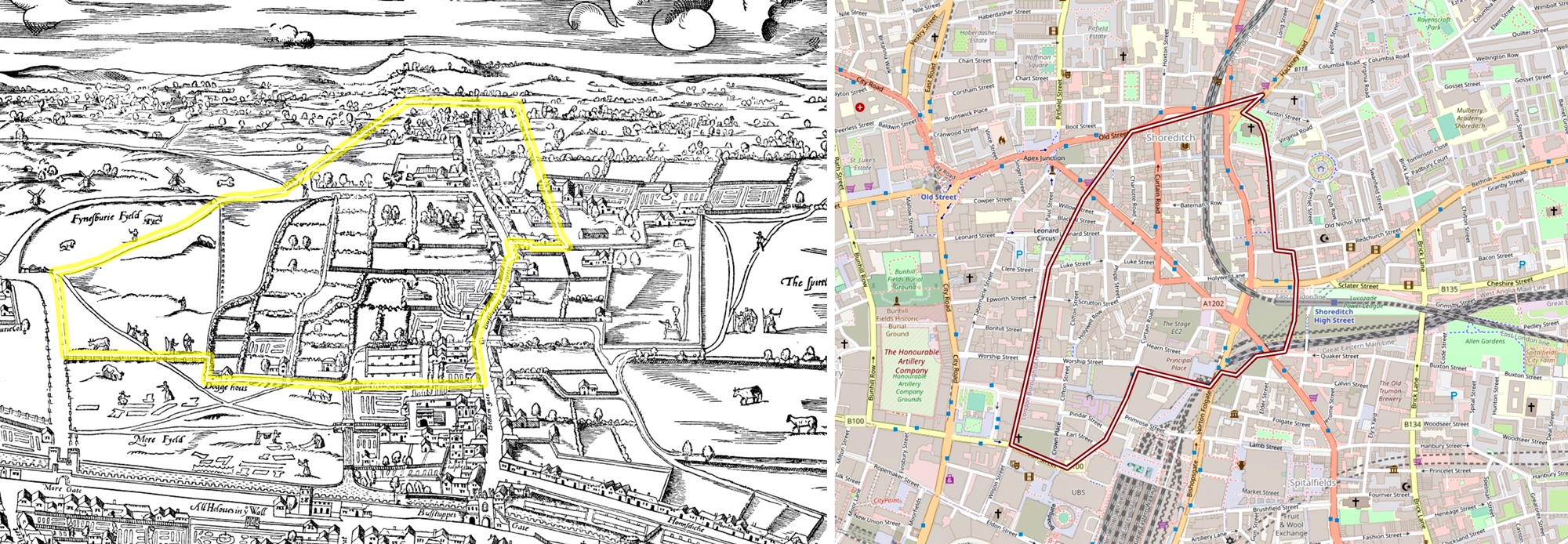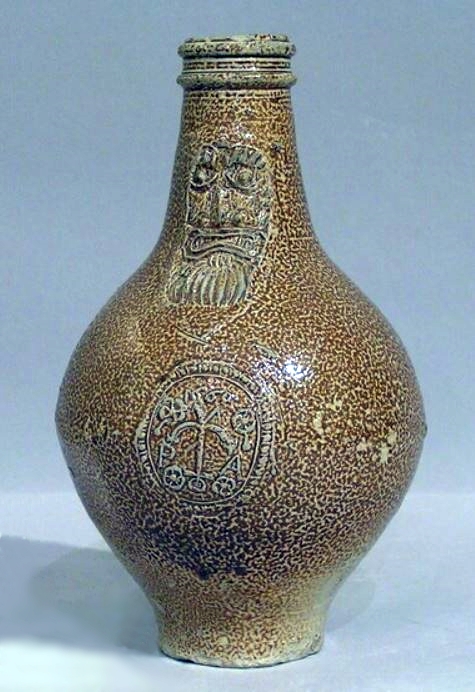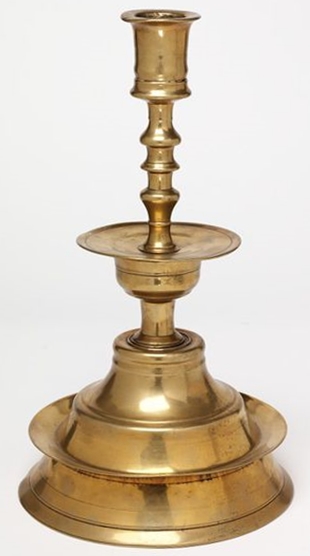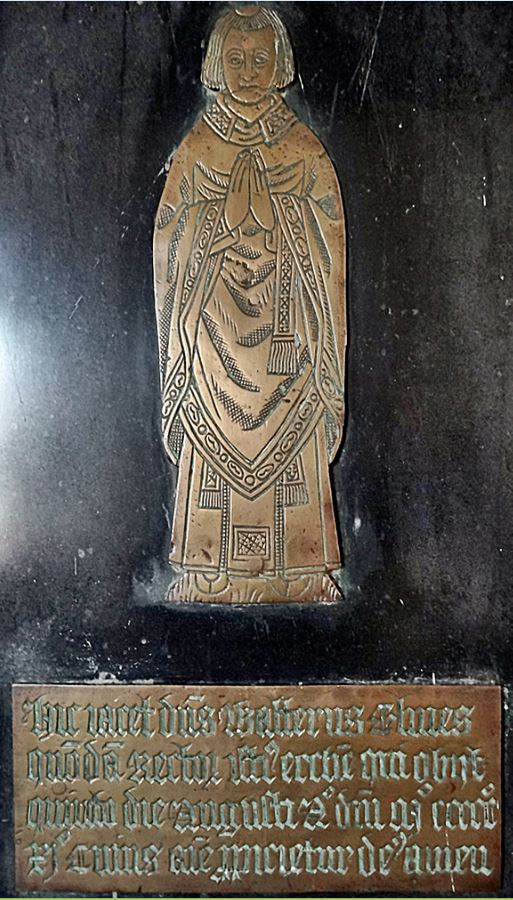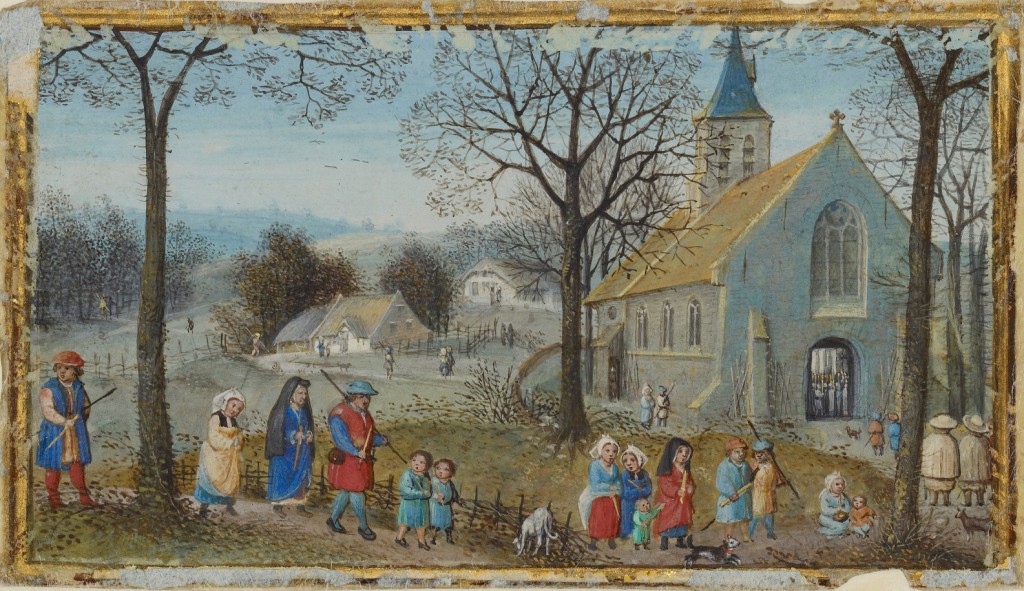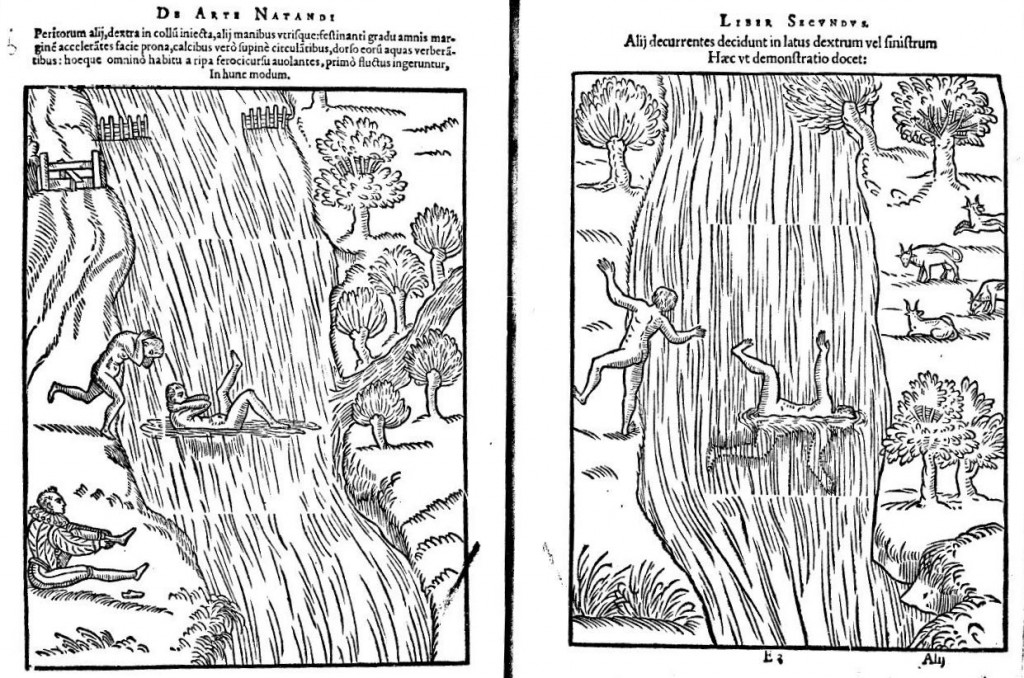x
Archive of the ‘discoveries of the month’ from the project
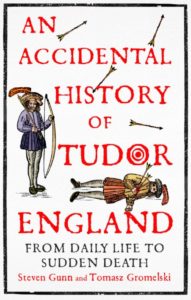 June 2025. In the first great age of print, books could be fatally absorbing. On 13 May 1553, at Maisemore in Gloucestershire, John Carpynter junior was deep in a book. Unfortunately, he was also too near an elm tree as William Elrundge was cutting off branches. One branch hit John on the right side of the head, and he died four days later. If anything, eight-year-old Susan Wigmore was even more inattentive. At Langley, Norfolk, on 6 March 1562, she came out of the house of Giles Fenne, gentleman, who was married to her aunt. She walked a few dozen yards to a fishpond or ‘stue’ with a book in her right hand. She was presumably concentrating too hard on the book as she fell – negligently, said the jurors – into the pond and drowned.
June 2025. In the first great age of print, books could be fatally absorbing. On 13 May 1553, at Maisemore in Gloucestershire, John Carpynter junior was deep in a book. Unfortunately, he was also too near an elm tree as William Elrundge was cutting off branches. One branch hit John on the right side of the head, and he died four days later. If anything, eight-year-old Susan Wigmore was even more inattentive. At Langley, Norfolk, on 6 March 1562, she came out of the house of Giles Fenne, gentleman, who was married to her aunt. She walked a few dozen yards to a fishpond or ‘stue’ with a book in her right hand. She was presumably concentrating too hard on the book as she fell – negligently, said the jurors – into the pond and drowned.
We hope our book, published this month as An Accidental History of Tudor England. From Daily Life to Sudden Death will be a fascinating read, though we trust it will not be dangerously so. Together with the book we are making available the spreadsheet of data on which it and our discoveries of the month have been based. We hope that readers of this column will enjoy as much as we have an exploration of the many and varied windows into Tudor life that accidents provide.
May 2025. Watermills were dangerous not only because of their fast-flowing millstreams and their fast-running machinery, but also because of the landscape engineering necessary to channel water to their wheels. At Stoke Mill in Bletsoe, Bedfordshire, at 8 in the morning on 18 May 1579, repairs brought calamity. Silvester Goore, a labourer from neighbouring Sharnbrook, and Mary Wright, a spinster from Radwell in Felmersham, the next village up the River Great Ouse, were working together. They were on the ‘bakewater’ next to the ‘milldamme’, in a boat belonging to the miller, Thomas Walton. It was loaded with ‘ramming claye’ to mend the breach through which the water flowed from the river towards the mill. The water was running so strongly that it burst out through the breach and swamped the boat. Both were drowned.
April 2025. Cattle were valuable in Tudor England, so it was important to keep them healthy. William Couper, a husbandman of Glatton, Huntingdonshire, had an ox with the barbs, an inflammation of the membrane under its tongue. On 16 April 1530, at 4 in the afternoon, he took remedial action with the help of his farming neighbours. Oliver Johnson held the ox by the head and Alice Leverche, wife of John, was standing by as William approached with a pair of tongs. He planned to cut out the inflamed flesh, as cattle care handbooks advised. The ox declined treatment. It knocked William to the floor so that he dropped the tongs and then gave Oliver a wound under his left arm from which he died three weeks later.
March 2025. The small-scale trade that tied together households all over sixteenth-century England can be hard to reconstruct. Mostly it went in and out of market towns, its agents might be men, women or young household servants, and its commodities were miscellaneous and dependent on the priorities of the local economy. James Nubee was 14 when he set out to ride from Bury St Edmunds to Lavenham on the evening of 20 March 1555. He was a servant of Roger Tryppe, probably one of the prosperous Tryppe family of Lavenham cloth entrepreneurs, and he was riding his mater’s gelding. On the horse he carried four cheeses, presumably bought in Bury, and a large bundle of woollen yarn, 40 lb (18 kilos) of it, presumably to supply Roger’s weaving business. By 8 p.m. he had reached Cockfield, two-thirds of the way home, but the light must have been fading. The horse stumbled into a hole and James fell under horse and load and was crushed. It is testimony to the economic weight of England’s cloth industry that when the various items involved were valued for forfeiture, the horse was worth 13s 4d but the three-stone bundle of yarn was worth 20s.
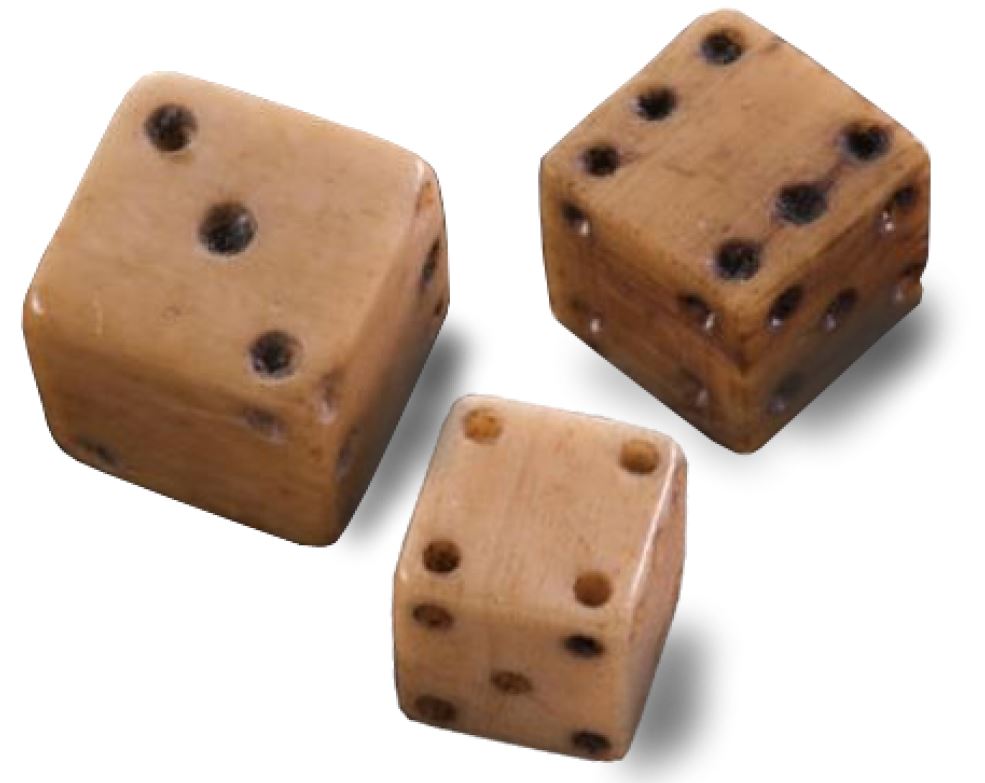
Bone dice recovered from Henry VIII’s ship the Mary Rose, which sunk in July 1545.
February 2025. Gambling disputes – often, no doubt, over accusations of cheating – produced knife fights in Tudor England just as they produced shoot-outs in the Wild West. Late in the evening, between 9 and 10, on 23 February 1556, the game was on in Bedford, at the northern end of the great bridge over the Ouse. Six craftsmen and tradesmen were playing dice, among them an innkeeper, a glover, a shoemaker and a tiler. John Clapham argued with Thomas Philips, the tiler, and snatched off his woollen hat. Philips fought to get it back and Clapham drew his dagger, more substantial and more expensive than an ordinary eating knife. In stabbing at Philips, Clapham cut his own left leg below the knee. Was his lack of coordination due to drink? The wound, two and a half inches long, a quarter of an inch wide and half an inch deep, must have gone through significant blood vessels, for inside two hours John Clapham had bled to death.
January 2025. Most buildings in Tudor England were timber-framed. One advantage of this construction system was that elements could be prefabricated and then joined to standing buildings. We can glimpse the process in action at Greet, then in Worcestershire, on 2 January 1553. John Byssyll was extending the ‘kytchyn’ of his house. Having assembled the new structure, he was moving it into place on ‘rollers’, working with Roger Carpenter, John Byddell, Richard Botter, Richard Pretty and others. As they dragged the frame, a piece of timber fell off it and landed on Richard Pretty’s head and body. It was probably a minor element – it was worth 4d when the whole new frame was worth forty times that – but it was big enough to kill him instantly.
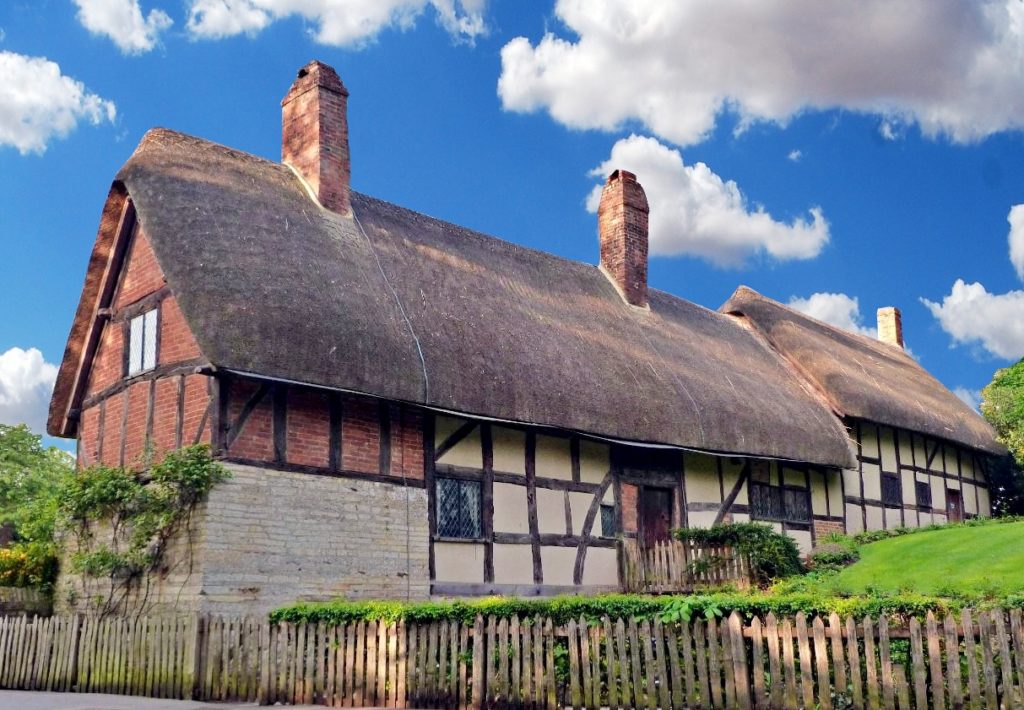
The timber-framed cottage of Anne Hathaway, Shakespeare’s wife, Stratford-upon-Avon.
December 2024. Keeping livestock fed through the winter months demanded hay and lots of it, safely stored and regularly retrieved. In his house at Middlezoy in the Somerset Levels, John West had a ‘haitellet’ or hay-loft. On 11 December 1584 he was climbing into it to get hay for his animals, using not a ladder but a propped-up ‘herdelgate’ of wattle. His feet slipped and he slid down the gate, one of its stakes running into his belly six inches deep and two inches wide. Two days later he was dead from his wounds and the offending gate, worth 3d, had been taken into custody by his neighbours.
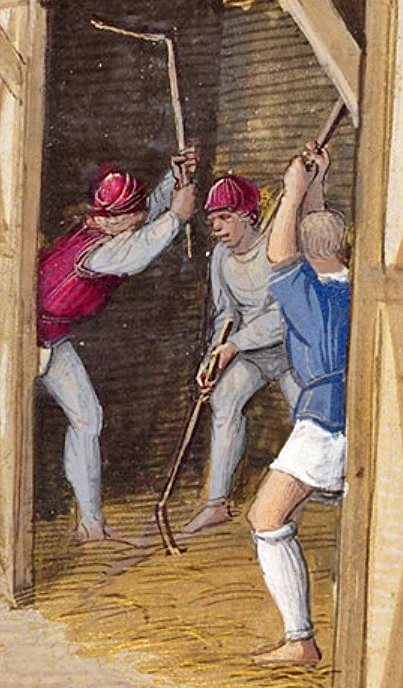
Thrashing grain in a barn. Illumination from ‘Hours of Henry VIII’ (c. 1500), The Morgan Library & Museum, MS H.8, fol. 4r.
November 2024. Thomas Tusser’s agricultural handbook Five Hundreth Points of Good Husbandry recommended November as a prime month for threshing the grain collected in the summer’s harvest. He warned of the danger that a reckless thresher might hit a cow when swinging the flail, two sticks connected by a leather joint, to beat the seed out of the straw and chaff. But even he did not reckon on the lack of coordination shown by Richard Rogers. Rogers was a servant of John Banester, a yeoman farmer of Hazleton, Gloucestershire. On 22 November 1573 he was threshing grain with another of Banester’s servants, John Jobborne. Somehow he hit himself in the head with the flail, giving himself a wound under his right ear, and three days later he was dead.
October 2024. Salt was indispensable for preserving and flavouring food but can be hard to track through the economy. It was extracted at saline springs like those of Droitwich and Nantwich and in coastal salt-pans; it was imported as ‘bay salt’ from south-west France; but it had to be distributed all over England, and for such a bulky load water transport was preferable. On 24 October 1576, William Milburye duly found himself among the crew of a boat loaded with salt. They were travelling on what the jurors called the Bridgwater River, the Parrett, a major artery leading from the Bristol Channel into the heart of Somerset. The salt was heading inland from Combwich towards Bridgwater, though whether it had originally come to Combwich down the Severn from Worcestershire or up the Bristol Channel from France we do not know. At 5 in the morning, between Cannington Pill, the stream flowing into the Parrett from Cannington, and Down End, a village by the East bank of the river, a storm hit the boat. It was swamped and William drowned, but his crew-mates presumably got away to tell the tale.
September 2024. The different landscapes of Tudor England offered different ways of making a living. Many of our coastal marshes have now been drained, but then much of the East coast was fringed with saltmarsh. It could be treacherous underfoot and it flooded fast, but it provided good grazing for sheep and cattle and distinctive vegetation. Reeds and rushes could be platted into mats for flooring, soaked in tallow to make rushlight candles or burnt under ships to soften the pitch with which they were caulked. Gathering them was a good way to supplement household income. On the afternoon of 15 September 1573 Rachel Kinge, 20-year-old-daughter of Thomas Kinge, was cutting rushes in Horsham Marsh at Upchurch in Kent, near the meeting-point of Medway and Thames. Surprised by the speed of the rising tide, she tried to make her way onto a bank. On the way she fell into a ditch, where her father found her drowned.
August 2024. Some accidents shed a sudden shaft of light on a situation but leave many questions unanswered. On 12 August 1532 a cart drawn by five horses overturned at Campsall in Yorkshire, some 8 miles north of Doncaster, perhaps on or near the Great North Road. It was carrying seven of King Henry VIII’s hunting hounds, fine animals together worth a total of £4, the cost of a high-quality horse. The driver, killed in the crash, was a labourer based at Woking in Surrey, a royal house often visited by the king on his hunting tours, and after the crash the hounds were taken into custody by Robert Shere, also of Woking.
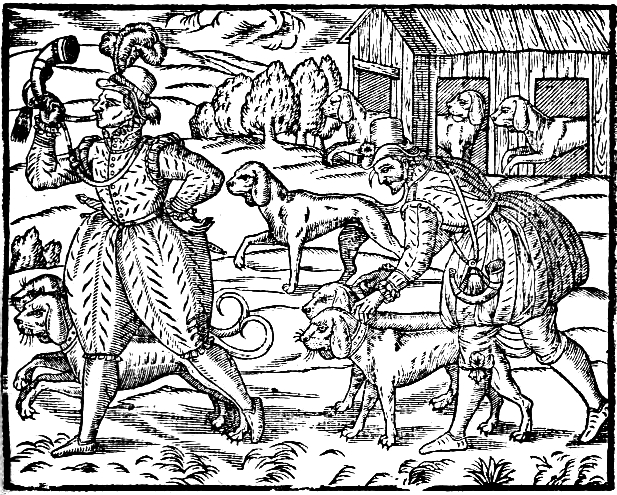
Royal kennels. Woodcut in George Gascoigne, The noble arte of venerie or hunting (1575), title page.
These two men take us deeper into the court of the 1530s. The driver was called Urian Trigg, sharing an unusual name with the Cheshire courtier Urian Brereton. Had some Cheshire connection been his route into royal service? Robert Shere was a servant of Francis Weston, lately the king’s page and now a gentleman of his privy chamber. Was Weston, who gambled and played tennis at court, also involved in the royal hunting establishment? If so, his role would end in 1536 when he lost his life as one of the alleged lovers of Queen Anne Boleyn, together with Urian Brereton’s brother William. And the hounds were nowhere near the king, who was in Oxfordshire. Were they perhaps on their way as a gift to his nephew the king of Scots – the two countries were teetering on the edge of war – or to one of the northern nobles whom Henry would need to mind the border while he travelled to Calais that autumn to meet King Francis I of France?
July 2024. Pranks can enliven the dullest working day, but occasionally they misfire. At 10 in the morning on 15 July 1549, at Rowde in Wiltshire, William Byrde was shoeing a horse. His neighbour Walter Barnarde – they were both small farmers in the village – decided to have a joke with him. As William was busy with the horse, holding its foot in his hand, Walter threw some dust down the back of his neck. William instantly kicked dust back at Walter. Unintentionally he kicked with it a tool lying behind him, a blacksmith’s buttress used to trim horses’ hooves. The buttress hit Walter on a vein in his leg, near the heel, and began an unstoppable flow of blood. Seven hours later, jesting Walter was dead.
June 2024. Working with animals always has an edge of unpredictability, especially when animals interact. At Hastingleigh in Kent on 18 June 1583, Thomas Everenden was driving a dung cart between the house of his master, Christopher Bellyng, yeoman, and the fields. As the cart was empty, he was riding on it. The draught team of two oxen and a mare suddenly pulled the cart off in the wrong direction and Thomas leapt out to avoid a crash, only for the left wheel to run over his head and kill him instantly. The cause of the animals’ panic, explained the jurors, was a maddening attack by biting flies, or ‘bremps’.
May 2024. Play can get rough, especially between boys. At Over Whitacre in Warwickshire on 18 May 1598, 11-year-old Anthony Dyvett was playing, or so the jurors chose to describe it, with 7-year-old Edward Lunkeslow, hitting him with his ‘leather Sachell’, perhaps a school bag. The satchel contained an unsheathed knife which cut through the satchel and into Edward’s abdomen, 3 inches deep, and Edward died next day.
April 2024. Country walking after rain can be a muddy business, but in the sixteenth century mud could be lethal. On 13 April 1586, Peter Cowles set out to walk the three miles from Sandhurst to Gloucester, but wandered off the certain road, as the jurors put it, into a muddy lane called ‘Bearde lane in Sandhurst’. He fell into the earth and mud there and struggled to get out. Late in the evening he managed to scramble into a field on the north side of the lane called ‘Newclose’, but around 11 at night he died there from cold and exhaustion.
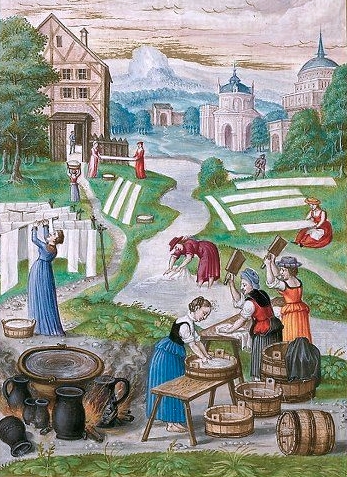
Women doing laundry. Illustration from Splendor Solis (1582), British Library, Harley 3469, fol. 32v. Click to enlarge.
March 2024. Laundry was one of the household tasks that exposed women regularly to the risk of drowning. Usually, it was a matter of a simple slip into a river or pond, but sometimes accidents were more complex. Alice Malyne, widow, was doing the washing at Earith, Huntingdonshire, on 19 March 1576. To make it easier to carry a very large linen sheet – the jurors reckoned it was about 11 feet long – she pinned it round her shoulders. As she walked between the ponds in the yard by her house, there was a sudden windstorm and the sheet got entangled round her head. Temporarily ‘blyndfelde’, as the jurors put it, she stumbled into one of the ponds and drowned.
February 2024. While concerted building throughout the middle ages had provided England with an impressive network of bridges, many rivers and streams were still best crossed by fords. They were used by pedestrians, riders and cart drivers, but in winter’s winds and floods they could be treacherous. On 21 February 1596, William Erigs met characteristic difficulties. He was taking the cart of his master, John Bayes of Tempsford, Bedfordshire, husbandman, across the Great Ouse at Tempsford Ford. He rode on the back of the front horse in the team of horses drawing the cart, presumably to keep his feet dry. It was 7 in the morning and it may not have been easy to judge the state of the river. The strong current dragged at the horse and its harness, turning them round and sweeping William into the water, where he drowned.
January 2024. Hawking was a more flexible form of hunting for the Tudor elite than the pursuit of deer. It could be practised alone, and hawks could take a variety of game, from rabbits to partridges. Thomas Samborne was fortunate to have a goshawk, an effective woodland hunter of which numbers had to be imported because the domestic population was too small to meet the demand for birds that could be trained. At Send in Surrey on 5 January 1516 he was trying to build a ‘perche’ for his bird by cutting down a small oak with his ‘Wodknyffe’, a substantial hunter’s tool. Halfway through the task, he threw the wood-knife aside. It landed on the ground point upwards. As he pulled the oak downwards, the rotten branch he was holding snapped and he fell. He landed on the wood-knife and wounded himself 20 inches deep, from his thigh through to his stomach, dying unsurprisingly fast.
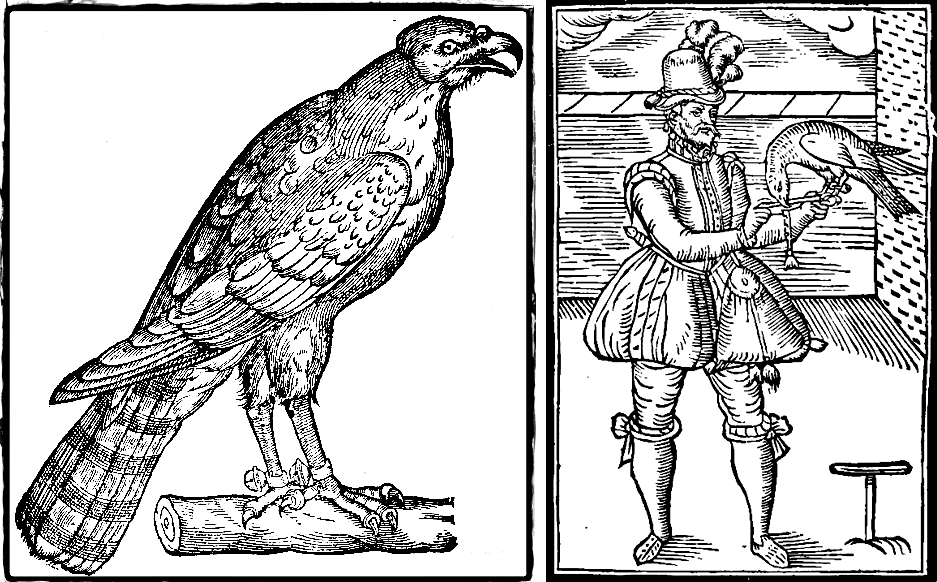
The goshawk and a falconer. Woodcut illustrations from George Tuberville’s Book of Falconry or Hawking (1575), p. 58 and 75.
December 2023. Tudor courtship can be reconstructed from various angles, from letters, romantic literature and church court cases about who was really married and who was not. Fatal accidents rarely shed light on it, but when they do, the events they describe combined the mundane with the dramatic. At Holwell in Somerset on 14 December 1565, Jerome Snouke, a household servant, spotted Grace Wyseman, a young woman towards whom, as the jurors recorded, he felt an ardent desire of marriage. He ran fast towards her to give her a kiss. Grace was holding a willow rod in her right hand and, against her will, it poked him in the left eye. He died four days later from a wound to the eye one inch deep and one inch wide.
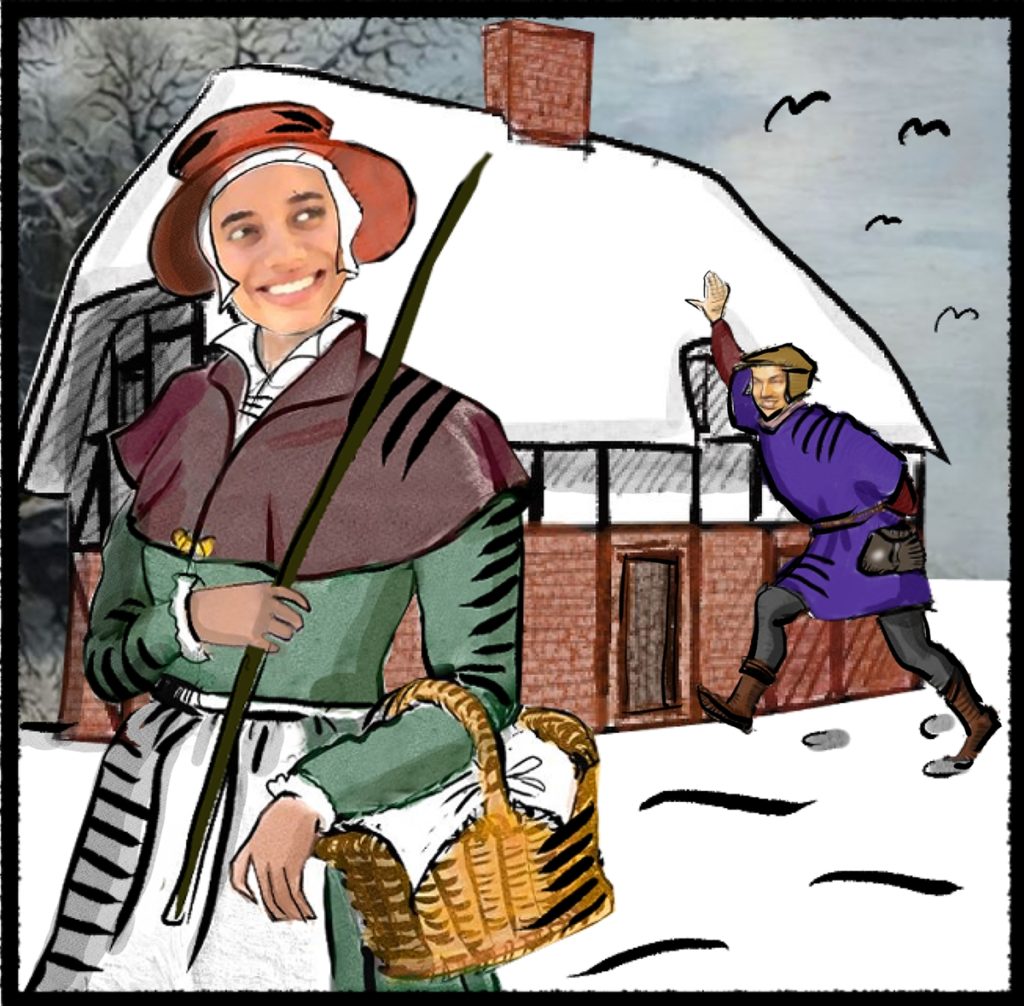
Grace Wyseman pursued by Jerome Snouke. One of the images from the freshly released Accidental Tudor Deaths TOP TRUMPS card game. Click to find out more!
November 2023. Accidents often show us the practical problems of working life, but glimpses of social life at work are rarer. At Staplehurst in the Weald of Kent on 30 November 1525, James Kyng and William Fermor were in a ‘Workhouse’ belonging to William Scranton. The Weald was a centre of the cloth industry and William was presumably an ancestor of the Thomas Scranton who was operating as a cloth-manufacturer at Staplehurst in the next generation. James and William were sitting by the fire eating bread, cheese and other food for breakfast. They were larking about and James playfully nudged, or perhaps barged, William with his shoulder. In his left hand, William held the knife for cutting his food and James’s nudge pushed it into James’s left thigh. It went in half an inch deep, presumably severing an artery, and James rapidly died.
October 2023. Ferry boats, sometimes called passage boats or passing boats, were necessary for crossing many rivers too deep to ford or too wide to bridge. One persistent cause of capsizes was the presence of restless animals. The jurors at Saint Dominick in Cornwall described one such mishap in vivid detail. On 18 October 1595, at about 8 in the morning, Richard Cornishe was in a ‘passing Bote’ on the River Tamar below Halton chapel, in the liberty of the town of Saltash. Also on board was an ox. The ox was restrained, ‘tyed by his hynder legges’, but resolved on ‘leapinge out of the said Bote’, such that ‘the rest of his bodie fallinge over the said Bote into the said River of Tamer’ caused the boat to sink and Richard drowned.
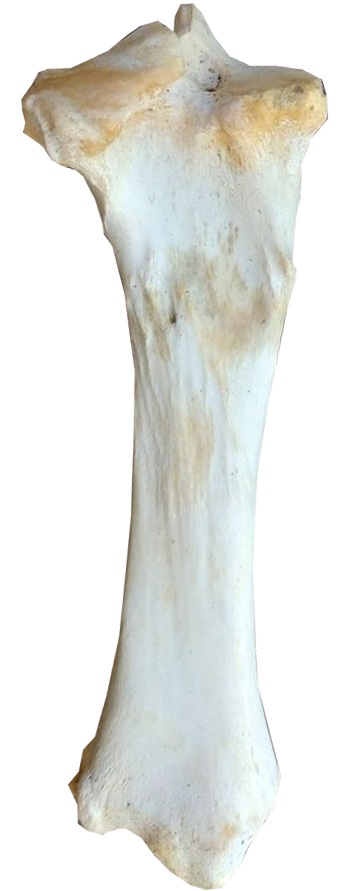
This horse leg bone is nearly 50 cm or 20 inches long – large and heavy enough to use for throwing in lieu of a hammer.
September 2023. As we have seen before, football was the great winter sport of Tudor England, throwing the hammer the great – or at least the most dangerous – summer sport. But what could one throw if there were no sledge-hammers to hand? At East Witton in Wensleydale on 1 September 1532, a group of young men and boys had an answer. They were playing on a Sunday afternoon at 5 pm, a classic time for sport, throwing the leg bone of a horse. Robert Asvyth, a labourer from the neighbouring village of Jervaulx with its great Cistercian abbey, let fly with his right hand. The bone hit Henry Pacok on the left side of the head and three days later Henry expired.
August 2023. August, at the height of harvest, was a prime time for loading and unloading carts. One key element was the cart rope with which loads were tied down. At Ilchester in Somerset on 25 August 1584, William Hodges, senior, was working with his servant Pancras Savage in a field called ‘Footes meade’, a name that survived into the nineteenth century. They were loading a cart with barley, and, as the jurors put it, tying a rope around the grain as is the habit of the countryside. They tied a knot in one end of the rope and fixed it to the cart. Then William stood on the ground and Pancras, presumably younger and more agile, on the cart. William threw the rope up onto the cart and they each pulled it tight. But as they pulled, the knot slipped off the cart and Pancras fell to the ground, breaking his neck and dying two days later. Similar accidents add other details – ropes that broke, others that came off the ‘cart pynn’ or ‘naile’ to which they were fastened, loaders who fell backwards head-first 8 feet from a cart or landed on a ‘a flynt stone’ such that their brains came out – that show just why securing cart loads was such a hazardous business.
July 2023. Sixteenth-century critics of monks – often of course spurred on by a desire to close their monasteries and confiscate their lands – might accuse them of any of the deadly sins. Gluttony, strictly warned against by monastic founders such as St Benedict, was a particularly frequent charge. We might wonder if the inquest jurors or others who heard of his fate levelled it at poor John Emere. He was a monk at Sawtry Abbey, a Cistercian house in Huntingdonshire. On 18 July 1528 he fell to an instant death, having climbed into the roof of the abbey church in search of pigeons. Perhaps, of course, the birds were not to enliven the fare at the refectory table, but to equip the abbey’s guest house, much frequented by travellers on the nearby Great North Road.
June 2023. Coroner’s inquest reports often report both the date and time of the victim’s death and the date and time of the incident that caused it. We can use this to work out how rapidly different kinds of injuries proved fatal. One horribly lingering category of deaths was that caused by burns and scalds. Only a quarter of those who died as a result of them expired more or less immediately, compared, for example, to nearly nine in ten of those with broken necks. One in five died later on the same day, a quarter on the following day, and three in ten lasted until two or more days later. The cause was often hot wort used in brewing ale or beer. On 19 June 1570, at Great Braxted in Essex, Clemency Coxe, servant of Brian Darcy esquire, was pouring water from a ‘cowle’ or tub into a brewing copper. Her feet slipped and she fell backwards into a mashing vat full of hot water. Her body was scalded all over except for her head and feet, but she did not die until eleven days later, at noon on 30 June.
May 2023. One of the many perilous tasks of Tudor agriculture was the spreading of marl on the fields. Marl, a mixture of clay and chalk, was added to light or sandy soils to improve their fertility, above all in the chalky counties, from Dorset and Hampshire through Berkshire and Hertfordshire to Bedfordshire and Norfolk, but also beyond. Early summer from May to July was the prime time for marling. It was rarely the spreading that was the problem, it was the excavation. Marl pits had an alarming tendency to cave in as they grew deeper or their sides more undercut. One collapse came on 27 May 1554, in a pit in the fields at Carr, near Rotherham in Yorkshire. Two labourers, William Ledebeter of Carr and William Warren of Slade Hooton, were digging with a husbandman, Roger Cosyn of Newhall. At 6 in the evening, the earth around the pit collapsed and killed all three.
April 2023. Many of the heavy industries of later centuries were expanding in sixteenth-century England, often inspired by foreign expertise. The first iron-slitting mill on this side of the Channel appears to have been set up by Godfrey Box, an entrepreneur from Liège, at Dartford in Kent in around 1590, processing iron from the growing Wealden smelting industry. On 3 April 1600 an inquest at Dartford heard how one of Box’s servants, Anthony Vahey, had met his end on 30 March. At 2 in the afternoon in the ‘myll fielde’, presumably by Box’s mill, Vahey had given a drink to Thomas Edwardes. Edwardes was a servant of Robert Kettell, a Dartford yeoman. He was driving a cart pulled by four geldings and loaded with various pieces of iron, heading form Dartford to Box’s ‘Iron myll howse’. Edwardes had too much of the drink and drunkenly hit one of the horses with a stick so hard that it left the road and pulled the cart up a hill in the field, overturning it. In the crash an iron bar hit Anthony in the head and two other pieces hit his left arm, killing him at once.

Different breeds of dogs. Illustration in Jacob Meydenbach, Hortus sanitatis (Mainz, 1491), Wellcome Collection, London, 5.e.12. Click to view the full page.
March 2023. Sixteenth-century guard dogs were meant to be fierce, but when they got out of control the results could be horrific. At 4 in the afternoon on Sunday 1 March 1562, Edmund Pryckett was at evening prayer with the members of his household in Bungay church, Suffolk. They had left behind one 16-year-old maidservant, Elizabeth Sprat, but she, it seems, was oblivious to the bloody drama unfolding in the yard by Edmund’s house. Edmund was a tanner. Stockpiled in the yard he had hides and tanner’s bark, the acidic oak bark used to tan the hides into leather. Perhaps knowing that the master and most of his servants were away, twelve-year-old Andrew Dedynham got into the yard, aiming to steal some of the bark. He had not reckoned with Edmund’s three guard dogs, who fastened on him, biting him in the head and under the arms. He died two days later.
February 2023. Excavations at the London theatres of Shakespeare’s day have shown how enthusiastically playgoers guzzled oysters and threw away the shells. They were kept supplied by the oyster fisheries of the Thames estuary. At Gillingham on 5 February 1566 the costs of the trade became clear. That morning Richard Wood took his two sons, Thomas and Edward, out in his small boat, a ‘dredging cock’, to dredge for the shellfish. They were on one of the salt creeks of the Medway marshes, Bartlett Creek, to the east of the town. By 11 they had filled the boat with oysters and were heading back towards the bank, but the wind got up. The boat filled with water and they all fell out. With the help of two other fishermen, Edward Geere and John Grygg – and, the jurors reverently added, by the favour of God – Richard and Edward made it to safety, but Thomas drowned.
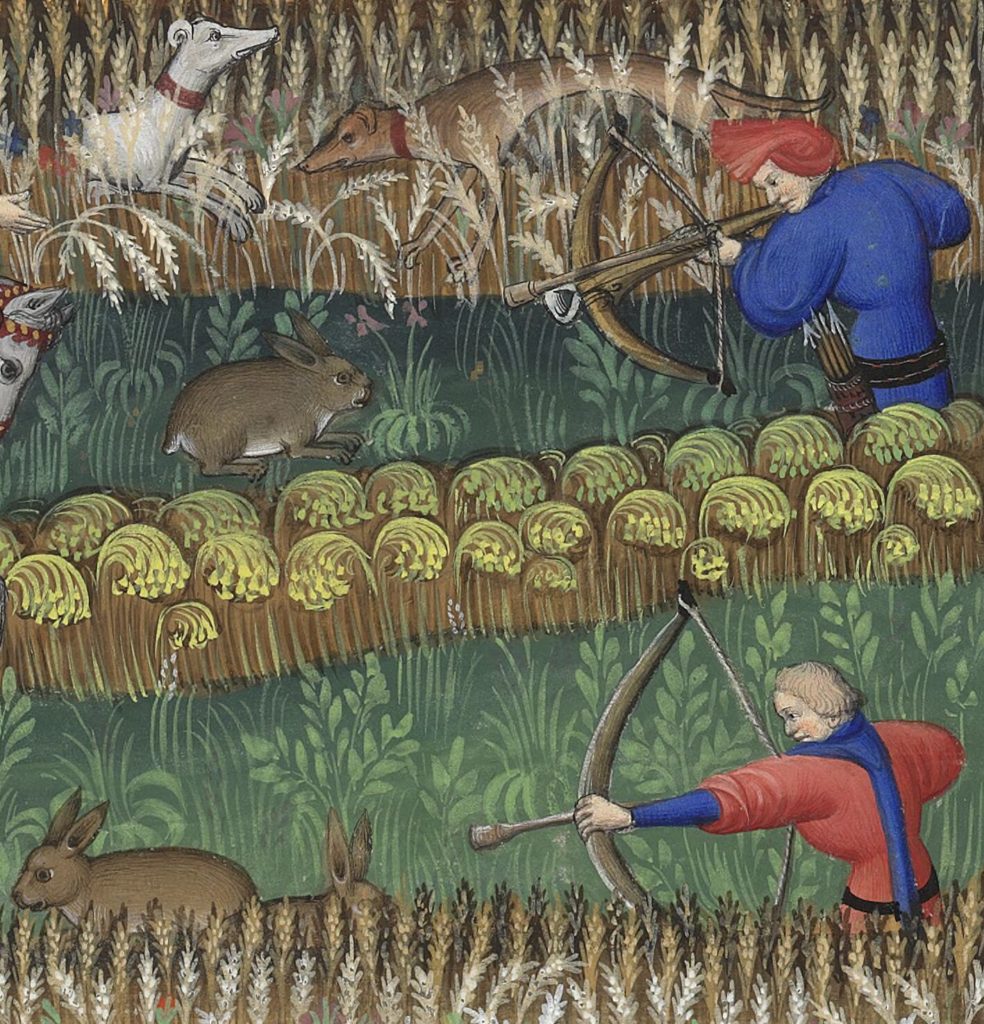
Hare hunting with a crossbow and a bow. Detail from a miniature in Gaston Phébus’s Livre de la chasse (c. 1410), Bibliothèque Nationale de France, Français 616, fol. 118r. Click to enlarge.
January 2023. Rabbits were valued, indeed farmed, in Tudor times not only for their meat but also for their fur. They were a prime target for hunters and poachers. On 25 January 1515 at Musbury in Devon, John Frankecheyny and Richard Smith of Axminster thought they had one cornered in a hedge as they stood on either side of it. John encouraged Richard to shoot, but Richard’s arrow missed the rabbit, ricocheted off a branch of the hedge and hit John in the face, presumably at close range. Stunned, John fell into a ditch and suffered injuries from which he died six days later.
December 2022. It is rare for buildings in which sixteenth-century accidents occurred to have survived to the present day. One which has, at least in part, is the Bedern at York. The Bedern was the home of the succentor and vicars choral of the cathedral, who sang in York Minster’s services. It was in the kitchen attached to the hall that a young man, Oswald Gylfeld, a servant of the succentor and vicars, was at work at 11 in the morning on 17 December 1565. Part of a brick chimney in the kitchen – a fashionable and efficient but sometimes unstable aid to cooking – suddenly fell on him. He was instantly killed.
November 2022. Provision for the poor in Tudor England ranged from the traditional – individual charity to neighbours, endowed almshouses – through the innovative – parish poor rates and apprenticeship schemes – to the brutal, slavery for vagrants under a short-lived act of 1547. Workhouses, or bridewells as they were called after the former royal palace in London where the first was established, were at the more repressive end of the spectrum. There the apparently workshy or reprobate were confined and set to work. Mabel Ockford was presumably an inmate of the ‘Bridwell’ at Gloucester, which may already have been housed in the city’s East Gate, when she was at work there at 3 in the afternoon on 4 November 1589. She was driving the horse that powered a ‘mault mill’ to grind up barley for brewing when she fell between the beam of the mill and the wall of the building and was crushed to death.
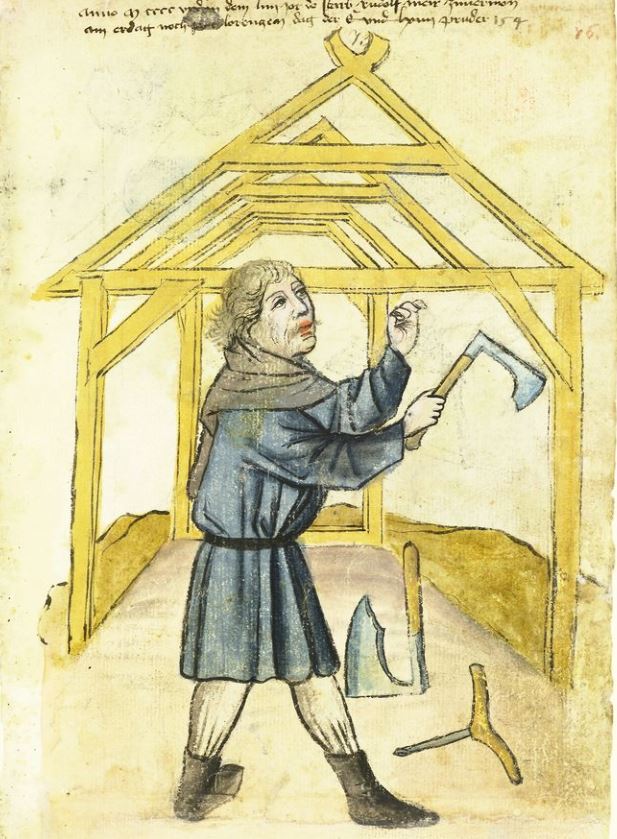
Building a timber-framed house. Illustration in the ‘Hausbuch der Mendelschen Zwöflbrüderstiftung’ (1426-1549), Stadtbibliothek Nürnberg, Amb. 317.2°, fol. 76r. Click to enlarge.
October 2022. Construction in Tudor England was a professional job for carpenters and masons, but timber-framed buildings in particular were also suitable for DIY. William Turnor of Eastwood, Essex, yeoman, was repairing his house on 20 October 1586 when disaster struck. His wife, Mary, was helping him erect a timber beam by supporting it on a two-pronged pitchfork. The beam must have been quite substantial, as it was worth 2 shillings, several days’ wages for a labourer. It slipped off the fork, knocking her backwards to the ground and crushing her head, so that she died instantly.
September 2022. Walking to church and back could be a sociable time in Tudor England. At Kingsnorth in Kent on Sunday 22 September 1566, morning prayer had finished by 11 o’clock and William Cloke was heading home to the house of his master William Chalcroft. He was described as a labourer, so was probably a young live-in farmworker. He was presumably a local boy, for among the jurors who sat at his inquest were Michael Cloke, John Cloke senior, John Cloke junior and Robert Cloke. Among his companions was Michael Colbrand and they were larking about, or as the jurors put it, playing together in game and sport. William suddenly jumped onto Michael’s back and they both fell over. The knife hanging at William’s belt had a broken sheath and as he fell it poked through and went an inch and a half deep into his left thigh. It must have hit an artery as he died at once.
August 2022. Fields at harvest time were full not only of activity but of obstacles for the unwary. At 10 in the morning on 25 August 1585, John Padmore and his servant were driving his cart from a meadow called ‘the Snappe’ to the village of Cheswardine in Shropshire, carrying ‘a lode of haye’. The four oxen drawing the cart came down ‘Cheswardyn bank’ and straight through some sheaves of wheat left lying on the ground. John went to clear the wheat out of the way and pull out one sheaf that had caught under the cartwheel. As he tugged, the wheel fell on his leg and broke it. He made it home but died five days later, leaving the cart and the hay in the hands of his widow Joan.
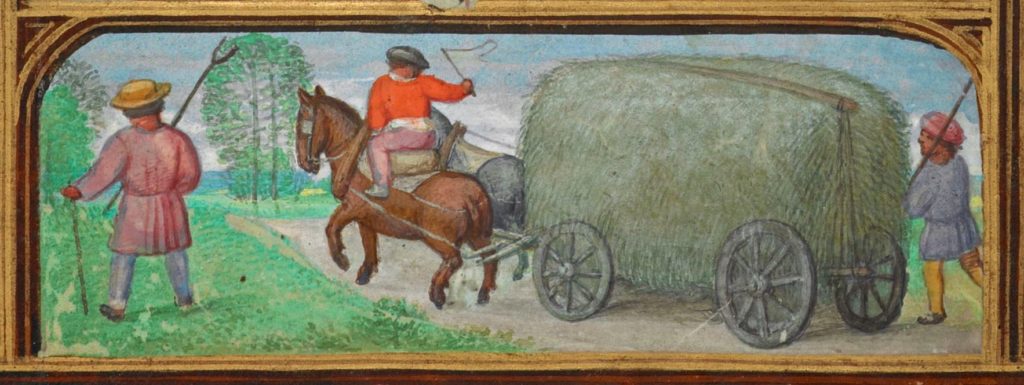
A hay cart. Simon Bening’s illumination in the ‘Golf Book of Hours’ (c. 1530), The British Library, Add MS 24098, fol. 25r. Click to enlarge.
July 2022. The county gentry were key figures in Tudor society and government. They linked local communities to the centre through hospitality and office-holding, though some were resented for harsh landlordship. Thomas Guldeford esquire, of Hemsted House, Benenden, Kent, was an obscure member of a declining family; if indeed he existed at all, and was not a slip of the pen for Henry Guldeford esquire, the adolescent heir of the late Sir Thomas Guldeford. Yet he seems to have been popular, to judge from events on 10 July 1587. On that day he was returning home after a long absence. A crowd of his neighbours, led by Walter Everenden of Benenden, yeoman, and Richard Reve of Cranbrook, cutler, made surprise plans to celebrate his homecoming. In a joyful mood, they laid along the road to the house a line of gun chambers loaded with gunpowder and paper, together with a train of powder to set them all off in salute. Walter and Richard then left the scene for half an hour, during which time an unknown person set light to the train of powder. The chambers went off with a great noise and such force that pieces of broken iron and a splintered wooden peg flew about. Hugh Jull, a Benenden labourer, who was standing waiting to enjoy the spectacle, was hit. The iron lacerated the flesh, veins and bone of his right leg between knee and foot and two weeks later, at his home in Benenden, he died.
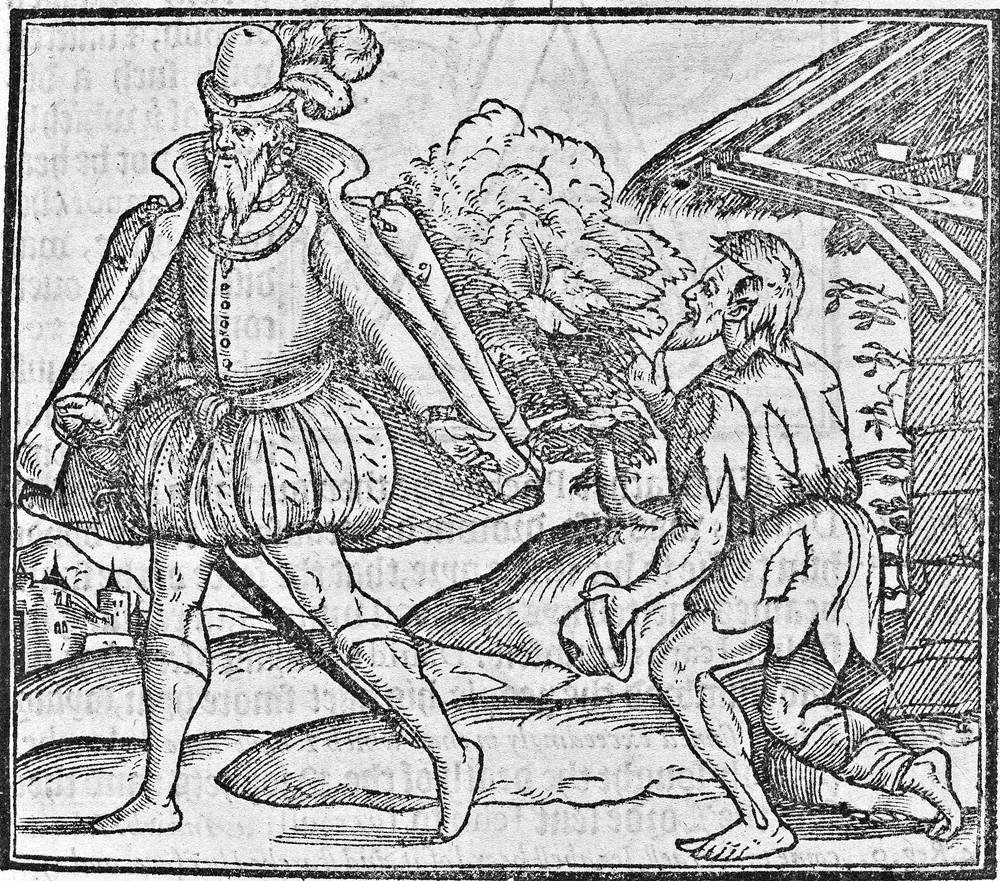
A gentleman giving alms to a beggar. Woodcut in Stephen Bateman, A christall glasse of Christian reformation : wherein the godly maye beholde the coloured abuses vsed in this our present tyme (1569), p. 63.
June 2022. Ploughmen and carters in different parts of England generally chose horses or oxen as draught animals depending on the heaviness of the local soil. Surprisingly often, however, they combined both. In June 1552, for example, John Bott of Bevington in Warwickshire, husbandman, and Robert Glaspole, far away in Hampshire, met their ends driving mixed teams. John was sitting on a cart laden with a quarter and a half of malt, drawn by six oxen and two horses, when he fell asleep on the road between Banbury and Hardwick. He fell from the cart and his servant Maurice Shawe shouted at the animals to stop them, but it was too late and the cart ran over a molehill and crushed John’s body. Robert was walking by his cart loaded with wood and pulled by two young oxen and four horses as it came down a hill on Colden Common. His feet slipped, he fell and was run over by the left wheel, breaking his back and wounding his kidneys. Injured at 11 in the morning, he died at 4 in the afternoon. Whether there were advantages in mixing animals in this way, or whether people just assembled whatever teams they could, is an interesting question.
May 2022. In the warmth of late spring, Tudor Londoners headed into the surrounding villages. On Saturday 22 May 1568, John Willyamson went a mile out of the city to Shoreditch, with John Ryvers, Philip Pynchebeake, James Kenryicke and Ralph Boscocke. They were looking for birds’ nests, presumably to find some tasty eggs or chicks, but also to relax outside the rapidly growing metropolis. They may well have got hot climbing trees, because all five agreed to bathe in a pond in Bishopsfields. As the area was also used for brick and tile-making – there was already a Brick Lane nearby in 1485 – the pool may have been more complex and treacherous than the five friends assumed, and, while washing himself, John fell into ‘a depe hole’ in the pond and drowned.
April 2022. County coroners were not expected to investigate deaths on ships out of sight of land, but their reports on mishaps in harbours and estuaries provide intriguing snapshots of maritime life. John Awstine met his end at Bridport Mouth in Dorset, the harbour where the River Brit entered the sea, to the East of the present West Bay harbour. He was a sailor from Bothenhampton, the village between Bridport and the harbour. On 24 April 1582 he was on board the John of Bridport, a small ship of 20 tons, which was barely afloat in six feet of water. He climbed the mast with ‘a garland’, aiming to carry it up to the top. This may have been a garland of flowers – nineteenth-century ships raised them to celebrate a successful voyage – but was more likely a metal hoop or a ring of rope designed to strengthen the mast or prevent the rigging from rubbing on it. When he reached beyond the middle of the topmast, however, he paused. It was not clear to those watching whether he was tired out by bodily labour or taken by drink, but they repeatedly asked him to climb back down. Determined to reach the top, he turned around, but then he lost his grip and fell against either the tiller or the stays (‘repagula navis’) and into the sea, where he drowned.
March 2022. The clergy appear in accident reports in many different situations, not all of them to their credit. At 7 in the evening of Monday 6 March 1570, Thomas Jameson, rector of North Piddle in Worcestershire since at least 1561, was on his way home from Upton Snodsbury, two miles away. Unfortunately, he was ‘valde ebriosus’: very, very drunk. The road lay close to a stream called ‘Grafton broke’, one of a network running south to the Avon. At a place called ‘Myll medow slyppe’ he fell in and was drowned. Nor were his parishioners’ trials at an end, for his successor Richard Clough had to be deprived by the bishop in 1579 for unspecified offences. At least things were more settled after 1583, for the rector appointed then, John Jones, stayed in post until 1625.
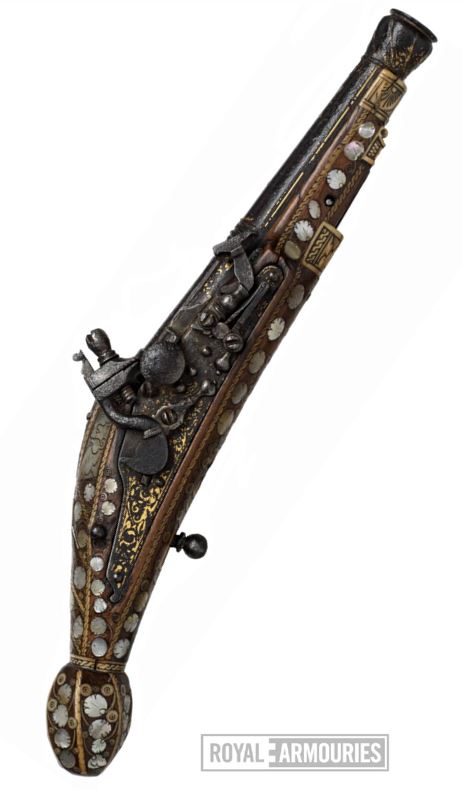
Snaphance muzzle-loading pistol (c. 1600). The Royal Armouries, Leeds, Hunting Gallery, XII.1823. Click for a larger image and a detailed description.
February 2022. Firearms have always been hard to make entirely safe. Sixteenth-century designs improved on the use of a slow-burning match to ignite the gunpowder by developing locks such as the snaphance, in which a flint struck sparks to set the gun off. Such mechanisms were however liable to be set in motion accidentally. At Rainham in Kent on 8 February 1590, Jane Money was working as a maid in the household of a local miller. That afternoon she visited the house of a widowed relation of the miller, where another family member, Benedicta Batte, spinster, had left a snaphance handgun loaded on a table. Jane had with her a small dog and it jumped on the table, setting off the spring that drove the flint. Jane was struck in many places by the hailshot, shot of many small pellets used for hunting, with which the gun was loaded, and she died at once.
January 2022. Sixteenth-century winters were cold, and that meant firewood in the hearth and ice on the roads. The combination was fatal for nineteen-year-old Edmund Gellybrand of St Mary Cray in Kent on 15 January 1575. At 2 in the afternoon he was driving a cart, drawn by four horses and loaded with bundles of wood, down the road from the top of Blackheath Hill towards Greenwich. Without brakes, the best means he had to control the cart’s downward progress with its heavy load were the strength of the thill horse between the shafts and his own muscle-power and balance. All the way down the hill he supported the left side of the cart with his shoulder to slow it down. Suddenly, his feet slipped on ice and he fell. The left wheel ran over his jaw, crushing and breaking it, and he died at 2 in the morning.
December 2021. The holly and the ivy have long been favourite Christmas decorations, but ivy, clinging and tough but suddenly liable to snap, is not easy to collect. At 1 in the afternoon on 22 December 1560, at Horn Grove near Empingham in Rutland, Anne Atkinson, spinster, climbed an ash tree to get some. She had a ladder 8 feet long which she used to climb into the tree, and then drew up behind her in the hope of climbing higher. She pulled the ivy she could reach forcefully towards her, but it broke and she fell head-first from the tree. She hit her forehead on a stone, wounding it an inch or more deep, and when Elizabeth Haryson, wife of Richard Haryson of Horn, found her, she died within a quarter of an hour.
November 2021. Sometimes accidents recorded by coroners can be linked to evidence of very different sorts to enrich our understanding of local history. Jane Jordaine was washing her muslin clothes in a pond at Horner Wood in Somerset 10 am on 14 November 1593, ‘standynge uppon the brinke of the said poonde of water’, when a gust of wind caused her feet to slip. She fell into the pond and drowned, as so many other women did when either washing clothes or fetching water. But this was no ordinary pond. Jane was the wife of William Jordaine of Luccombe, ‘Iren man’, and the pond was ‘a certaine Iren mill poonde of water’.
We know from a Chancery case in 1606 that George Hensley of Selworthy and his brothers William and Robert had set up an iron mill at Luccombe ‘commonlie called Horner mill’ and in 1995-6 archaeological investigation found earthworks, buildings and waste material in Horner Wood suggestive of an iron working site. A substantial dam of stone and earth would have held back a pond – recorded in Jane’s inquest as 10 feet deep and 40 feet wide – to drive the hammer machinery housed in a stone building. Slag from smelting and smithing iron was found together with charcoal made from the oak, ash and birch wood that still grow in the area. Where the Chancery case illuminates the business history of the mill and the archaeological survey its practical operation, the sad fate of Jane Jordaine brings back to life the families who made it work.
October 2021. Internal trade in Tudor England is in some ways harder to reconstruct than international trade, but rivers were clearly of central importance. Flash locks enabled boats to pass mill-weirs, but their operation presented dangers, whether running boats fast downstream on the wave of water released by opening the lock, or dragging them upstream over the weir. Richard Webbe’s inquest was not held until more than four months after his death and far downstream from the site of his fatal accident, presumably after his body washed up from the river, but the account of his fate is vivid. He was a Reading bargeman. Between 9 and 11 on the morning of 30 October 1578, he was on the bank of the Thames near Wargrave in Berkshire. Together with other men he was ‘towinge or drawinge’ a boat called ‘a Westerne Barge’ through ‘Cotterells locke’, the lock by Shiplake Mills, with a rope tied to the boat. They must have been straining against the force of the river and the weight of the cargo. Suddenly, ‘hys feete slippinge or slydinge’, he fell into the river and was drowned.
September 2021. As guns spread through English society, people had to get used to the difficulties of storing and using gunpowder. It readily became damp and lost its explosive power, but drying it out was hazardous, as John Bennett learnt to his cost. On 6 September 1567 he was with others in ‘an armery’ at Godshill on the Isle of Wight. The Isle was kept in a higher state of military preparedness than most of the kingdom: French troops had landed there in 1545 and the 1590s would see a major programme of modernisation at Carisbrooke castle. John was holding a ‘corryer’, an up-to-date long-barrelled development of the earlier arquebus or handgun. He stood next to a chimney where there was ‘chafyngdysshe’ with burning coals. On the chafing or warming dish sat an earthenware dish holding ‘gonnpowder’ set to dry.
John inadvertently knocked over the dish and the powder fell onto the coals and caught fire. From there the fire leapt to 4 ounces of ‘cornepowder’, the grained powder used in handguns, lying covered, five feet away. When that too took light, it set off a ‘fyrkyn’, or small barrel, of corned powder. That explosion blew him against the doorpost as he tried to escape the armoury and crushed his head. Like two-thirds of victims in accidents involving guns or gunpowder, he died instantly.
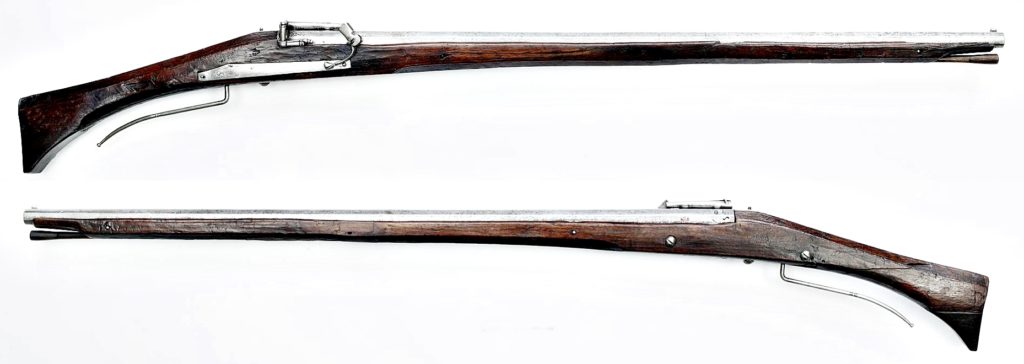
Matchlock muzzle-loading arquebus (c. 1560). The Royal Armouries, Leeds, War Gallery, XII.8. Click for a larger image and a detailed description.
August 2021. Inquest verdicts were given by jurors, but what kind of men sat on juries? Combining inquest reports with other records can give us some idea of the qualifications thought suitable for a diverse selection of respectable adult men. Of the fourteen jurors who reported on the death of Henry Jones in an archery accident at Coventry in August 1526, for example, we can trace eight to varying degrees in the city’s overlapping tax, muster and food demand surveys of 1522-5. The most prosperous were Walter Taillour and William Andrewes, taxed on £5 or £6 and £4 worth of goods respectively, whereas three of their colleagues had no goods worth taxing. Four of them were fit for military service, whereas three, Taillour included, were too old, ill or weak to fight and only one, John Herres, was noted as having the equipment needed to serve as an archer. At least six were married and some headed full households: Andrewes and his wife had one child and employed two lads in his business and two servants, while Henry Mayet had an apprentice. They represented a range of the city’s textile and service industries. Andrewes was a baker, Mayet a shearman, and there were two tailors, while other Coventry juries featured the cappers who worked in its most famous trade.
July 2021. Lightning storms were a hazard of Tudor life when so many people worked in the open air. They killed victims from April to September, but July saw more deaths than any other month. In 1570, Agnes Daye, 12-year-old servant of Thomas Slege, was picking peascods in the fields at Hillington, Norfolk, when she was struck by lightning and killed instantly. In 1585, Jane Smythe, spinster, perhaps not much older, was walking towards the village of Walton near York through the ‘Intacke’ or field enclosed from the commons. Suddenly, as the jurors put it, great tempests, thunder and lightning flamed and came down from the sky. The strike set on fire ‘hir hatt and lynen clothing’ and the hair on her head and she too died at once.
June 2021. In the sixteenth century, as today, it was wise to carry refreshments on long summer journeys; wise, but risky. On 5 June 1572, Nicholas Jenckes and John Jackettes were taking two pieces of timber to the house of Henry Dorlynge at Bidford-on-Avon in the cart of their master, William Charlett of Cleeve Prior in Worcestershire. Jackettes was driving and Jenckes had a bottle clasped between his knees for safe keeping. At 9 in the morning they drove over the River Arrow, perhaps at Oversley, and stopped the cart, but as one wheel rested on a bank, higher than the other wheel, the cart collapsed. As it broke it fell on Jenckes, squashing the bottle into his genitals and wounding him so badly that he died three days later.
May 2021. Some jobs were clearly much more dangerous than others in the sixteenth century, but something could go wrong in more or less any occupation. Tailors were not much at risk, but George Broke was either careless or unlucky. On 25 May 1576, at Buntingford in Hertfordshire, he was working on some clothes brought to him by his neighbour. He picked up a doublet, doubtless resting it on his lap in the classic tailor’s cross-legged pose. He began to cut openings in the front of the doublet with a ‘Chesell’, presumably of the sort used to cut buttonholes. The chisel slipped – ‘dyd glyde’ – and pierced his right thigh. It must have been narrow, sharp and applied with pressure, for it gave him a wound only half an inch wide but four inches deep. He died at once.
April 2021. Numerous fights ended in deaths classified as accidental. At times it is far from clear to us who was really in the wrong or why the inquest found for death by misadventure rather than manslaughter or murder. But in the case of John Weley the jurors wanted us to be in no doubt and did not spare us the details of his end. On Saturday 21 April 1543, they reported, at Shipston-on-Stour, then in Worcestershire, he drank so much that he could barely walk. He came to the house of George Browne, shouted abuse at him and tried to assault him with a staff. He then fell over backwards in the street. All the drink in his body came up through his mouth and nose and he died at once. Neither George nor anyone else, the jurors made clear, had touched him, and he clearly had only himself – or perhaps the drink – to blame.
March 2021. Sixteenth-century mills were dangerous not only because of their fearsome internal machinery, but also because of their unpredictable power sources. It was a day of tempestuous wind at Mucking in Essex on 18 March 1599 and Thomas Folly, miller, decided to take the sail-cloths off the sails of the wind mill. He climbed up one of the sails to pull on the rope that controlled the spread of the sail, but he had not, as the jurors pointed out, paid sufficient attention to his own safety. The critical mistake was his failure to secure the ‘gripe’ of the mill, which should have prevented the mill sails and the machinery connected to them from turning. The violent wind caught the sail, it turned and he fell to his death.
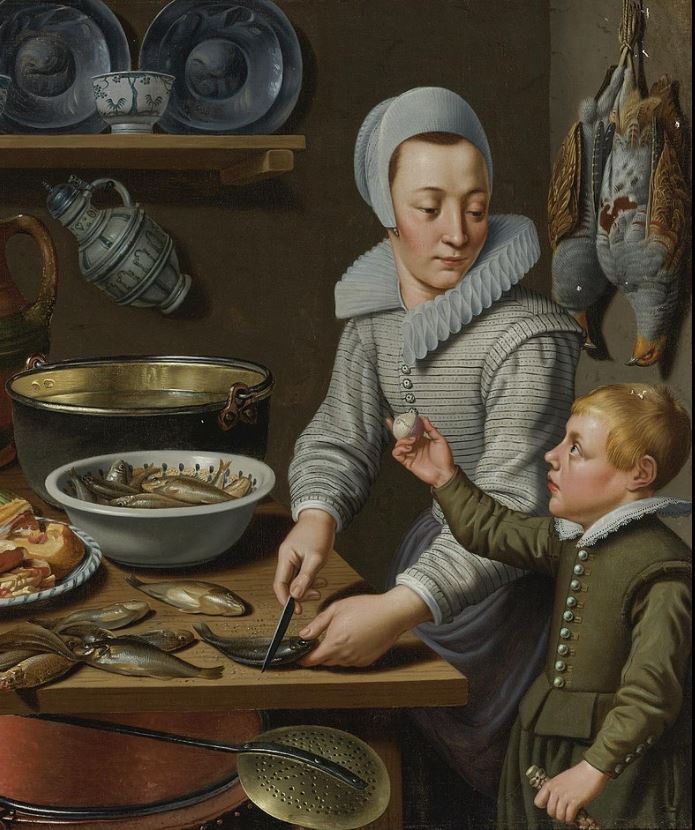
Detail from Kitchen scene with a maid and a boy by Floris van Schooten, c1615. Private collection. Click to enlarge.
February 2021. Tudor households could be tense places. We might think first of troubled marriages, overbearing parents or abusive masters, but another source of friction was the relationship between teenage children of the house and their peers employed as servants. Occasionally, and tragically, we can eavesdrop on their spats. On 10 February 1545, at Pulborough in Sussex, Alice Bennett, aged 15, was in her master Thomas Onley’s kitchen. She was sitting on a stool, sewing, when Onley’s 13-year-old son John came in. John took the small spit used for roasting birds, heated the sharp end in the fire and burnt a hole in a post by the chimney. Alice ‘bade hym rest and leffe worcke, or ells she wolde tell his ffather therof’. ‘What, ffolle’, replied John, ‘what hast thou to doo therwith’? He put the spit back in the fire, intending to bore the hole deeper. She jumped up and ran to take it away from him. He span around, the spit stuck into her left thigh half an inch deep ‘and when she saw her owne blod, she ffell downe ded’.
January 2021. In an age before street lighting, long winter nights could be dangerously dark even in busy towns. At 8 in the evening on 31 January 1586, Matthew Wood’s servants were working on his boat, a ‘hoye’ or small sail-boat, at the wharf in Maidstone, Kent. Their colleague Elizabeth Dollynge came out of Matthew’s house with refreshments for them, a full ‘can pot’ of drink. She had a candle to light her way, but the wind blew out the flame and she stumbled into the Medway, where she was found drowned.
December 2020. Lockdown at home is frustrating, but Tudor imprisonment could be horrible. Confinement in ‘the Dungeon’ or ‘the pitt’ at Warwick gaol was made worse by the means of entry. On 26 December 1573, at 4 in the afternoon, Daniel Biddell, a tailor from the town, was being lowered into it by means of a rope on a windlass. He fell from the rope, hit the back of his head and died within an hour. The risk was persistent. Two and a half years later Griffin Jones fell in the same way and suffered the same injury when his hands slipped on the rope as John Coles, the gaoler and others were ‘lettyng’ him ‘downe’. But then dungeons were not meant to be pleasant. As the preacher William Pemble explained in 1629, God’s promise to Zechariah that he would rescue his people from the ‘Pit wherein is no water’ was such a mighty metaphor because the pit was ‘the worst place in the Prison, the Dungeon: a darkesome dirty Vault underground, whereinto Prisoners were let downe’.
November 2020. Wildfowl offered tasty meat in Tudor England but were hard to catch or shoot. One technique that came into its own as the days shortened in late autumn was batfowling. The aim was to catch unwary or roosting birds at the waterside. But there were risks. At Sonning in Berkshire on 21 November 1562, Thomas Gadge was out with others ‘batfowlyng’ at 11 at night at a lake in Burway Marsh. He saw a teal and threw his net over it, but overbalanced, fell in and drowned. On 27 November 1582 at Sawbridgeworth in Hertfordshire, again at 11 at night, John Shorte was in a ‘batfowlinge’ party when he met a more dramatic end. He was on the dark side of a hedge, trying to force out the birds, but as his companion Arthur Fayerfaxe beat the hedge with a staff he inadvertently hit John in the head and John died next day.
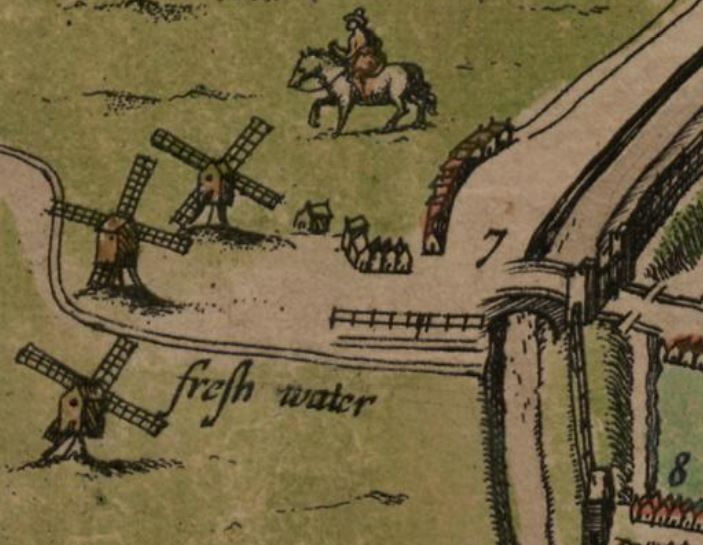
Tenter frames near fulling windmills to the west of Beverley Gate in Hull. Detail from John Speed, The theatre of the empire of Great Britaine: presenting an exact geography of the kingdomes of England, Scotland, Ireland,… (1603-1611). Cambridge University Library, Atlas.2.61.1, p. 65. Click to enlarge.
October 2020. Compared with most occupations in the sixteenth century, work in the rapidly growing textile industry was remarkably safe. Handloom weaving presented few of the risks that would be such a feature of the mechanised cloth mills of the industrial revolution. Yet occasional mishaps did occur. Leeds was a major centre for woollen cloth manufacture and there on 18 October 1565 George Waterhous met his end through one of the later stages of the cloth-making process. At 11 in the morning he was carrying ‘a tenter barre’, part of one of the tenter frames on which cloth was stretched out to dry, from the house of Augustine Wilkynson, gentleman clothier, to ‘the Tenter grene’, where there was room to set the frames up. He stumbled, the bar fell on his head, and he died at 4 am next day.
September 2020. The watermen of London and its surrounding villages were, as has often been remarked, the taxi drivers of their day. They ferried passengers not only between London and Southwark, as an alternative to the single crowded bridge, but also to other key sites along the Thames. Working small boats on a busy river, their trade had many dangers. In September 1579 alone, two Lambeth watermen met their ends in different ways. On the 13th, between 7 and 8 in the evening, Roland Stephenson drowned in what was in effect a parking accident. His colleague William Towseye dropped him off from one boat into another which was tied to two more. The aim was to reach a fourth boat and take it from Stangate, where they were all moored, round to Lambeth bridge, but Roland had neither the right oars nor, the jurors thought, sufficient strength to perform the necessary manoeuvre and he fell into the Thames. Five days earlier, William Harforde had come to grief in more predictable fashion. He was crossing from Westminster bridge to Stangate in Lambeth between 3 and 4 in the afternoon, sitting on the outer edge of the highest part of the boat. He fell backwards off the boat to his death, but then he was, as the jurors pointed out, oppressed by ale or ‘drounck’.
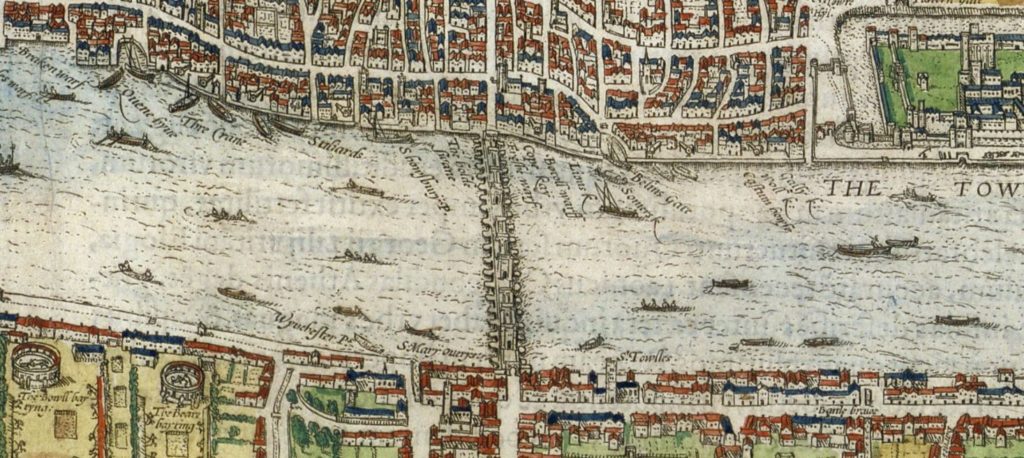
Boats on the Thames. Detail from the 1574 map of London. Georg Braun and Frans Hogenberg, Civitates Orbis Terrarum (Cologne 1574). Folger Shakespeare Library, MAP L85c no 27. Click to enlarge.
August 2020. The Welsh were widely spread in Tudor England and especially in the border counties. Many settled, but others travelled for work. At Little Ness in Shropshire three met tragedy in 1580. Cadwalader ap Hugh ap Dafydd, Thomas ap Hugh ap Dafydd and Ieuan ap John ap Hywel ap Jencyn were labourers from ‘Llangonna’ in Montgomeryshire, perhaps Llangyniew, 23 miles away. On the night of 23 August, they were asleep in a bed in a barn on the farm of Richard Kynaston, gentleman, near a stack of wheat. At 11 p.m. the stack partly collapsed. They were suffocated as 96 sheaves fell on top of them.
July 2020. As our May 2013 accident showed, maypoles were a surprisingly dangerous feature of the Tudor springtime landscape. But the fun, and the risk, did not stop with the spring, as summer-poles decorated with flowers were the focus of revels to midsummer and beyond. At Reading on 19 July 1542, John Cressewell overturned his cart and broke his back when he ran over a summer-pole fixed in the ground. Perhaps it was like the ‘summer polle of byrche’, 40 feet long, standing in the roadway at Westbury in Shropshire in 1565. It fell in the wind at 6 in the evening on 28 June 1565, hitting Alice Chilton as she crossed the road with little Elizabeth Chilton in her arms. Elizabeth, struck on the head, died at once, but Alice lingered, doubtless in mourning and in pain, until 11 the following morning.

Detail from an initial in Le Livre des hystories du Mirouer du monde (c. 1480). Bibliothèque Nationale de France, Français 328.
June 2020. The strawberry season has always been exciting for adults and children alike. In summer 1539 it proved too exciting for three-year-old Richard Sharp, son of Thomas Sharp of Stone near Dartford in Kent. At 4 in the afternoon on 14 June, he was picking strawberries at Bean in the south of the parish. They grew between a pond called ‘lynsale’ and a road called ‘a pakwaye’, presumably used by packhorses, running, at right angles to Watling Street, from Bean to Green Street. Perhaps stretching out for a juicy berry, he fell into the pond and drowned. There he was found by two local youngsters, fourteen-year-old John Rychemond and thirteen-year-old Alice Johnson.
May 2020. Fishing accidents were common in the sixteenth century. Fish, rather than meat, was supposed to be eaten on many days of the year even after the Reformation. It might be caught to cook or sell in many accessible rivers, streams and ponds inland, as well as along the coasts. However, accident reports rarely specify just what fishermen were aiming to catch. Hugh Jones, who drowned on 20 May 1530 at North Hinksey, on the Thames just west of Oxford, is an exception. He was catching ‘Craves’ or white-clawed crayfish, the tasty small crustaceans now almost eliminated from the Thames by their larger cousins the American signal crayfish, when he fell into a ‘myre’ from which he could not get out.

Hedgelaying. Window detail, St Mary and All Saints church, Checkley, Staffordshire. Click to enlarge.
April 2020. Hedges and fences were controversial in Tudor England, targets for enclosure rioters when they blocked access to common land. But they could also be dangerous to build or mend and spring was a prime time for such mishaps. On 8 April 1583, at Heybridge in Essex, John Parbye was mending the hedge or fence between the common marsh called the ‘borough marshe’ and the inner marsh called the ‘ynmarshe’. He was sixty years old and weak from an illness. As he tried to drive a stake into the slippery ground, he lost his footing, fell into a ‘creke’ and drowned. Even those not working on the hedge were at risk. On 15 April 1567, at 3 in the afternoon, Thomas Wraye of Timberland, labourer, was walking through the fields of Branston towards Lincoln. He came too close to a cart piled high with ‘tynsell’, brushwood for hedging or fencing. A gust of wind blew the cart and its load over and Thomas was crushed.
March 2020. Bridges presented dangers for those crossing them, but also for those passing beneath. The stone piers or wooden piles on which larger bridges rested created tricky currents in the water and made dangerous obstacles for boats. John Colye of Lambeth, waterman, came to grief on the Thames at Windsor on 3 March 1581, between 6 and 7 in the morning. He was rowing in his own boat near a bridge called ‘the towne bridge’, the wooden predecessor to the current stone bridge. The boat was suddenly caught by the violent course of the water, carried into ‘the pyles’ of the bridge and crushed against them. As the boat sank, he was dragged away from it by the current and drowned. Similar problems with bridges sank boats on the Wye at Hereford in 1533, on the Trent at Swarkestone in 1541 and on the Thames at Southwark in 1580.
February 2020. Tudor towns were full of animals and they needed water to drink. The easiest source was usually the local river, but that could mean taking horses or cattle to watering places whatever the weather. Elizabeth Tempyll was servant to a York shoemaker, James Tesymond. Between 4 and 5 on the afternoon of 7 February 1541 she took the household’s black cow with a white face to St Leonard’s Landing on the Ouse, where Lendal Bridge now stands, to drink water. The river was frozen and the cow fell through the ice into water several feet deep. Elizabeth and three other young women, Agnes Clay, Agnes Dunwyche and Elizabeth Greynacres, tried to pull her out with a rope tied to her horns, but the ice broke again and all four women drowned. Perhaps they should have gone to York’s recognised ‘watteringe place’, near the Queen’s Staith. Then again, that did not help Francis Mawson when he rode a grey mare into the river there in March 1589. The mare stumbled on a log in the water and fell and both horse and rider drowned.
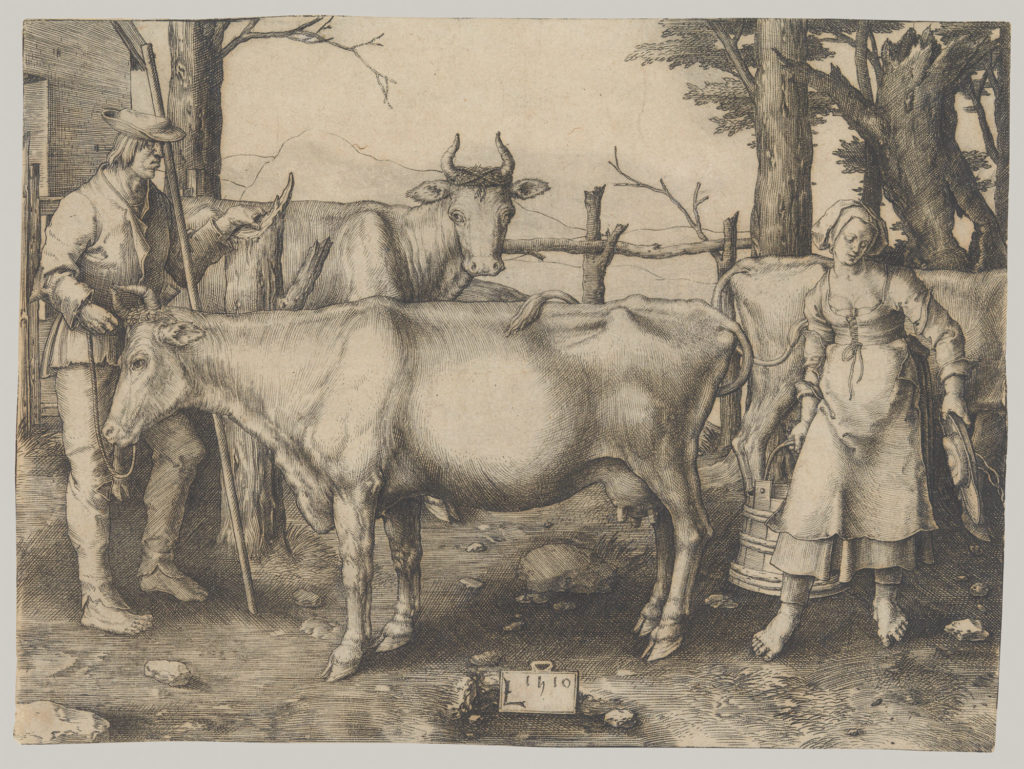
The Milkmaid. An engraving by Lucas van Leyden (1510), Metropolitan Museum of Art, New York City, NY, 41.1.24. Click to enlarge.
January 2020. Tudor legislators might be slow to respond to the dangers posed by accidents, but they were not fatalistic in their attitude to risk. On 30 January 1581, an inquest at Much Birch in Herefordshire investigated a recent disaster. On 1 December 1580, John Swannycke and James Meirick were at either end of the barge that served as a ferryboat at Wilton, steering it across the River Wye. A sudden gust of wind frightened a horse and its trampling drove Swannycke from his post. Without steering, the boat turned in the wind and sank. Swannycke and sixteen passengers drowned. The passengers, labourers, husbandmen, weavers, spinsters, housewives and a tailor, mostly came from the western side of the Wye – Aconbury, Bridstow, Goodrich, Hentland, Llangarron, Pencoyd, Sellack and Much and Little Dewchurch – but also included a shoemaker from Much Marcle to the East.
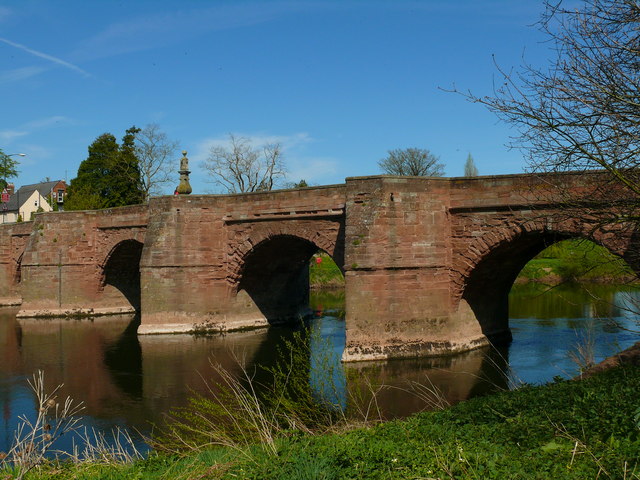
Wilton Bridge.
Eighteen years later an act of parliament, reacting to such perils by providing for local taxation to fund a bridge to replace the Wilton ferry, made its way through the Commons. At first reading on 12 December 1597, Sir Thomas Coningsby, a combative MP for the county, opposed it on the grounds that there were too many taxes already, that Herefordshire was too poor to pay them, and that there were so many bridges on the county’s rapid rivers that the cost of maintaining them all would be prohibitive. But a committee was established to work on the bill, led by Sir John Scudamore, the other knight of the shire for Herefordshire. It included members from the wider region, such as William Oldsworth of Gloucester and David Williams of Brecon Boroughs, experienced legislators such as Sir Robert Wroth, and Herbert Croft, a scion of the family most opposed to Coningsby in local politics.
The final version of the bill, enacted into statute in February 1598, pulled out all the stops in justifying its provisions, as Tudor acts tended to do. The ferry carried trade to Ross-on-Wye and beyond from Herefordshire, Monmouthshire, Brecon and most of South Wales, but the river it crossed was ‘very furious and dangerous, and with a small Rayne doth suddenly swell and ryse uppe’. The ferryboat had often sunk, so that thirty or forty people had ‘not longe since’ been drowned, while others had had to swim for their lives, or had had their arms and legs broken, or had been trampled by other passengers or by horses and cattle sharing the boat. A bridge would solve the problem and so it should be built within seven years at the costs of the county’s inhabitants, bolstered by any voluntary contributions that could be gathered in Wales. Tolls were to be levied – 2d for a cart, 1d for a packhorse, 3d for twenty sheep, 6d for twenty cattle and so on – to pay for the bridge’s upkeep and compensate Charles Bridges esquire, lord of the manor of Wilton, who currently benefited from leasing out the ferry, to the tune of £10 a year. All was to be done under the supervision of the county’s Justices of the Peace, Scudamore, Croft and the cantankerous Coningsby among them. The bridge, built in sandstone, survives to this day.
December 2019. The procedure for investigating sudden death could be presented with a challenge by accidents with multiple victims. If the dead were found at different times in different places, then separate inquests had to be held over each corpse. Yet coroners and the communities they served seem to have responded flexibly and with good sense to maximise local knowledge and administrative continuity. On 22 December 1582, a ferry-boat sank at Gunthorpe Ferry on the River Trent in Nottinghamshire, overturned by the restless horses taken aboard. In the boat were Nicholas Northe, a labourer from East Bridgford, just south of the ferry crossing, Germaine Curzon, a gentleman from nearby Shelford, and Francis Randle, another labourer. All three drowned, as did one of the horses, while the other two horses presumably swam to safety. Their bodies were eventually recovered down-river, Randle and Northe at Kneeton on the right bank and Curzon at Hoveringham on the left bank, but at sufficiently different times that the inquests took place four months apart. None the less, the juries assembled were well designed to reach informed and consistent verdicts. Robert Peper, who found both the bodies at Kneeton, served on the two juries that sat there, three other men sat on two of the juries, while Ralph Wilkynson and John Harropp of Hoveringham served on all three.
November 2019. Modern accident statistics are always capable of surprising us with the damage that can be done by apparently innocuous household objects, from flowerpots to underwear. Things were the same in the sixteenth century. Helen Ricardes of Wotton-under-Edge in Gloucestershire was a married woman, the wife of Philip Ricardes, but on 10 November 1501 she was at the rectory in Wotton, perhaps working as a servant or cook. At 10 pm she walked downstairs, carrying a candlestick, and fell. The candlestick struck her in the right side of the body and she died at once. The report is not as detailed as many later in the century, so the precise role of the candlestick in her death is not quite clear, but the jurors clearly thought that it was decisive enough to place it at the centre of their explanation of poor Helen’s demise.
October 2019. Rivers in flood have a terrible power and one that most sixteenth-century houses were too flimsy to resist. At Kendal on 7 October 1567, the River Kent rose and washed Nicholas Yanson’s two sons out of his house in their bed, drowning one of them. The destruction wrought on Margaret Atkensone’s home on 5 January 1565 was even more drastic. The widow was in her house, near the river in Croft-on-Tees, when the torrent submerged it at 4 in the morning and the building collapsed, one beam falling on her head.
September 2019. Wells were better dug deep to provide a clean and dependable water supply. But depth could make it dangerous to mend, clean or investigate them, not only because of access difficulties, but also through lack of breathable air. On 15 September 1540, at Brimington in Derbyshire, Jane Myller set out at 3 in the afternoon to check whether water ‘dyd spryng’ in a well. She climbed down it using a rope, but was overcome by what the jurors identified as the same problem afflicting miners working at depth, ‘a certayn dampe’ called ‘the colpytte dampe’. She was not the only victim. Arnold Hall, repairing a well at Alcester in Warwickshire, William Marche, retrieving a well bucket at Stainswick in Berkshire, and Thomas Tyndell, draining and cleaning the well of Christopher Harbert, merchant, at his house on Pavement at York, all suffocated in the same way. The scales involved are shown by the report that the well John Humfery was repairing when he succumbed at Codford St Peter in Wiltshire in September 1549 was 60 feet deep.
Sometimes more than one life was lost. At Wednesbury in Staffordshire in September 1539, Richard Chesshyre and Thomas Harwodde were building a well for Nicholas Hopkyns. Richard was felled by what the jurors this time called an odour of the ground named ‘yerthe damp’, Thomas rushed down to help him and both died. At Micheldever in Hampshire in July 1543, Robert Longe went down a well to rescue a piglet, but when he get into trouble Christopher Thirkyld climbed down to get him out. When he too failed to return, John Frere went to look for them both and he perished with them.
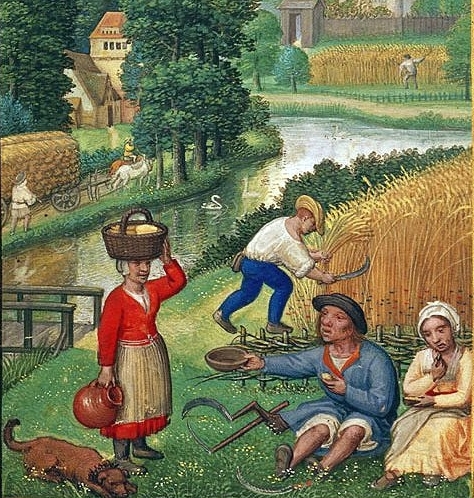
The harvest in August. Detail from Simon Bening’s illumination in the ‘Golf Book of Hours’ (c. 1530), The British Library, Add MS 24098, fol. 25v. Click to enlarge.
August 2019. Harvest could be a dangerous time not only for those working in the fields to gather the crops, but also for those supporting them. At Chellington in Bedfordshire on 31 August 1529, Jane Wright, 15-year-old servant of John Dale, was walking through a field called ‘parke feld’ with two pots of drink for her master’s harvesters. Another of his servants, John Hynde, whipped the four horses driving a cart across the field too hard. The horses came up fast behind her on a green headland and when she tripped and fell the cart ran over her head.
July 2019. Intestinal worms were an unpleasantly common affliction in sixteenth-century England. In his book on horsemanship in 1566 Thomas Blundeville explained that one of the three kinds of worms affecting horses was ‘long and rounde, even lyke to those that children do most commonly voyde’. In June 1580 at Lawshall in Suffolk fourteen-year-old Anne Wyffyn resolved on drastic action to cure herself. She ground up some ratsbane – arsenic used as rat poison – into a very fine powder, mixed it into a pot of ale and drank it, aiming to kill the worms and not suspecting that she would poison herself in the process. She soon fell ill, however, and two days later she was dead.
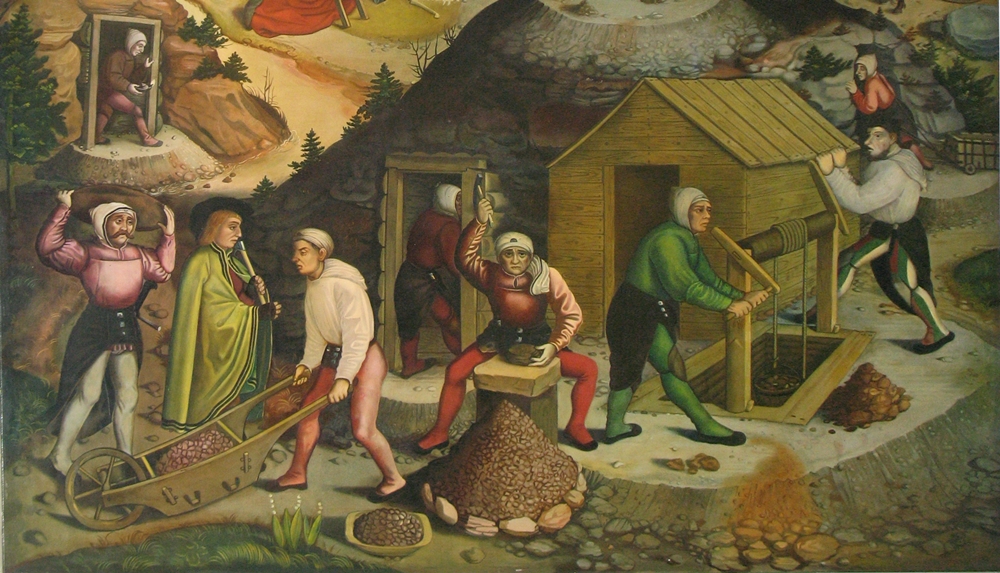
Ore extraction. Detail from the altar (1521) in St. Anne’s Church in Annaberg-Bucholtz, Saxony.

Panfield Hall with remnants of the moat.
January 2019. We tend to think of hermits as a feature of the heroic age of medieval religion rather than the early sixteenth century. But hermitages dotted the early Tudor landscape, often linked to chapels, monasteries or castles, and some still felt the spiritual call to inhabit them. John Hastyngs was the hermit at the chapel of St Anne in Boxley, Kent. He was aged and weak of body and at 9 in the evening on 7 January 1512, walking back to his house by the chapel on a particularly dark night, he fell into a ditch by the roadside and drowned.
December 2018. Criminal clerics and the system of benefit of clergy, by which they evaded some of the normal processes and penalties of the law, were hot topics in medieval and early Tudor England. We do not know the charge against Thomas Sadd, priest, but we do know that on Tuesday 28 November 1525 he was, for certain reasons as the inquest jurors put it, in the custody of Thomas Banys, deputy doorkeeper at Ramsey Abbey in Huntingdonshire. Attempting a night-time escape, he managed to break out of the place in which he was being held, but fell from a height and incurred an injury to his right leg which led to his death six days later, on 4 December.
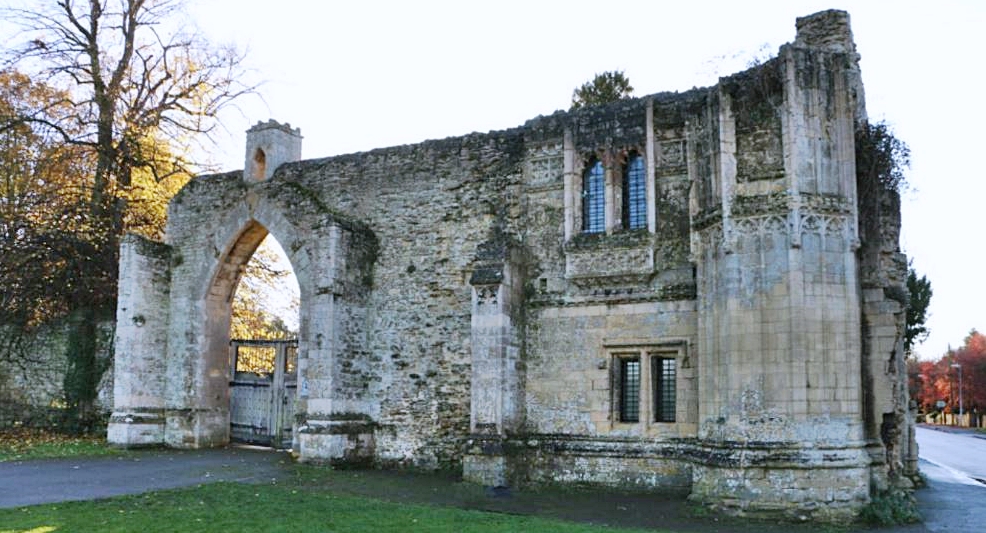
Ramsey Abbey gatehouse.
November 2018. Attitudes to accidents can be hard to recover from the matter-of-fact reporting of the coroner’s inquests. But occasionally the jurors offered revealing explanations for the fatal outcome of some otherwise less than catastrophic injuries. In two cases these involved the astrological medicine widely disseminated in sixteenth-century society through cheap printed almanacs. On 6 November 1580 at Bow Brickhill in Buckinghamshire, Bridget Chyvell fell and wounded herself on the inside of her left thigh with a knife. She died instantly, the jurors opined, because in that ‘leg and place the sign will rule at that time’, presumably a reference to the astrological conjunction. Similar ideas shaped the account of how Simon Reve, a tanner of Beccles in Suffolk, met his end in December 1544. He was passing through the courtyard of James Canne’s house followed by his two mastiff dogs, one red and one white. His dogs quarrelled with Canne’s greyhound, eventually biting it to death, but as he tried to break up the fight he kicked the white mastiff and wounded the instep of his right foot on its ‘toyshe’ or canine tooth. Though his wound was only one-eighth of an inch deep, he died from it nine days later because, the jurors explained, the sign of the foot was then reigning in that place.
October 2018. Most of those who died in Tudor accidents expired either immediately from catastrophic injuries, hours later from the effects of major burns or blood loss, or a week or ten days later, presumably from blood poisoning, blood clots or similar problems. Occasionally, however, juries were confident in attributing death to an event many months before the victim’s demise. This was the case with William Burre, a labourer of Margaretting in Essex. He died on 2 October 1589 and the inquest on his body was held the following day. What it found was that he had been on his deathbed since 12 November the previous year. He had been holding up the front end of a cart belonging to John Tanfyld of Margaretting, gentleman, while others mended it. The cart moved, he fell over and a substantial piece of timber fell on him. His back had been, as the jurors put it, gravely crushed, and he never recovered.
September 2018. Almost all those who died in sixteenth-century accidents were too humble in station to leave any permanent memorial behind them. One early exception was Walter Elmes, the rector of Harpsden in Oxfordshire from 1508 to 1511 and a member of the family who were lords of Bolney manor and patrons of the church. On Friday 15 July 1511, presumably a hot day, he took off his clothes and went into the Thames. He drowned in deep water and his body was found at Wargrave on the Berkshire side of the river. He was buried at Harpsden, where his brass shows him in his vestments but gives his date of death as 5 August, between the date for the drowning given in the inquest and the date the inquest was held, 18 September.
August 2018. The wise drinker knows when to stop. Thomas Beettes, a butcher, went out on 5 August 1589 for a few ales with Benjamin Colthurst, George Greathead and others at the alehouse of William Shorloke in Shenfield, near his home in Brentwood, Essex. They drank and jested with William for an hour or more, at which point Thomas realised that he was nearly drunk and decided he had better walk home alone to Brentwood. He was wearing on his feet ‘a payer of slyppers’, which may have been good for relaxing in, but perhaps not for an unsteady walk. The lane ran by a ditch and when he stumbled and fell in face-first, so the jurors delicately concluded, he must have been so dispirited by the force of the fall and the intoxicating effect of the drink that he could not help himself get out and so drowned by misfortune.
July 2018. Looking for things put away in the loft can still be a hazardous occupation in some houses, especially as we age. For John Rowe, a sixty-year-old tailor of Milverton, Somerset, it proved fatal. At 10 in the morning on 2 August 1589 he went up into a little room in his house to search for a key which he had lost. While there he sat down on a wooden panel which lay across the beams or joists of the room. The joists had not yet been covered with boards, so when he slipped backwards off the panel he fell through them and down to the ground, landing on his shoulders and head, knocking out ‘his breth’ as the jurors put it, and dying on the spot.
June 2018. Difficulties with mobility afflicted the elderly, disabled or injured at all social levels in sixteenth-century society as they do today. Crutches were an aid to those who found trouble in walking, but could not always prevent mishaps. Robert Tappyn of Swineshead in Huntingdonshire was a tailor described as ‘lame’, ‘impotent’ and ‘decrepit’. On 20 May 1583 he was trying to cross a plank bridge over the River Nene in the fields of Higham Ferrers, Northamptonshire, but the wooden ‘crutche’ which he used to hold up his body, judged to be worth a halfpenny, slipped and he fell into the river. Years earlier and miles away a very similar accident led to the death of Nicholas Ellerkar of Tholthorpe, Yorkshire, gentleman. Before dawn on 6 November 1516 he was walking on his ‘crouches of wodd’ from Tholthorpe to a place called ‘Ravensike bank’, but he fell into the River Swale and drowned.
May 2018. The fifteenth-century fan vault of Sherborne Abbey church in Dorset is still much admired today. On Saturday 17 May 1589, the day before Whit Sunday, Robert Michell’s wonderment at its intricacies sadly cost him his life. He had been ringing the bells with other parishioners and afterwards, between noon and 1 p.m., stood in ‘the belfrey’ looking up at ‘the vaulte’. A stone of great weight fell from the vault and hit him on the left side of the head, killing him instantly. His body was laid out in the church when the jurors came to view it and give their verdict on his end; as sophisticated Elizabethan townsfolk, four of them were able to sign their names to the coroner’s final report.

The fan-vaulted ceiling of Sherborne Abbey.
April 2018. Sports such as wrestling, football and throwing the hammer presented obvious dangers to those who played them in the sixteenth century, but tennis was surely safer. Not so for Thomas Wright, a household servant from Milton in Dorset, who was playing tennis, probably a version where the ball was struck with the hand rather than with a racket, in a pasture at Milton at 11 in the morning on Friday 7 April 1581. His ball landed on top of a wall and he climbed up to retrieve it, but fell backwards into a brewing cauldron full of boiling wort. Badly scalded, he died at 11 that night and the wort, forfeit to the queen as the cause of his death, was distributed to the poor people of the village.
March 2018. Water causes problems for most extractive industries. At Quethiock in Cornwall, a centre of slate mining for hundreds of years, sixteenth-century miners found a practical but not entirely safe way to deal with the flooding of their pits. At 8 in the morning of 28 March 1581, John Graye was standing on a ‘flacke’, a wattled hurdle, which had been lowered with four ropes into a deep pit from which ‘healing stone’, slate for ‘heeling’ or roofing houses, was dug. From the hurdle he was reaching into the pit and working hard to throw out the water, but one of the four ropes broke and he was tipped into the water, where he drowned.
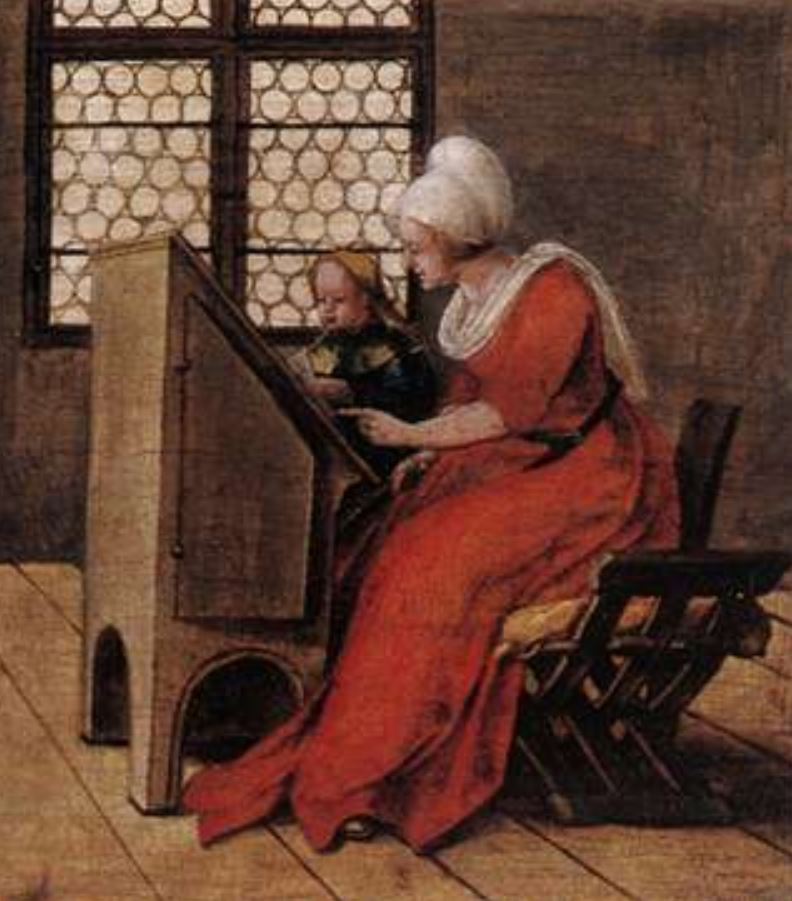
A young girl learning to write. Detail from Signboard for a Schoolmaster by Ambrosius Holbein (1516), Öffentliche Kunstsammlung, Basel.
February 2018. Sixteenth-century people could on occasion show great consideration to animals. On 15 February 1586 a dog fell down the vicarage well at Lynsted in Kent and the vicar’s wife organised a rescue mission. At her request and of his own free will the vicar’s servant William Fyssher tied himself to the great rope and chain of the well by a belt, climbed into the well bucket, and was let down into the well by other honest and trustworthy inhabitants of the village. Unfortunately the contraption was not built to take his weight. The small rope connecting the chain to the great rope broke and he, the bucket and the chain fell into the water at the bottom of the well, where he drowned, presumably leaving the dog to its fate.
January 2018. Educational opportunities for girls in sixteenth-century England were much narrower than those available to boys, but they were expanding. A glimpse of what might be possible and what its costs might be can be seen in the sad fate of five-year-old Joan Cheeseman. On 12 January 1581 she had been at the house of William Broun, the long-serving vicar of Horley in Surrey, learning her letters. After school, at 4 in the afternoon, she set out to walk home to the house of her widowed mother, Mary Cheeseman, three miles away in Charlwood. She tried to cross the millstream at a mill in Horley by walking across a girder, but fell into the stream and drowned.
December 2017. Christmas revelry can get the better of any of us and on Christmas Day 1533 it got the better of Jane Grene of Eynsham, Oxfordshire, spinster. She was climbing the stairs leading to her room at 9 in the evening, but being drunk and debilitated she fell backwards down the stairs. Her head hit a stone in the wall, breaking her skull through to the brain, and in the fall she also broke her neck, bringing her festivities to a tragic end.

A pair of late medieval shears. Museum of London.
November 2017. Many of us try instinctively to catch things we have dropped as they fall to the ground and sixteenth-century people did the same. On 21 November 1580, at Ashford in Kent, William Hammon was sitting at the feet of his mother, Joan, widowed by the death of his father John Hammon and now married to Edmund Spyse, labourer, as she sat at table at 6 in the morning, sewing a linen cloth. She threw a pair of shears she was using in her work forcefully – recklessly, said the jurors with some hindsight – onto the table and they fell off. William knocked his knees together in the attempt to catch them and succeeded only in driving one point of the shears into his right thigh to a depth of an inch. He died an hour later, presumably from loss of blood. He was not alone in his catching reflex. Five weeks later, on Christmas Eve at North Runcton in Norfolk, David Lettredge was eating his midday meal in the house of Thomas Watson. He dropped his knife under the table and tried to catch it with his legs, but pushed it with his left leg into his right. It went in two inches and he died at once.
October 2017. When they could, sixteenth-century people were keen to reduce the dangers of life by the application of technology. Yet the solution could itself prove dangerous. Drownings fetching water from ponds, rivers and wells were so commonplace that it was natural to seek safer ways to get water where resources allowed. At Coventry in the 1580s, as at London, some open wells were replaced by pumps with lead piping. Richard Sandes was mending one of them, soldering the pipes, when he died of suffocation. The jurors blamed a ‘dampe’ arising from the earth, but we might suspect that solder fumes in a confined space added to the risk.
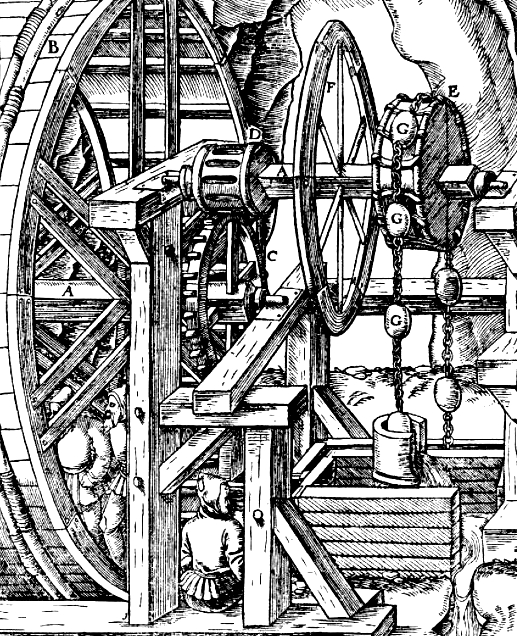
Treadwheel pump. Detail from Georgius Agricola De re metallica (Basel, 1556), p. 155.
At Stockbury in Kent in 1590 a different kind of water engineering proved fatal. William Gray and Ralph Evans, labourers, were working a ‘great treadewheele’ which had been installed to raise water from ‘a depe drawe well’. Ralph was walking in the wheel to raise the water by a rope, chain and bucket and William stood watching him. Ignoring Ralph’s warnings, William stepped between the wheel and the axle post to get a closer view and was caught in the head by a spoke of the wheel. His skull was broken as he was pulled into the wheel and thrown out again and he died instantly.
September 2017. The ripe fruits and nuts of September in orchard, tree and hedgerow were understandably tempting to our forebears. Sometimes temptation led to disaster. Jasper Freeman and James Yott were driving their master’s cart, loaded with a barrel of iron, from Yalding in Kent to Maidstone at 10 in the morning on 24 September 1585. At Barming there was a great stony bank at the side of the road, topped by trees with plums and nuts. Jasper climbed up it in search of a treat, but slipped down in front of one of the cart wheels, which ran him over, breaking his neck and crushing his head. Thomas Stronge of Kennett in Wiltshire picked an equally risky place to go picking on 25 September 1580. He fell head-first 30 feet from a walnut tree onto ‘a sarason stone’ lying beneath, perhaps one of the many sarsen stones assembled into circles and avenues by the prehistoric inhabitants of the area. At least neither of them indulged in quite the reckless scrumping of John Kettell, yeoman. In June 1583 he was out walking with his younger brother, also called John, in a meadow of Sir John Goodwyn at Nether Winchendon in Buckinghamshire. Seeing many cherries growing in an orchard of Sir John’s on the far side of a moat and badly wanting some, he left his brother – who perhaps thought better of the venture – and tried to swim across the moat to get them, but got stuck in the mud in the water and drowned.
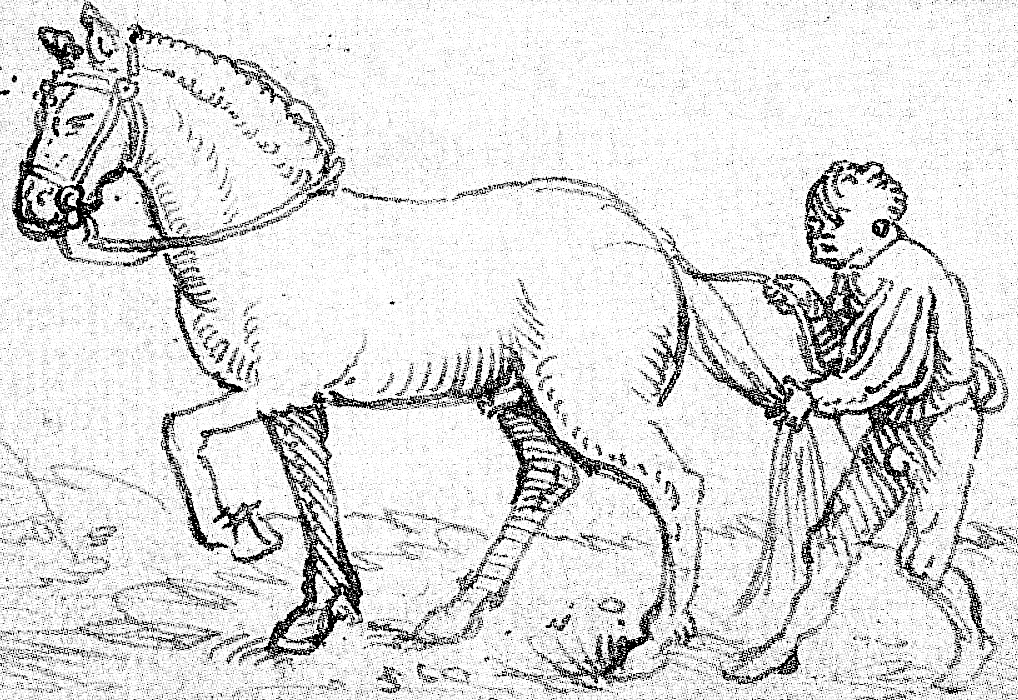
Drawing by Hans Holbein in Erasmus, Moriae Encomium (Basle, 1515), fol. F.
August 2017. The sixteenth century was more accepting than our age of casual cruelty to animals, but sometimes such brutality reaped its own reward. David Morrys was a household servant, probably a very young man, and on 6 August 1581 he was quite far from home, at Adeney in Shropshire, some 60 miles away from Trefeglwys in Montgomeryshire (now Powys), where his master John Jones kept house. It was 6 inthe evening and perhaps he was bored, perhaps just causing trouble where no-one knew him well enough to blame him for it. He saw a mare locked up in the common pound after going astray and picked some stinging nettles with which to torment it. Lifting the mare’s tail with his left hand, he put the nettles under her with his right. The mare responded as violently as he no doubt hoped, but with fatal consequences for him, as a backwards kick caught him in the chest and he died at once from the blow.
July 2017. While many accidents illustrate persistent aspects of sixteenth-century life, others shed light on political or military events of national significance. The Spanish Armada, sailing up the Channel to invade England in cooperation with the Spanish Army of Flanders, was sighted off The Lizard on 19 July 1588. In that month England reached a peak of military preparation. The build-up of stocks of military material had been evident in February, when Robert Clamporte was crushed by the machinery of a water-powered gunpowder mill at Wotton in Surrey as he tried to mend its spindle, and again in May, when a toddler, Nicholas Bowser, was run over by a cart loaded with ‘salte peter water’, a vital ingredient for gunpowder, at Sudbury in Suffolk.
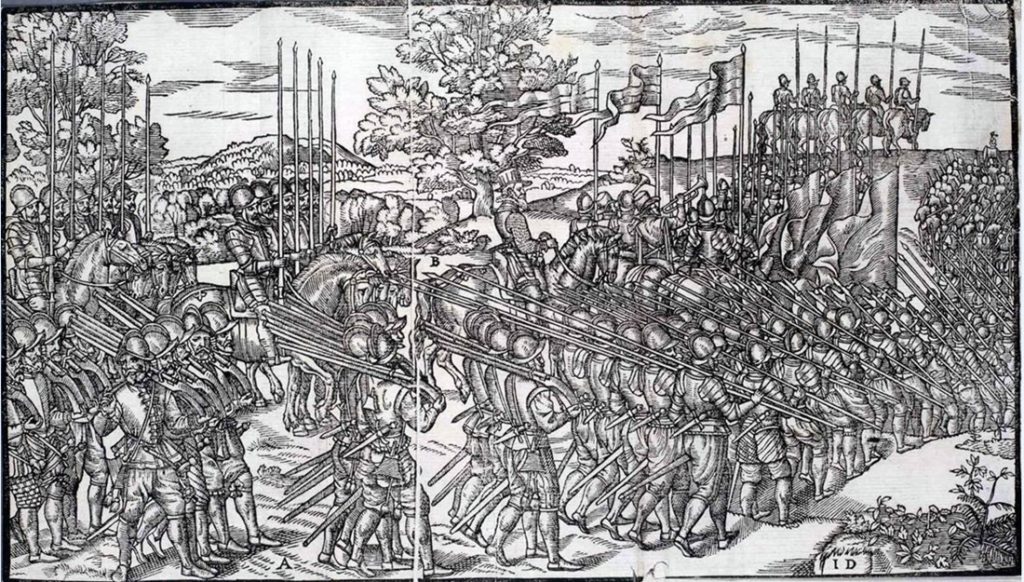
The Elizabethan army on the march. Woodcut from John Derricke’s The Image of Irelande, with a Discoverie of Woodkarne (1581).
By April training was in full swing at Leighton Buzzard, where John Cooke, a butcher, went to watch the soldiers on ‘the cowe market place’. Elisha Jones, a yeoman farmer from Northall, Buckinghamshire, was watching from horseback, but his horse panicked when one of the soldiers shot his gun. As it ran wild it knocked John to the ground, where he hit his head on a stone. As the militia awaited the Spanish army, the mightiest in Europe, in July, there were two more deaths. At Stafford William Hadderton was at the muster of the county cavalry under Walter Harcourt esquire, who would serve as one of the county’s MPs the following year. One of the horsemen was John Key, a yeoman from Croxton, ten miles away. His dag, or short-barrelled gun, went off accidentally and William was shot in the chest. Dags were less romantic than the weapon with which Thomas Dickyns of Burton Lazars, Leicestershire, was practising on 14 July. He charged astride his gelding towards a ‘quyntell’, a target on a post, brandishing ‘a gavelocke of yron’, a javelin, then threw it. What it would have done to the veterans of the Spanish army is doubtful, but as it glanced off the post and flew off sideways it accounted for poor Robert Pares, who was lying on the ground nearby.
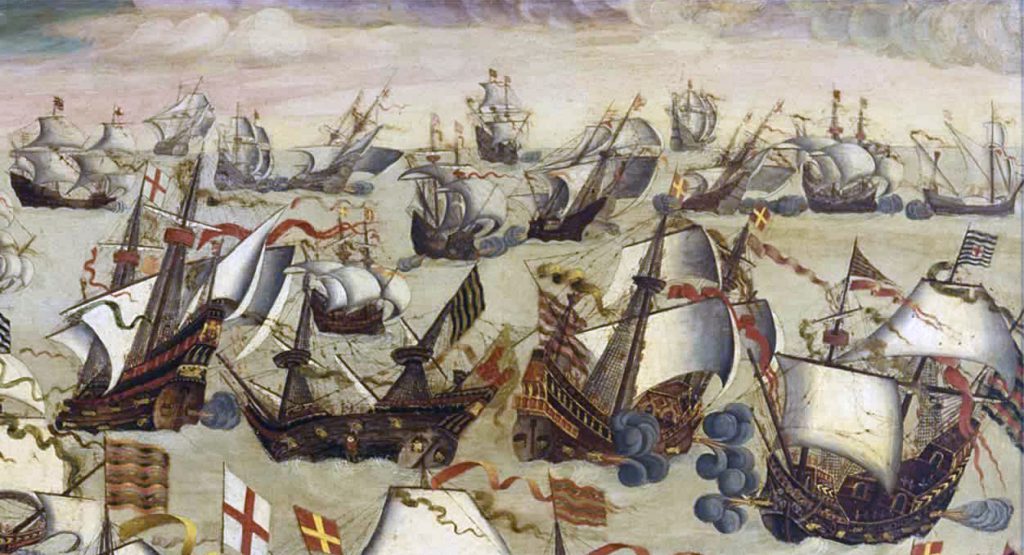
Detail from English ships and the Spanish Armada by an unknown artist. National Maritime Museum, Caird Fund, BHC0262.
June 2016. Summer 1583 stood out in the reports of contemporaries as very hot and dry. The obvious thing to do was to go for a swim to wash and cool down, but that had its dangers. In a normal summer month in the 1580s one two or men might drown while taking a dip, in a bad month like May 1584 or August 1587 four or five. In June 1583 it was eleven, all across the South and Midlands from Kent and Surrey, Dorset and Somerset, to Norfolk, Northamptonshire and Warwickshire. They ranged from boys of 13 through young men of 18 or 20 to adults. They went into ponds, marshes, streams, even rivers like the Avon, Welland and Tone. Often they waited until 7, 8 or 9 pm, after a hot day’s work, but sometimes they could not wait and took the plunge either side of noon. It was possible to take precautions, but they might not work. Thomas Carpenter, servant of Peter Holden, carpenter, went to the millstream at Maidstone on 9 June with other young men, but when he got caught in a whirlpool he had swum too far away for anyone to help him without putting themselves in danger. On 30 June Martin Robinson went into the Thames at Paris Garden in Southwark equipped with two bladders to help him float, but the buckle with which the bladders were fixed to him broke when he was in deep water and he sank beneath the waves of London’s busy river.
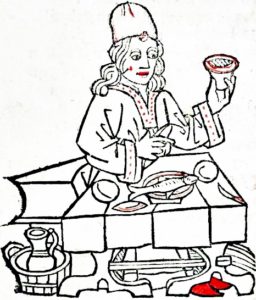
A fish dinner. Woodcut by Conrad Dinkmut in Schwester Demut (Ulm, 1482), The Lessing J. Rosenwald Collection, Library of Congress, Incunabula 1482.S35, fol. 30r.
May 2017. Food poisoning seems rarely to have been reported as accidental death, except when rat poison was involved. Presumably it was not easy to tell from other kinds of illness with similar symptoms and the food, having been eaten, could not readily be confiscated to the use of the crown as the cause of the accident. The few cases that do occur, however, give colourful details of contemporary life. On 7 May 1574, James Penvye, an octogenarian, devoured – ate insatiably, said the jurors – a mackerel at White Waltham in Berkshire, but all was not well. He immediately started to complain of its effects and soon became unwell; a week later he was dead. Alice Johnson’s end was more sociable but even more dramatic. At 8 in the morning on 2 December 1565 she had a visitor at the house of Robert Staneburne, merchant, in Petergate, York. It was Katherine Aynley, a seamstress, an old friend who had formerly been a fellow household servant. Katherine brought with her an electuary, a medicinal conserve or paste, which they ate together, not realising it had become harmful. We do not know the effect on Katherine, but Alice’s body swelled as the poisoning took effect and she died at 6 that evening.
April 2017. While deaths from disease were not generally subject to coroners’ inquests, they might be when failed medical treatment was involved, presumably to clear the practitioners from any suspicion of murder. Two-year-old James Horseley, son of Thomas Horseley of Baldock in Hertfordshire, suffered from scall, a skin disease of the head, perhaps the fungal infection ringworm. On 19 April 1527, at his father’s request, a local surgeon treated him with a plaster or poultice and he died, but the jurors decided that this was a case of misfortune rather than malpractice. In other cases surgeons were exonerated when their patients pulled off their dressings and died from loss of blood, or gave their consent to the amputation of a broken leg after treatment by other surgeons had failed.
March 2017. In our own age the homeless will seek shelter wherever they can on a cold night and it was no different in Tudor times. Thomas Gray was an old man and a beggar in York. On the night of 2 March 1568 he was wandering the streets alone and with nowhere to sleep, but at 8 pm he saw an opportunity. At the city walls on Fishergate there was an opening in the upper part of the door into a room in the postern gate, a building which survives to this day. He climbed up a piece of wooden board until he could reach the gap and pushed his arms and head, then his chest, over the top of the door. As he struggled to get inside, his feet slipped off the board and he found himself jammed, bent over the door on his stomach. Cold and weak, he hung there until he was found, dead, by a young woman called Marjorie Henrison.
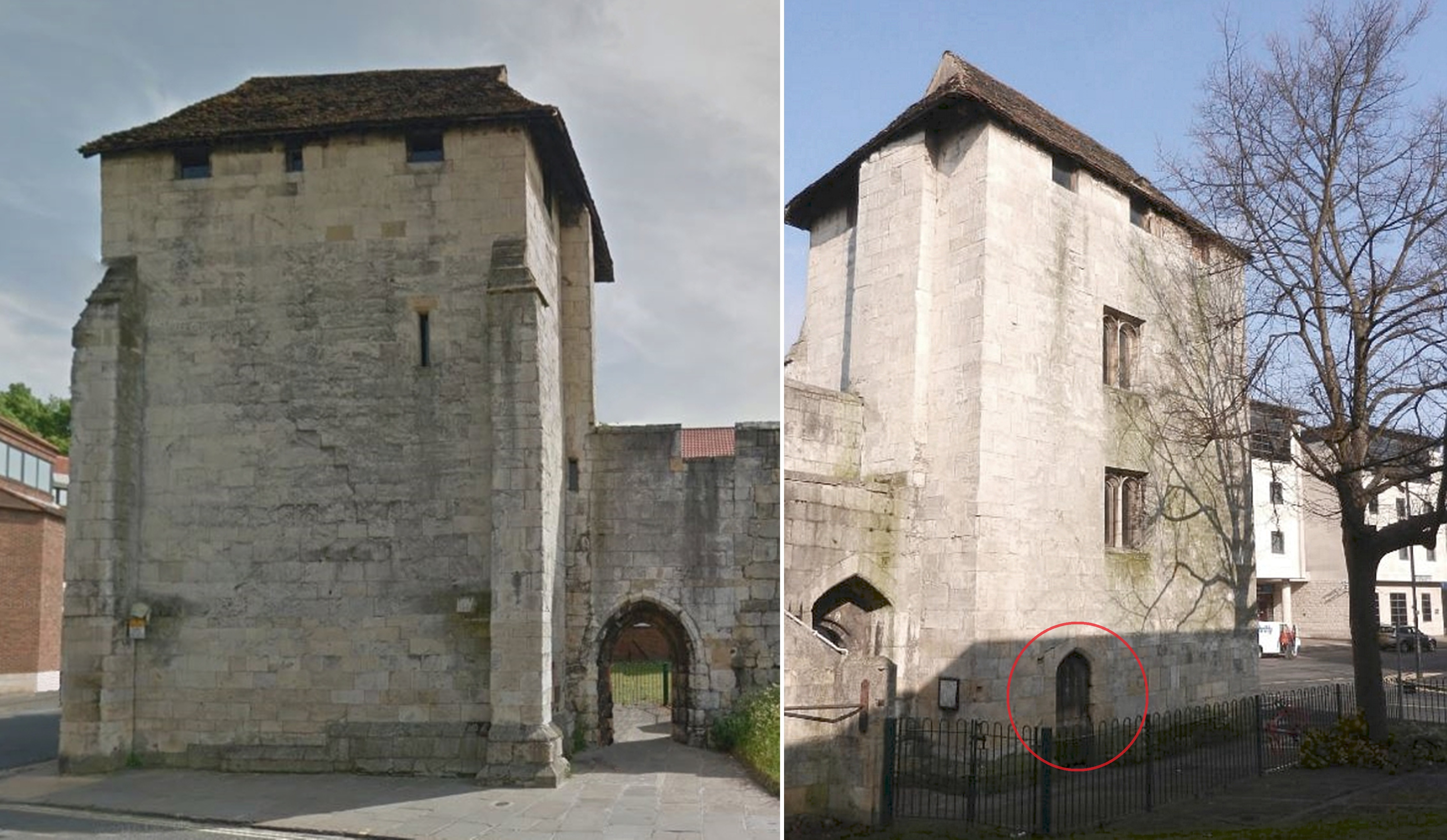
Fishergate Postern Tower in York, west and east view with the door where Thomas Gray died. Click to enlarge.
February 2017. Fuel for the fire needed to be laid in to keep warm in a Tudor winter. In many parts of the country it included turves of peat. July was the peak time to dig it and that month saw accidents transporting it by cart, by boat and carried on one’s shoulders in Derbyshire, Dorset and Yorkshire. The surrounding months saw similar mishaps in Cambridgeshire, Lincolnshire and Westmorland. It needed not only to be collected but well stored. At 6 pm on 24 February 1566, at Ashwicken in Norfolk, John Marten, a shepherd, was sent out into the yard by his master John Loye to fetch ‘certen flagg[es] or turves’ to burn. As he pulled some out, the whole stack fell on him and he was crushed.
January 2017. The causes of disasters and the lessons to be learnt from them were debated in the sixteenth century as they are today. On Sunday 13 January 1583 the scaffolding on which the spectators stood collapsed at a bear-baiting show in Paris Garden, Southwark. Five men and two women from all over the metropolis – Clerkenwell and Shoreditch, Lombard Street and Southwark – were killed and many others injured. The coroner’s jury recounted how the larger than usual crowd had been warned by those in charge of the scaffolding to stand still when the old, weak timbers began to creak, but they took no notice and ran from one side to the other until all fell flat.
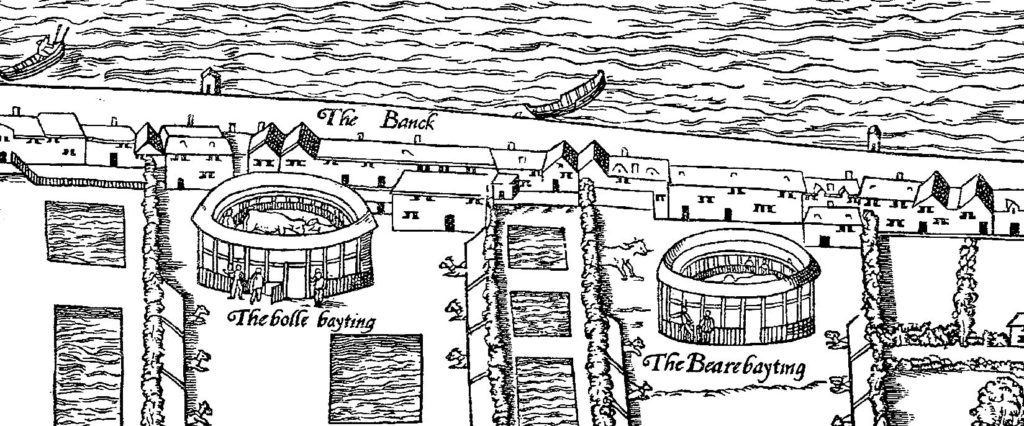
The bull- and bear-baiting rings in Southwark. Detail from Ralph Agas’s Map of London 1561 ([s.l.], 1633). Click to enlarge.
John Field, the militant puritan preacher who had once been curate of St Giles Cripplegate, home parish of one of the victims, had no time for such worldly explanations. Inside five days he rushed out a 44-page pamphlet, arguing that the city magistrates had neglected their duties in allowing a thousand or so Londoners to prophane the Lord’s Sabbath day by crossing the river to attend ‘that cruell and lothsome exercise of bayting beares’. He admitted that the spectators’ gallery was ‘very old and rotten’ and fell under a greater weight of people than it usually bore. But he maintained that the comprehensive nature of the collapse, for not a post or board was left standing higher than the stake to which the bear was tethered, was a sure sign that the event was a ‘fearefull example of God’s judgement’. It was left to Londoners to make up their own minds about Field’s diagnosis: not only the mayor and aldermen, but also masters who should, he suggested, keep their servants from such vanities, and humble townsfolk like the victims, who should recognise such ‘vaine pleasures’ as ‘sweete poysons’, and rather seek after ‘the comfortable worde of salvation’, especially on a Sunday afternoon.
December 2016. Christmas past was a time for finer than usual dining, just like Christmas present. Jane Typtott, wife of John Typtott, must have felt some excitement on Christmas Eve 1567 as she lifted her pig onto a bench at Rickinghall Superior in Suffolk to slaughter it. Sadly for her, though quite understandably, the pig had other ideas. It struggled so violently that she fell over and stabbed herself in the right leg with her knife, dying soon afterwards. Jane was not the only victim of porcine resistance. On 12 January 1571 at Bromyard in Herefordshire, William Pitte of Stoke Bliss, gentleman, was killing a ‘Baken hogge’, a big animal worth three times as much as Jane’s Christmas pig. It bit him in the right hand, the wound presumably became infected, and twelve days later he died.
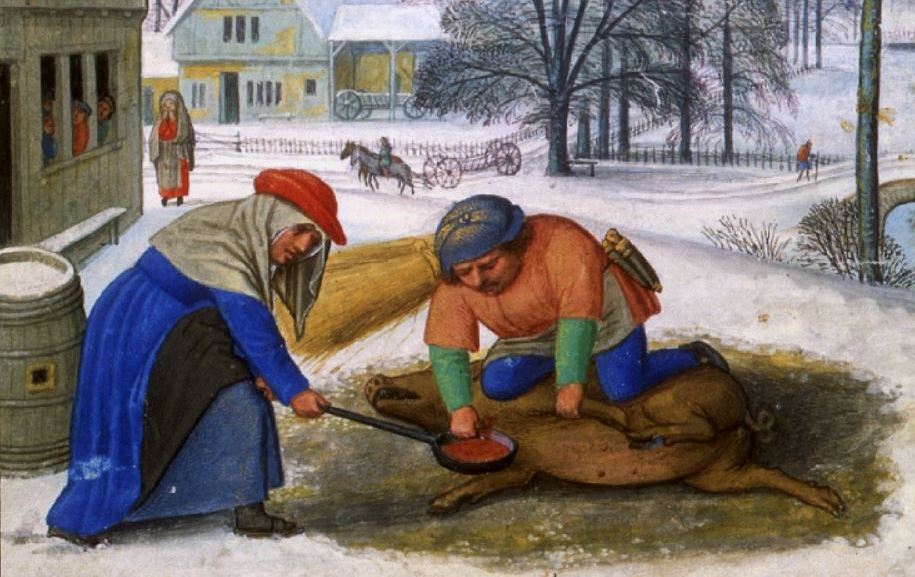
December pig slaughtering. Detail from Simon Bening’s illumination in ‘Da Costa Hours’ (c.1515), The Morgan Library & Museum, MS M.399, fol. 13v. Click to enlarge.
November 2016. The rains and frosts of November make soils and rocks unstable. In the sixteenth century it was a bad month to dig and pits of all sorts collapsed on those working in them. In Walton, Derbyshire, in 1502 it was iron ore that was being excavated, while in Wednesbury, Staffordshire in 1518 and Wentworth, Yorkshire in 1561 it was coal. At Westbury in Wiltshire in 1553 it was stone from a quarry and at Bletchingdon in Oxfordshire in 1549 it was sand. Chalk was dug in Cambridgeshire and Suffolk, and in Bedfordshire ‘hurrocke ston’, a local variety of hard chalk. Most often and most widely – Hampshire, Hertfordshire, Norfolk, Northamptonshire – the pits were for clay or marl. Most of those killed were instantly crushed or suffocated and sometimes the detail makes it all too clear why. Twelve cartloads of ‘wallyng erth’, clay for making cob walls, fell on two weavers, William Castenell and John Wever, at East Chisenbury, Wiltshire, in 1527, and sixty cartloads on John Elys and Thomas Wheytt at Quidhampton in the same county in 1538.
October 2016. On the night of 18-19 December 1543, Archbishop Cranmer’s palace in Canterbury burnt down and it is known from other sources that one of Cranmer’s brothers-in-law was killed in the fire. His inquest report tells us which: it was Henry Byngham esquire, burnt by misfortune at about midnight in the place called the ‘palles’ in the parish of St Alphege, Canterbury.
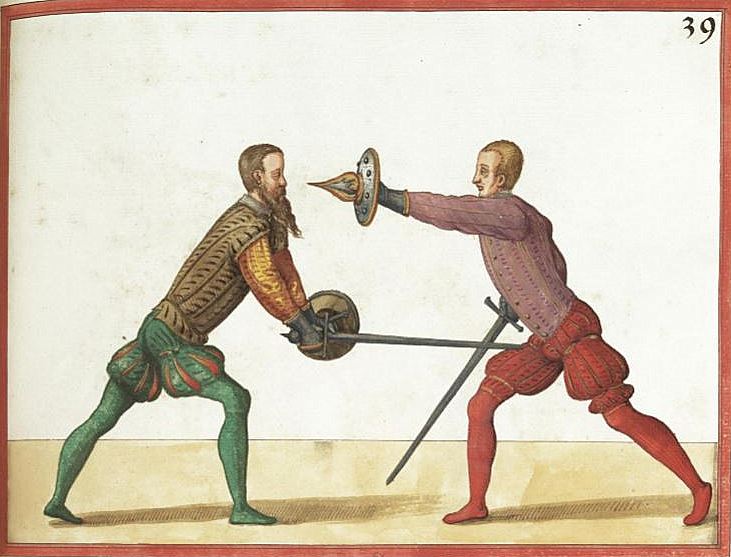
Duelling with swords and bucklers. An illustration in Paul Hector Meir Opus Amplissimum de Arte Athletica (the German version of 1550), Die Sächsische Landesbibliothek – Staats- und Universitätsbibliothek Dresden, MSS Dresd.C.94, fol. 158r. Click to enlarge.
September 2016. Looking back at events in the past it is not always easy to judge whether what happened was an accident. Sometimes contemporaries themselves were unsure. The death of James Whettell of Lyneham, Wiltshire, gentleman, on 25 September 1567, was such a case. About 1 o’clock that afternoon he met John Woodroff of Whitley, yeoman, at Lyneham and they fell out. Whettell publicly spoke ‘certain opprobrious and unbecoming words’ against Woodroff, but they went their separate ways. Later, around 4 o’clock, at the ‘longe barrowe’ at Lyneham, as Woodroff was returning home to Whitley, Whettell attacked him with sword and dragger drawn and wounded him several times. Woodroff drew his sword to defend himself and, going backwards defending himself, fell to the ground, where he lay holding his sword in his right hand, together with a buckler or small shield. Whettell furiously and hastily attacked him, striking him with his sword, but by misfortune he ran onto the point of Woodroff’s sword and gave himself a mortal wound in the left side of his chest, 6 inches deep and 2 inches wide, from which he instantly died.
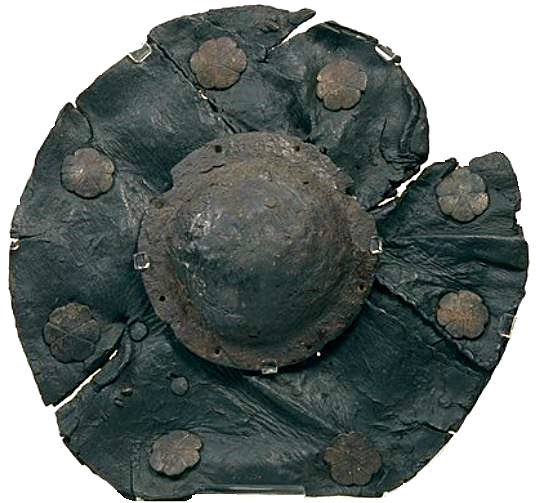
A sixteenth-century leather and iron buckler. Museum of London, A3705.
That, at least, was what the coroner’s jury reported, but they may have had trouble agreeing that version of events. They did not report until 28 April, seven months after the death, and the jury was unusually high-powered, led by an esquire and a gentleman, Nicholas Quynteyn and Richard Danvers. Their language included phrases often used in murder indictments to describe Whettell’s attack on Woodroff: he made it with malice aforethought and in his anger. But someone also noted that Woodroff was at large rather than in custody, as they would do for a murder suspect. The point that Woodroff was going backwards, indeed lying on the ground, was one that often occurred in narratives of killing in self-defence. The jury’s official verdict was that Whettell had feloniously murdered himself, a suicide verdict. Yet one clerk wrote a note on the report that it was a self-defence case, another that it was a misfortune or what we would call an accident. In the end the self-defence note was struck out and the misfortune one left to stand, so perhaps we should count it an accident on the grounds that that is what the system decided at the time. Yet doubts remain. Might this have been a duel tidied up after the event, two antagonists meeting at a landmark, the long barrow, to settle their earlier dispute with its unbearable public insults, Whettell the gentleman with the fashionable duellist’s sword and dagger, Woodroff the yeoman with the more old-fashioned sword and buckler? We shall never know, and perhaps the jurors were not sure either.
August 2016. In an age before shops were widespread, much retail trade depended on the pedlars who walked the roads of England with assorted small goods in their heavy packs. The fate of Jane Iron of Bristol shows the dangers of their life. On 30 August 1567 she was tramping along the queen’s highway from Syon to Isleworth in Middlesex. It was between 6 and 7 in the evening and she had been drinking. On her back she carried a wicker basket loaded with various goods to the value of £1 13s 4d, a substantial sum. She sat down on a stile and tried to take off the basket, but it fell down on one side of the stile while she, overcome by drink, slipped down the other. The belt which carried the weight of the basket across her shoulders caught round her neck as she fell and, unable to get up, she was strangled.
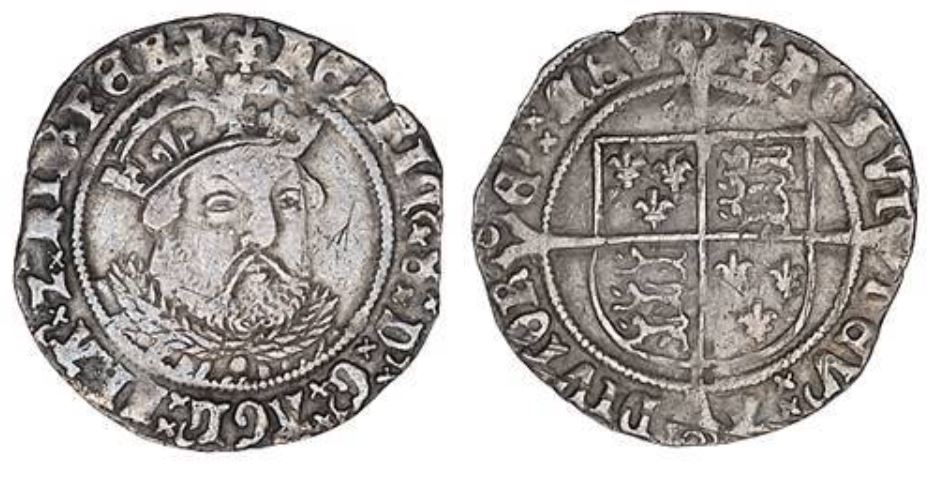
A groat from the reign of Henry VIII.
July 2016. Criminals trying to evade arrest in the sixteenth century could be desperate. William Hutt sold poultry in Northampton, but amid the financial chaos caused by mid-Tudor governments’ debasement of the coinage he tried to turn a dishonest penny by forging coins. On 10 July 1550 the mayor’s men were sent to arrest him so he could be charged before the borough court, but he ran off. First he leapt from a high wall, crushing his left side on landing. From there he made it to a mill pond, which he jumped into, threatening to drown himself, but his pursuers pulled him out. Locked up first in the bailiff’s house and then in the town gaol, he confessed to forging nineteen or twenty groats, which were duly found. Before he could be tried, however, he died from his injuries, two days after his attempted getaway.
June 2016. Today we associate seabirds with holidays at the beach, but in the sixteenth century and for long afterwards they were a valuable source of food. On 14 June 1549, John Coffe climbed a cliff at Swanage in Dorset with his brother Robert, in search of shags breeding there. John fell onto the rocks in the sea below, injuring his right side, and died two hours later. In an unusual addition to their report, which was recorded in English rather than Latin, the jurors pointed out that the climb was so dangerous, two other men having been ‘byffore thatt tyme … in lyke man[er] kyllyd’, that such attempts ‘ought utterly to be denyed’.

Cliffs near Swanage.
May 2016. Jokes from the past do not always strike us as funny, but a prank that went sadly wrong in 1572 may still raise a smile. William Hall, aged 24, was a labourer in the service of Edmund Beamont of Tolleshunt D’Arcy in Essex, husbandman. At 4 in the afternoon on 1 June, he was with Edmund and his other servants in the salt marshes of the Blackwater Estuary, washing about 300 sheep in a creek. As a jest, the inquest jurors reported – and perhaps making the best of having to work on a Sunday – William decided to ride across the stream on the back of a ram. It must have been a surreal sight, but once in the water, he fell off the ram and drowned. His body was recovered from the bottom of the stream some three hours later.

Rooks and foxes. Woodcut in William Caxton’s, The most delectable history of Reynard the Fox, ed. Edward Allde (1620), fol. K4v.
April 2016. Rook chicks were a delicacy in Tudor England and one best taken from the nest in April. The only problem was that rooks nest high in trees. On the afternoon of 27 April 1533, for instance, John Curteys, aged 22, climbed an ash tree in a grove called ‘Rokewode’ at Ketteringham in Norfolk to catch young rooks, but grabbed a branch that broke and fell 30 feet to the ground. Similar mishaps, all in April, all in ash or elm trees, befell John Sygge at Boxford in Suffolk in 1532, George Gybbes at Hunscote in Warwickshire in 1548, a labourer called Nicholas at Marten in Wiltshire in 1551 and a gentleman, Thomas Harmon, at Moxhull in Warwickshire in 1564. The carnage continued into mid-May, with falls at Odstock in Wiltshire in 1539, Kingston in Warwickshire in 1564 and Drayton in Northamptonshire in 1591, when Timothy Burbage’s quest for ‘yonge rookes’ ended at the foot of an ash tree in ‘the kylhowse close’ near the home of Lewis, Lord Mordaunt.
March 2016. The poor state of England’s roads was a constant complaint of early modern travellers. Many cart accidents involved the deep ruts cut into muddy roads by wheeled vehicles, but they could be a danger even to pedestrians. At 3 o’clock in the afternoon of 11 March 1550, John Rusey, a labourer, was walking down the road at Chieveley in Berkshire. He stumbled on a ‘carte rote’ and fell over, and the knife hanging at his belt stabbed him in the stomach to a depth of 2 inches. He was found, dead on the road, by a neighbour on the way home from market.
February 2016. Stormy February weather was dangerous to those travelling on sixteenth-century England’s waterways. Boats were overcome by tempests on the Avon at Tewskesbury in 1532 and Twyning in 1564, on the Wye at Lancaut in 1543, on the Thames in the parish of St Clement Danes in 1560 and on Whittlesey Mere in 1537. Goods of all sorts were transported by water and drownings resulted from the carriage of sheep on the Wiltshire Avon in 1507, iron on the Gloucestershire Severn in 1510 and wood on the Yorkshire Wharf in 1562. Fishing led to disaster on the River Swale in 1520 and dredging for oysters on the Medway at Gillingham in 1566. Boat accidents were also prone to multiple fatalities, particularly on overloaded or ill-kept ferries. Two millers went down crossing the Nene in Northamptonshire in 1591, three men crossing the Witham in Lincolnshire in 1548 and three men, a woman and three mares on their way over the Trent at Barton in Nottinghamshire in 1545.
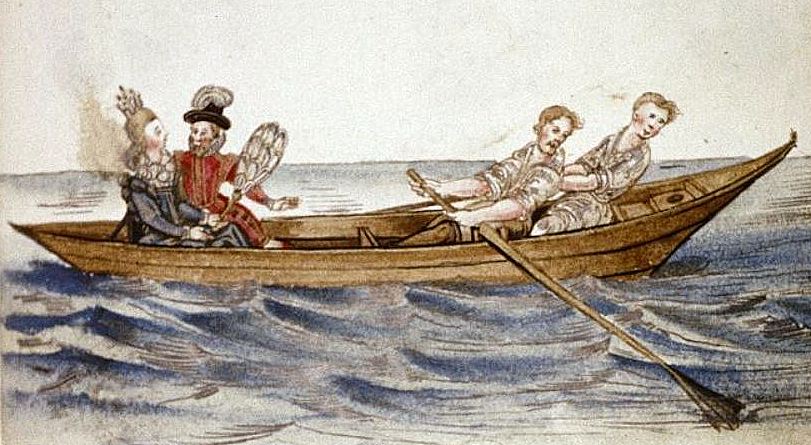
Boat on the Thames. Illustration in Friedrich Rechlinger’s Album Amicorum (c. 1600), Bodleian Library, MS Douce 244, fol. 49r.
January 2016. The game of prison base, prison bars or prisoners’ bars was widespread in early modern England. It involved teams of players who tried to catch members of the opposing team when they ran outside a safe area and like other games it was often played in holiday periods. Though less dangerous than football, wrestling or sports involving weapons, it could nonetheless cause fatalities. On 1 January 1545 Louis Rugge, a husbandman of Ombersley, Worcestershire, fell heavily when playing ‘prysone bace’; he died of his injuries six days later. William Warter’s mishap at Dartford in Kent on St George’s Day the same year was recorded in more detail. He was playing ‘base’ with many young men and girls – making this an unusually mixed sport – for recreation at seven in the evening, after supper. He was told to stand in a certain place near a stone road bank. At one point, however, he moved, against the game’s rules, and ran across the bank towards another player, Richard Harwood of Dartford, miller. William slipped and fell over backwards onto the bank and Richard unintentionally ran into him and fell on top of him, so that his back and kidneys were injured on sharp stones. He died at 3 am next day.
December 2015. Market days in the nearest town were a chance for people who lived in villages to buy and sell, catch up with news and try some urban entertainment. But they were dangerous when those with a long walk home had one drink too many, especially on winter evenings. On 7 December 1563, William Raynoldes did his business at Towcester market and then set off for Ashton, seven miles away. Drunk and in the dark he wandered off the right path and fell into a stream by a bridge in the fields of Stoke Bruerne. Men were more often drunk than women, but Mabel Elcokes, a married woman from Atterley in Shropshire, met a similar fate on the evening of 8 December 1544. She had been drinking all day while going about her business in Much Wenlock, and frequently fell over on the three-mile walk home. About a quarter of a mile from her house she wandered off the road and fell again, dying of cold in the night.
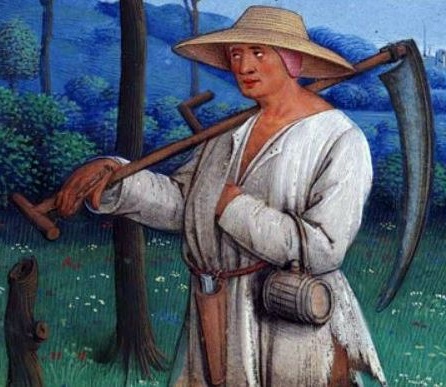
Man with a scythe. Detail from a miniature in the ‘Hours of Louis XII’ (c. 1498), Free Library of Philadelphia, Rare Books Department, Lewis E M 011:19.
November 2015. Accidents can give us an insight into the early history of famous industries. Belbroughton in Worcestershire was known in the nineteenth century as the centre of a successful scythe-making industry whose products were exported around the world. Lawsuits noticed by the Victoria County History show that there were already scythe-makers there in the 1560s, but accidents show us how they worked. On 4 April 1564 Thomas Burnefford of Belbroughton, scythe-smith, was sharpening scythes at the watermill of Roger Sturmye in Stone, five miles away. Something went wrong with the spindle of the watermill and he reached down with his right hand to fix it. Suddenly he was pulled between the spindle and the cog, his body was crushed and he died instantly.
October 2015. The lives of the rich and famous in Tudor England were made possible by the work of numerous servants and accidents bring their lives sharply if momentarily into focus. Sir Thomas Gresham was a pioneer of economic thought, a government adviser on coinage and state debt and a public benefactor, founder of the Royal Exchange and Gresham College. But his horses needed looking after like any others. At 11 pm on 13 January 1564, Henry Heywarde, the fifty-year-old yeoman who had charge of them, was in bed in his chamber at Gresham’s country house, Intwood Hall in Norfolk. He was woken up by the trampling and disquiet of the horses in the stables below. He hurried to the stairs to go and calm them, but fell down them in his haste and broke his neck.

‘twoo payles to carye water w[ith]’. TNA, KB9 608/1/133.
September 2015. Inquest reports give fascinating glimpses of sixteenth-century language because the clerks often noted down English expressions the jurors had used in the middle of their Latin reports. It is reassuring to know that they were as casual as we are about hanging prepositions: Isada Deller, drowned fetching water from the Thames near Kingston-upon-Thames in February 1564, had ‘twoo payles to carye water w[ith]’. Sometimes the reports show technical terms in use long before their first recorded appearance. John ap Owen was running through a cornfield at Church Stretton in Shropshire in July 1561. He stumbled on ‘a clod of yerth’ and fell on an ‘evyll’, a two-pronged wooden fork, which gave him a six-inch wound in the thigh from which he died three hours later. Evell or evil is first recorded in the Oxford English Dictionary from 1642, but the first known mention of a springle, a thin rod of wood used in thatching, dates to 1836. John Houson, labourer, was up a ladder roofing his house in Newcastle-under-Lyme in November 1563. He fell off and landed on a ‘spryngle’ which went five inches into his left side and killed him on the spot.
August 2015. The wool produced by England’s millions of sheep was a mainstay of the later medieval and early modern economy. Its value is brought home by events onthe highway through the common fields of Princethorpe, Warwickshire, on 9 August 1561. Martin Clerke of Blaby in Leicestershire was driving what must have been a large cart, drawn by seven horses and loaded with 73 tods of wool, some 146 stone or more than 900 kilos. The cart overturned and he was crushed beneath cart and load, dying two days later. When the objects involved were valued, the cart and horses were judged worth £2 5s but the wool, at £24, was worth more than ten times as much. No wonder Midlands gentlemen like Clement Throckmorton esquire, owner of the wool, who was shortly to serve as MP for Warwickshire, found sheep-farming profitable.
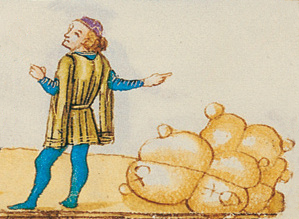
Woolsacks. Detail from an illumination in Filippo Calandri’s Trattato di Aritmetica (c. 1485), Biblioteca Riccardiana di Firenze, MS Ricc. 2669, fol. 66r.
July 2015. Death was the great leveller in Tudor England and accidents as much as disease could afflict the children of rich and poor alike. Toddlers who wandered off drowned all too readily in a landscape full of open water, even when their father owned the river. At 6 in the evening on 1 July 1562, two-year-old Raphael Champneys tried to cross a broken bridge on the estate of his father, Justinian Champneys, gentleman, of Hall Place, Bexley, Kent, and fell into the River Cray. Just over three weeks earlier, between 4 and 5 in the afternoon of 6 June, Margaret Wymarke, aged three and a half, daughter of Roland Wymarke of North Luffenham, Rutland, gentleman, had gone into the orchard on the east side of her father’s house, where there was a well more than 20 feet deep. There, as the jurors imagined it, she played by the bank in a childish manner washing her straw hat until she fell in. At 5 o’clock her father and his servant Isabella Fynne found her body.
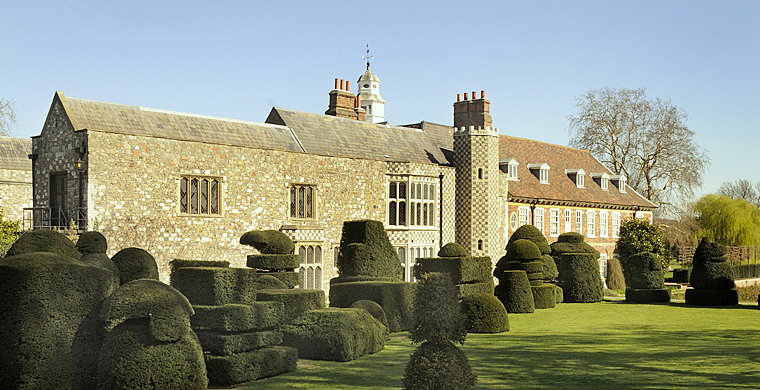
Hall Place, Bexley, Kent.
June 2015. Sixteenth-century people played different sports at different times of year. A classic summer pastime was throwing the hammer, though without the elaborate safety precautions of the modern track and field version. Flying sledge hammers hit John Cadbole at Corfe in Dorset on 8 June 1552, Elizabeth Albott at Ardington in Oxfordshire on 18 June 1565 and Richard Showlder on the downs outside Lewes in Sussex on 17 July 1575. The throwers were not blamed for mishaps provided they warned spectators when they were about to throw. But some eyebrows must have been raised at Robert Woode, a weaver of Knowstone in Devon, who practised by throwing a hammer over a house on 2 July 1591 without checking whether someone was standing on the other side, as, it turned out, the unfortunate Amicius Byckner was.
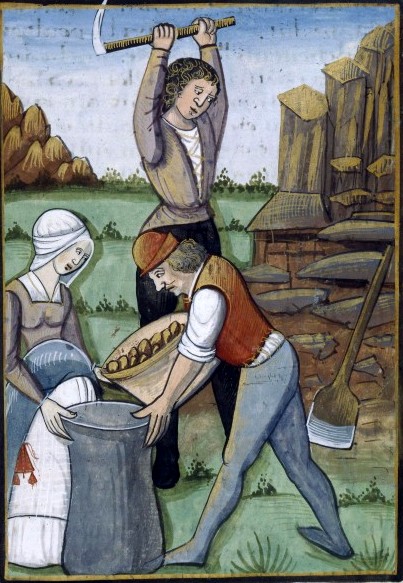
Illumination from Matthaeus Platearius’s Livre des simples médecines, ou Herboriste (c. 1520), Bibliothèque Nationale de France, Fr. 12322, fol. 121v. Click to enlarge.
May 2015. Most work in sixteenth-century England was characterised as either men’s or women’s; Adam delved and Eve span, as the old rhyme had it. Digging, for coal or ore in mines or for marl to fertilise the fields, was overwhelmingly men’s work, yet when needs be women did it too. On 24 May 1561 Oliver Wright of Exhall near Coventry, gentleman, sent his servants out to dig marl from a marl pit in a croft near his house, Alice Carter among them. A piece of earth hanging from the side of the pit above their heads fell on Alice, crushing and bruising her; she lay injured in her master’s house for three days before she died. Her case was not unique. Elizabeth Awse at Eynsham, Oxfordshire, in 1519 and Catherine Wattes at Northampton in 1552 died digging clay, Jane Felkyn and Agnes Smyth at Stone, Staffordshire, in 1539 digging sand, and Elizabeth Haddon at Thorpe St Andrew, Norfolk, in 1597 digging chalk.
April 2015. The pole vault is now a highly technical sport, but in the sixteenth century it was a convenient way to cross streams, ditches and ponds; convenient, but potentially risky. On Christmas Day 1521, Robert Bakar of Croxton in Cambridgeshire, labourer, was going from the parish church to the rectory in a hurry at 6 am. He took a shortcut, climbing over a fence and jumping across ‘the parson’s pond’ using a ‘heggestake’, but the stake broke and he fell into the pond and drowned. At Stoke Rochford, Lincolnshire, on 18 January 1540, John Tydde tried to use a pole in the same way to jump over the River Witham to check on his cattle. The pole snapped in the middle and he too fell to his death.
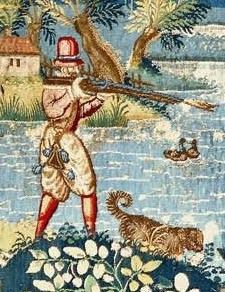
Detail from the Hunters in a Landscape (c. 1575-1595), The Metropolitan Museum of Art, New York, 2009.280.
March 2015. Rich young men in Renaissance England were expected to go about their business with a certain elegant nonchalance, but some carried it to dangerous extremes. John Norton, esquire, was the son of Elizabeth Norton of Norwood manor in the parish of Milton Regis, Kent. On 22 March 1599, between 3 and 4 in the afternoon, he decided to feed his hawk by shooting a pigeon for it, but thought he could do so without leaving his bedchamber. Apparently repeating a routine he had used before, he charged his ‘small birdinge peece’ with powder and hailshot and propped the gun in the open window while he replaced the ‘skowringe sticke’ in the ‘stocke’. The gun spring caught on the wire holding the window frame in place and he was shot through from the left side of his chest to his right shoulder, causing instant death.
February 2015. We are used to the idea that food might be bad for us as part of our diet, but in freak accidents sixteenth-century food could pose other dangers. Elizabeth Bowne, a widow said to be weak and debilitated since her childhood, was a servant in the household of Hugh Talmage of Bury, just outside Ramsey in Huntingdonshire. On 12 February 1543 she was sitting by the fire in the kitchen of her master’s house, warming herself, when the rope suspending four flitches of bacon to smoke in the chimney broke. The bacon fell on her, knocked her to the ground and crushed her head and body; she died four days later.
January 2015. We usually think of the seventeenth century as the first great age of horse racing, with the rise of Newmarket and the spread of Arab and Barbary bloodstock. But accidents show that racing already posed dangers in the mid-sixteenth century. Jane Jonys, wife of William Jonys of Brinkworth, husbandman, was watching a ‘ronnyng game’ at Dauntsey in Wiltshire on Sunday 2 August 1534 when one of the horses ran her down, giving her chest and leg wounds from which she died four days later. In more suburban settings, riders risked races in dangerously cramped spaces. On 16 January 1540 Henry Hedlam and Brian Newton were racing in a garden at the Charterhouse just outside London, galloping up and down a narrow path along a wall. Newton’s horse drew ahead and to catch up Hedlam switched onto another path, lined with great elm trees. He rode so fast and so carelessly that his horse ran straight into one of them. He struck his head on a branch stub, broke his neck and fell from his horse, dying at 5 am the next day.
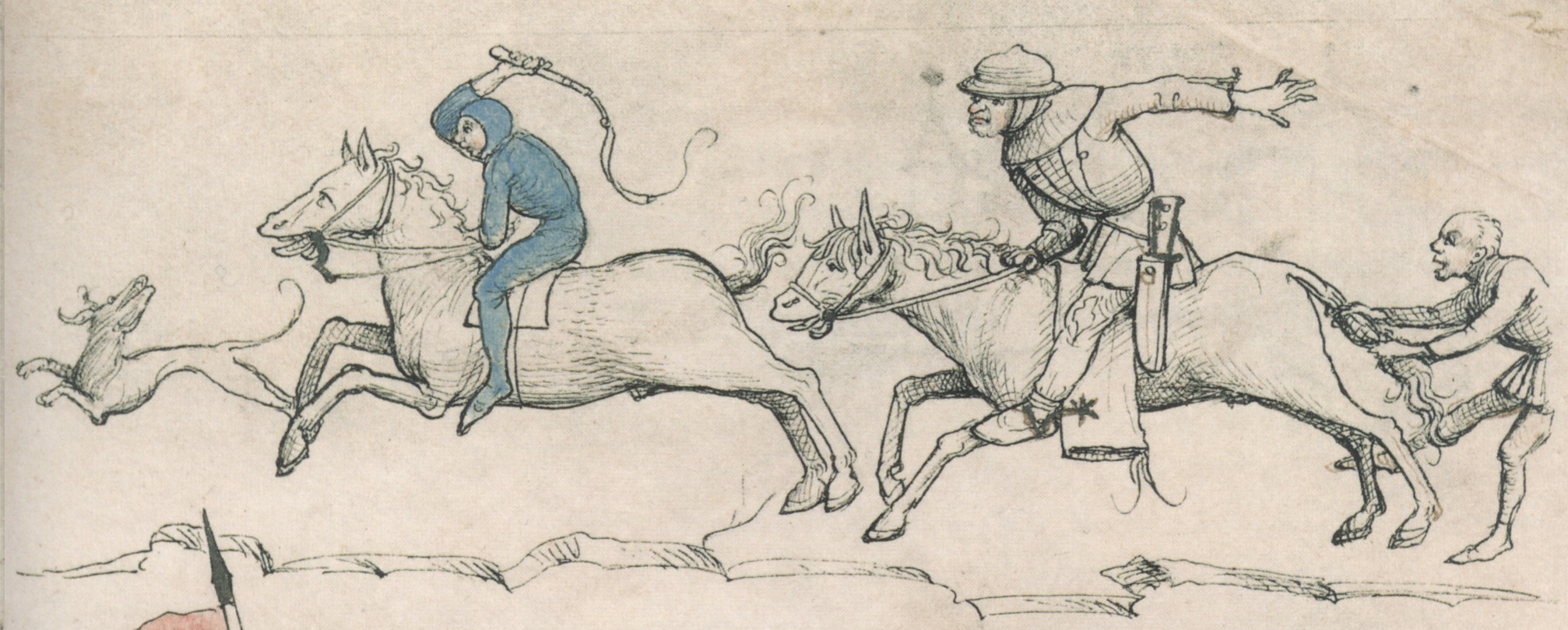
Detail from a drawing in ‘The Housebook’ (c. 1475-1485), The National Gallery of Art, Washington D.C., Collection of the Princes of Walburg-Wolfegg, fol. 22r.
December 2014. Very cold weather caused problems for sixteenth-century people as it does for us, but it also gave unusual leisure opportunities. Their risky winter sports, however, were different from those we might try today. On 28 December 1534 Henry Skelbroke, an Oxford miller, was playing bowls on the ice on Milham Mead, next to the River Cherwell, with six other men, five of them servants of Roland Cowper. He threw his bowl into the river and ran to retrieve it, but the ice broke beneath him and he fell into the water and drowned.
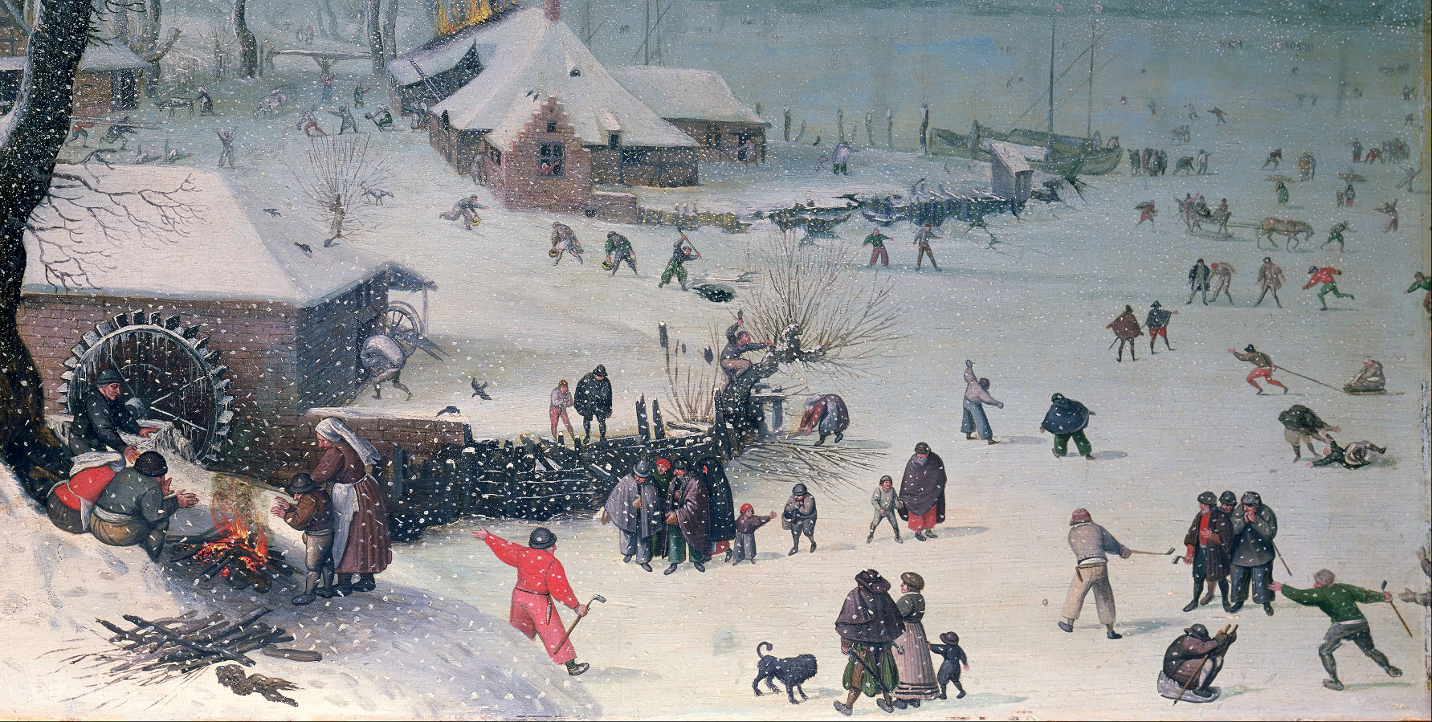
Detail from Winter landscape with snowfall near Antwerp by Lucas van Valckenborch (1575), Städel Museum, Frankfurt am Main. Click to enlarge.
November 2014. In Reformation England the landed gentry, unlike some of those below them, had the time and the literacy to follow reformers’ prescriptions for a life of interior piety, whether traditional or inflected by protestant ideas. On 22 November 1531 Christopher Conyers of Brotton in the North Riding of Yorkshire, gentleman, spent his morning walking around his land to watch his servants working, as he used to do each day. At around 11 he reached the seaside cliffs, where he sat down to pray with a book in his hand. When it was nearly noon and time to go home, he got up, but the tussock of grass on which he had been resting his feet broke up and slid down the cliff. He tried to cling on, but fell about 150 feet, breaking his right arm, his left leg and, as the jurors summed it up, his whole body. At the top of the cliff those who came to look for him found his reading glasses.
October 2014. In the autumn rutting season male deer turn aggressive, not only against each other but also against human intruders. Richard Wyrall found this out to his cost on the morning of 18 October 1535 at Shugborough in Staffordshire, still a wooded enclave between Stafford and Rugeley. He was moving a load of birch wood from a secluded part of Haywood Park when he was attacked by a stag, which broke his right arm and gave him many other wounds, killing him instantly.
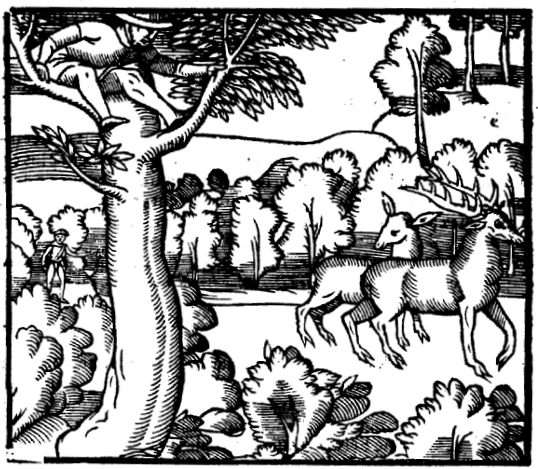
Engraving from Jacques de Fouilloux’s La Venerie (Poitiers, 1562), p. 94.
September 2014. In the early years of Henry VIII’s Reformation, mental illness could take dramatic and resonant forms. William Wale of Walton, Leicestershire, husbandman, had reportedly been insane for a year when, on 11 September 1530 at 4 in the afternoon, he set fire to a cartload of hay and stood in the middle of it, for all the world like a heretic burnt at the stake. He suffered serious burns to his legs and other parts of his body before his servant Jane Moreton, with the help of his neighbours, pulled him away from the fire and took him home. There he told them that Blessed Mary had protected him from the fire and asked them to take him back so that he could show her to them, but when they arrived he suddenly fell into the ashes. The neighbours dragged him away again and led him back to his house, but he died the following day.
August 2014. At harvest time young men and women worked together in the fields and things could get out of hand, especially when hot workers began to strip off. On 20 August 1535 Felicia Clerk, a single woman, was harvesting peas in a field in Dartford, Kent. Due to the heat she undressed down to her smock or shift. John Gill, labourer, ran over to her, intending, as the inquest jurors perhaps coyly put it, out of stupidity to grab her to wrestle and play with her. Unfortunately he fell over and stabbed himself in the leg with the knife he carried in his purse to a depth of three inches, a wound from which he rapidly died, presumably from loss of blood.
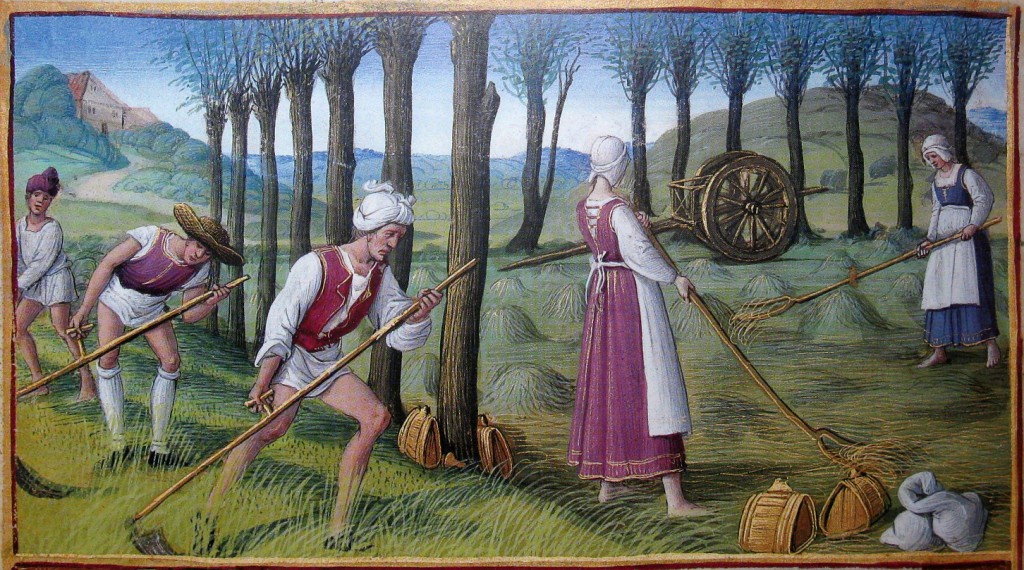
Illumination from ‘Hours of Henry VIII’ (c. 1500), The Morgan Library & Museum, MS H.8, fol. 3v. Click to enlarge.
July 2014. Construction was a dangerous industry in the sixteenth century as it is now, but not many recorded accidents happened in connection with projects as grand as that which killed Griffith Dey. On 28 July 1527 he was driving a cart loaded with long pieces of timber from Kidlington to Oxford for the construction of Cardinal College, Cardinal Wolsey’s magnificent foundation which survives today as Christ Church. Near the pasture lands of Cutteslowe the poor condition of the road caused the cart to collapse and two pieces of timber hit Griffith, breaking his back and killing him outright.
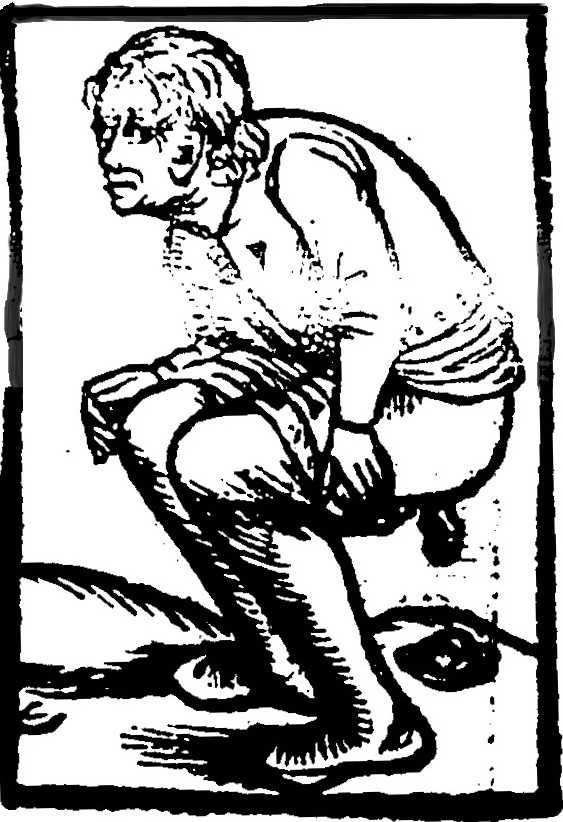
Woodcut from Lawrence Andrew’s The noble lyfe & natures of man, of bestes, serpentys, fowles & fisshes y be moste knowen (Antwerp, 1527).
June 2014. Sixteenth-century sanitary arrangements could be not only unpleasant but deadly. George Dunkyn was a Cambridge baker who lived in St Mary’s parish outside the town’s Trumpington Gate. Between eight and nine on the evening of Tuesday 2 June 1523 he went into the back garden of his house to relieve himself into the cess pit in the corner. Unfortunately he was very drunk at the time and fell backwards off the wooden seat into the pit, where he was ‘qweasomed’, or suffocated, by the stench.
May 2014. House fires were comparatively less deadly in the sixteenth century than they are today. Even conflagrations that consumed whole neighbourhoods claimed few victims, for wooden houses burnt readily but slowly and few had many storeys. Yet occasionally disaster struck. On 2 May 1530 fifty-eight houses were burnt in Long Preston, Yorkshire, but in only two were the residents killed. One was the large house in which the fire started, that of John Kay, where he died with his wife Jane, his sons Robert and William, and Anna Baterisby, probably a servant. The other was the home of William and Jane Nelson, where they perished with their daughters Elizabeth, Jane and Margaret and with Jane Forte and James Lethom, again presumably servants. The reason for the unusual death toll was probably that the flames were, as the jurors pointed out, fanned by a strong wind, and spread too fast for escape.
April 2014. We are used to the process by which technological gadgets such as phones and computers become smaller and more portable. In the sixteenth century it was happening to clocks, which began the period as large fixed devices with elaborate metal mechanisms like those at Salisbury and Wells Cathedrals. At Ringland in Norfolk on 5 April 1513, five-year-old William Bret fell victim to the imposing scale of medieval clockwork. At 4 pm he was in the house of Thomas Mere, lord of Brockdish Manor in Ringland. John Towneshend of Ringland, labourer, was in the upper story of the house, holding in his hand a ‘hole gemetry of Iron concernyng a clok’. It fell out of his hand and one corner of it hit young William on the forehead, giving him a wound 2 inches deep and 1½ inches wide. He languished until 8 pm the next day and then died.
March 2014. In the later Middle Ages the Christian year was the framework for a wide variety of festive customs. On Palm Sunday the boys of Chippenham in Wiltshire, like those of other parishes, climbed onto the church roof to throw small cakes to the crowd below. In 1507, Palm Sunday fell on 28 March. At Chippenham Francis Gore and Nicholas Hulkebere were not among the boys sitting on the roof of the south aisle, but on the ground with those taking part in the church procession and scrambling to collect the cakes. Disastrously it was not only the cakes that came down from the roof. Two ‘batell stonys’, presumably stones from the battlements, fell on top of them and crushed them.
February 2014. Poisoning in the sixteenth century was not confined to the Rome of the Borgias. In England the use of ratsbane, arsenic trioxide, to kill rats and other domestic pests posed a constant threat of contamination. One housewife, Barbara Gilbert of Syston in Leicestershire, mistook ratsbane for flour, mixed it with milk to feed her family, and poisoned herself when she tried some. Ralph Olyver of Coventry and William Keme of Whateley in Warwickshire each found tempting morsels of food left out for vermin and ate them with deadly results. Most poignant was the case of Margaret Morlande of St Margaret South Elmham in Suffolk. She got up at about midnight on Friday 20 April 1599 to help her husband, a lame clergyman, as she often did. Feeling thirsty, she reached in the dark for a pot of beer she had left out, forgetting that next to it stood a pot holding a ‘water to kill lyce’, made with ratsbane, which she drank with fatal effect.
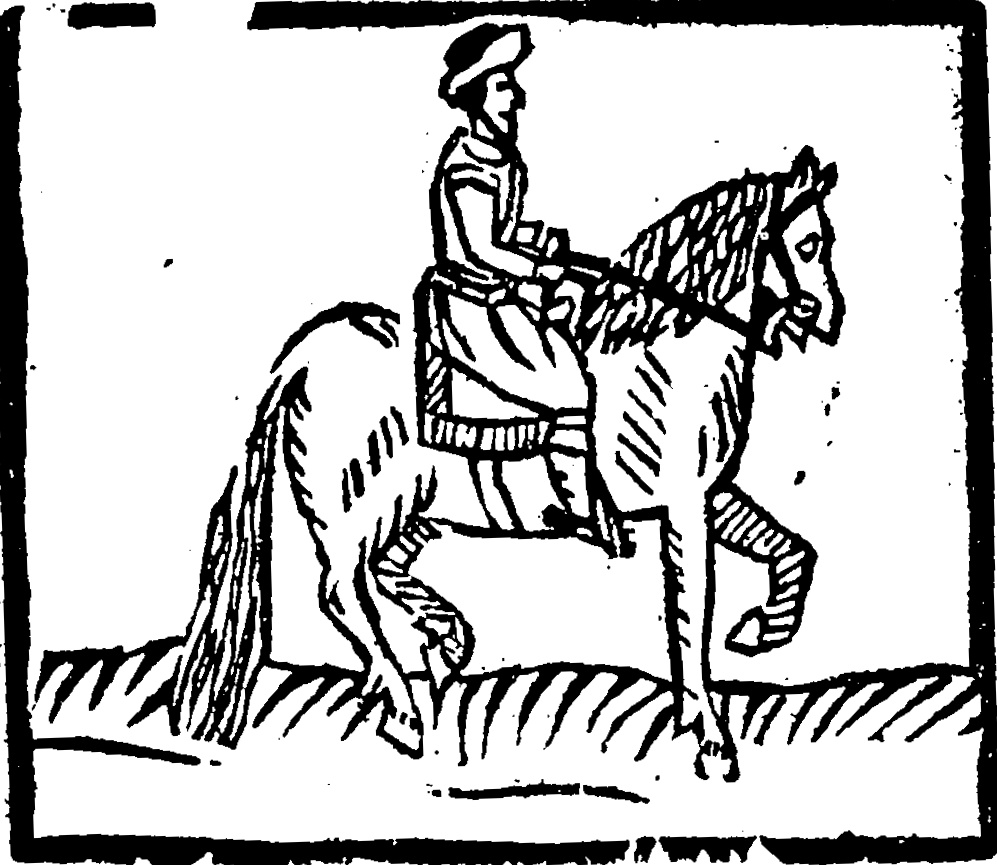
Woodcut from A most straunge, rare, and horrible murther committed by a Frenchman (London, 1586).
January 2014. Flooded roads were a problem in sixteenth-century winters as they are now and anyone trying to travel them could get into difficulties. Agnes Horseley of Walthamstow, spinster, was riding a black mare down a highway flooded with rain water at Stratford Langthorne in Essex on 3 February 1597. The force of the water swept her off the horse and she drowned. Roger Tallet’s bay gelding was a packhorse, carrying kersey cloths belonging to Robert Greenewoode of Halifax, a great weaving centre. On 2 December 1599 Roger, aged about 55, was trying to help his horse over the flooded bridge across the River Soar at Belgrave in Leicestershire, but he fell off the causeway at the south end of the bridge.
December 2013. Coroners’ inquests shed baleful light on life in Tudor prisons. Most of the deaths recorded came from disease in insanitary conditions, but there were also failed escape attempts. One horribly disastrous jailbreak came at Colchester Castle on Christmas Day 1502. Twenty-eight prisoners, including one woman, Agnes Scalys, were in the ‘doungeon’ of the castle, a space thirty feet long, fourteen feet wide and twelve feet high, with stone walls seven feet thick. Nineteen of them were chained to a wooden beam for extra security. Somehow they had smuggled in some firewood, some sulphur and the means to strike a light. They broke the bolt on the chain so they could all get away, then set fire to the door. But instead of providing a way out, the burning door filled the dungeon with smoke and flames and all were overcome. They must have hoped that the distraction of Christmas celebrations would make for an easy getaway, but they created the largest mass accident we have yet discovered.
November 2013. The Reformation changed the calendar, as many saints’ days were replaced by festivities linked to England’s providential history. Gunpowder treason day, November 5, is the greatest relic of the process today, but in Elizabeth’s reign it was 17 November, the anniversary of her accession, that was the day to celebrate. By the 1590s many parishes were lighting bonfires, drinking beer and ringing the church bells in honour of the day, but with bells came accidents. In 1592, at Cobham in Kent, John Robinson was ringing with others between 8 and 9 at night. He stood on a bench to reach the bell-rope as it was too short for him, but the rope caught round the end of the bench and lifted it and him six feet into the air. He fell on his head and left side and died just after midnight. Eight years later, at York Minster, Robert Grymstone was ringing the ‘William bell alias the first bell’ when the bell rope caught between his legs and threw him to the floor. He died between 1 and 2 next morning from a head wound one inch wide, one inch long and, fatally, one inch deep.

Parish church of St Mary Magdalene in Cobham, Kent.
October 2013. Physical violence was an accepted means for sixteenth-century heads of household to enforce their authority over wives, children and servants, but when it became extreme or unreasonable, neighbours might step in to urge restraint. Such intervention could be costly. At Loughborough in Leicestershire on 3 October 1598 at 5 pm, a joiner, Robert Wilson, was punishing his son Thomas by beating him with the handle of a saw. He raised his right hand for a blow and Thomas bent down to avoid being hit. Thomas Nycholles came between father and son in an attempt to calm them down, but was accidentally struck on the left side of his forehead. He lay ill for nearly a week, until 4 pm on the 10th, and then died from the effects of the blow.
September 2013. Pets feature quite frequently in modern accidents, usually as people trip over them or their leads. They were less prominent causes of mishaps in the sixteenth century, but do crop up occasionally in the coroners’ records. Alan Walton met his end at Pontefract Castle on 21 June 1599 at about 6 pm. He climbed onto the winding gear for the portcullis at the ‘Treasure howse’ next to the castle gate in the attempt to catch ‘a litle bird calld a martyn’ for his daughter Ellen. Unfortunately he fell onto ‘a rotten borde’ and, when that broke, down into the pit into which the portcullis used to be lowered, where he broke his neck.
August 2013. Some accidents that feature very largely in modern statistics seem to have been comparatively unusual in the past. Now, with multi-storey dwellings and an ageing population, falling down stairs is a major cause of accidental death. In the sixteenth century it was rarer, so much so as to make the famous death of Amy Robsart, wife of Lord Robert Dudley, seem suspicious: did she fall, did she jump in despair at her husband’s flirtation with Queen Elizabeth, or was she pushed? But staircases did claim victims other than poor Amy. One was Sir Robert Broughton of Denston in Suffolk, a justice of the peace who was coming down the stairs from his room to his son’s room at 11 o’clock at night on 11 August 1506. As the jurors explained, he ‘myssyd of his holde & of his fotyng comynge downe the sayd steyrs’ and badly injured his head and body, dying within six days.
July 2013. Attitudes to accidental death are usually hard to reconstruct from the dry formulations of the coroners’ reports. But occasionally they seem to peep through, especially in the more loquacious reports of the 1590s. The pervasive power of divine providence was a recurrent theme in Reformation preaching and publications, and jurors invoked it in an inquest at Snodland in Kent in June 1592. Between 5 and 7 on the evening of the 21st, Emmeline Tixsall, servant of John Dittye, miller, was walking to her master’s house carrying the miller’s baby daughter in her arms. She crossed a footbridge by the mill on the River Medway, but stumbled at the far end and fell into the mill race. She fell, the jurors said, ‘by misfortune, that is, divine providence’, a phrasing they probably adopted because of what happened as she tripped: she managed to throw the child onto the grassy bank of the pond, thus saving her while she herself drowned. Intriguingly, the jurors or the coroner combined with their providentialism a more legal or pragmatic attitude to safety and risk, for the report recommended that the inhabitants of the village be bound over in the sum of £2 to repair the passage on the eastern side of the mill so that it should be safe for the queen’s subjects to use, and to check that it remain safe in future.
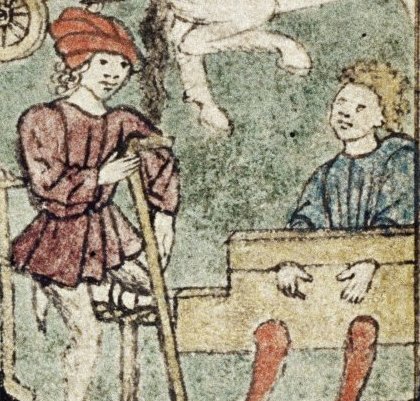
Detail from an illumination in Boke of Astronomy and off Philosophye (third quarter of the 15th century), The Bodleian Library, MS Rawl. D. 1220, fol. 25v.
June 2013. Injuries incurred while resisting arrest are controversial now, but they were equally problematic in the past when it was parish officers, rather than a professional police force, who secured suspected malefactors. On 1 June 1596, Thomas Gryffyn of Orsett, Essex, labourer, caused trouble in church, disturbing the efforts of John Adams, the curate, to conduct evening prayer on the Tuesday in Whitsun week. The parish constable, William Garreth, and the churchwarden, William Bright, assisted by others, tried to put him in the stocks. They secured his right leg but he continued to resist with all his might, dragging the stocks out into the road but injuring himself in the process. In the opinion of the jurors, in the course of the struggle he ‘did bruse and surfett’ his internal organs, which were already weak from a recent fall, and at 3 on the following afternoon he died. Precise responsibility for his injuries must have been hard to apportion, but the jurors surely gave the benefit of the doubt to their responsible neighbours rather than the violent heckler.
May 2013. Dancing round a maypole was a classic springtime entertainment in the sixteenth century. We might not expect it to show up much in accident reports, but while the dancing may not have been dangerous, the maypoles were. John Richardson was killed by a ‘maye poll or somer lugg’ that fell on his head and shoulders while a crowd was trying to set it up on the Abbey Green at Bath on 5 May 1594. At Coventry on 26 April 1558, a collapsing maypole in the churchyard of the former Franciscan friary dislodged a stone from the city wall, which fatally injured Thomas Alsopp. And on 30 April 1592 at Little Wakering in Essex, William Cerbe met his end in a maypole delivery accident, when the cart he was driving to take a maypole into the village overturned and he was struck on the back of the neck.
April 2013. The Elizabethan church was famous for long sermons, at least in areas of Protestant enthusiasm like the Weald of Kent. In one case the preaching may not have been dull but was certainly deadly. Henry Siesly of Rolvenden, butcher, was sitting close to the pulpit in the parish church at 9 in the morning on Monday 24 April 1598 as William Reade, the vicar, was preaching. A book called Opera Bullingeri, the Works of Bullinger, fell from the pulpit and hit him on the right side of the head. Doctors pronounced that the wound was not life-threatening, but he never recovered and died on 20 May. The book, which was worth 2s 6d, was presumably a volume of Bullinger’s Fiftie godlie and learned sermons diuided into fiue decades, containing the chiefe and principall points of Christian religion, a firm favourite of Elizabethan Protestant clergy. Three editions in English and one in Latin were published at London between 1577 and 1587. The English versions ran to three volumes and 1142 pages and measured about twelve inches by nine, so falling from a high pulpit and perhaps bound with metal clasps they were apparently stout enough to deal a fatal blow to an unfortunate parishioner. Reade, who was probably a graduate of Corpus Christi College, Cambridge, stayed on as vicar for the rest of his life, to 1617, but may have been more careful with his books or his gesticulations in the pulpit thereafter.
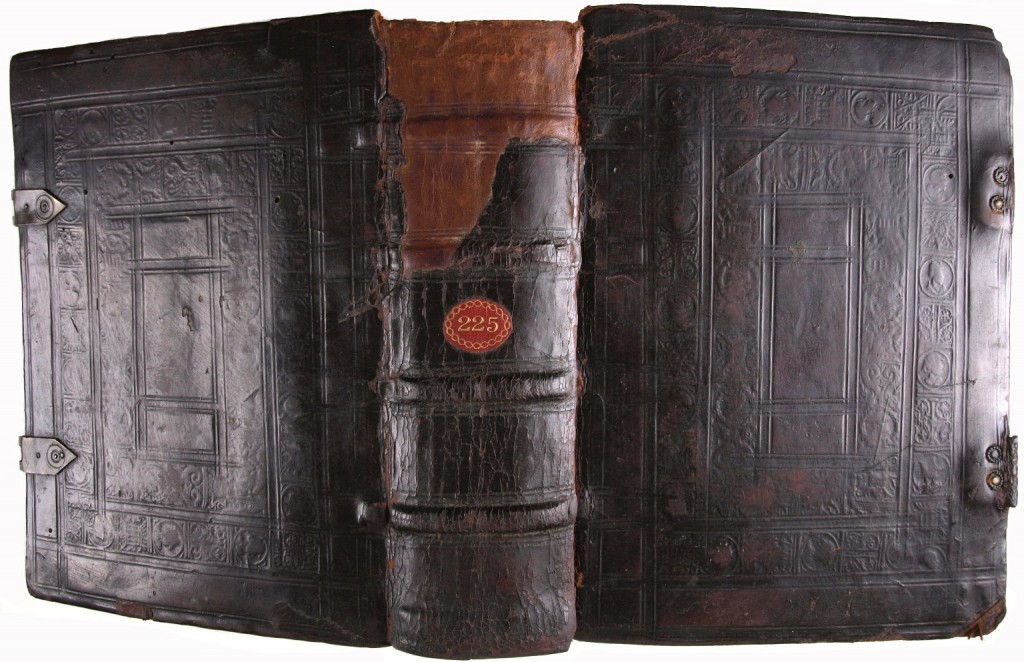
The covers of Henry Bullinger’s Fiftie godlie and learned sermons (1577), The Folger Shakespeare Library, STC 4056.
March 2013. We tend to think of recreation for prisoners as an enlightened innovation of modern times, but one of our accidents shows that provision was made for it in the sixteenth century. John Boothe or Boodhead was a prisoner in Nottingham town gaol in 1593. On Friday 23 March, between 1 and 2 in the afternoon, he was leaping – a common sport, ancestor of our long-jump and high-jump – in a place called ‘the sporting place’ at the gaol. He took a few steps back so as to jump further and fell over a ‘lowe hedge’ and then into the pit behind it. In the fall he broke his neck and died instantly.
February 2013. Vagrancy was a much-debated social problem in the sixteenth century. Rising population and economic dislocation sent the homeless poor onto the roads, looking for work or begging for help. The lonely death of an unnamed beggar girl at Cockayne Hatley in Bedfordshire in 1556 was a long way from the hysterical stereotypes of vagrant gangs conspiring against respectable society. She slept the night of 19/20 February in a shelter called ‘the beacon howse’, presumably attached to one of the warning beacons used to spread warnings in time of invasion. At 8 in the morning she climbed the steps of a windmill belonging to Thaddeus Cockayne, gentleman, lord of the manor, perhaps looking for food. She got to the top and then came down, but fell off heavily and hurt her left side, an injury from which she died on the afternoon of the next day.
January 2013. Religious drama, whether great mystery play cycles like those of York or Chester or simpler parish efforts, was a lively part of late medieval religion. In the sixteenth century it came under pressure from reformers who thought it unseemly and many plays died out. But some kind of play was being put on in the upper part of Gloucester Cathedral churchyard between six and seven in the evening on 28 June 1592. Eight-year-old Thomas Johnson, son of Richard Johnson, weaver, was standing with other boys under the ‘preaching place or crosse’ to watch. John a Thomas, labourer, climbed up the cross to get a better view, but the weight of his body put a strain on the upper part of the cross and a loose stone broke off and fell on the back of young Thomas’s head. He fell to the ground and four days later he was dead.
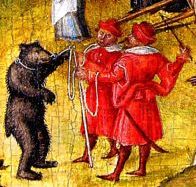
Detail from Matthias Gerung’s Melancholy in the garden of life (1558), Staatlische Kunsthalle Karlsruhe.
December 2012. Sixteenth-century showmen had to advertise their wares just as much as their more modern equivalents. Simon Poulter was one of the great entrepreneurs of the Southwark bear-baiting shows, remembered by witnesses in a court case in 1620 as the man who built stands for spectators there. On Wednesday 4 June 1567 he sent his servants out to proclaim that bears and a bull were to be baited with dogs at Paris Garden two days later. Between 10 and 11 in the morning they came past Charing Cross, banging a drum and leading along a bull and a bear. Startled by the drum and scared of the animals, the horse drawing a collier’s cart bolted and five-year-old George Jeames was run over in the street.
November 2012. Literacy rates were rising in the sixteenth century, stimulated by the spread of printed books, the Reformation’s enthusiasm for Bible-reading and the commercialisation of the economy. There must have been many young people who could read, or read fluently, when their parents could not. Thirteen-year-old Richard Wulley of Henley-on-Thames, Oxfordshire, seems to have been one of them. On 23 November 1554 his father, Thomas, asked him to cut open a newly arrived letter and read it out to him. Richard bent to look for his knife under the table, but collapsed due to a stomach complaint and hit his head on a stool. The blow to his left temple killed him instantly.
October 2012. Many accidents are recorded as happening to small children when they were playing, but the games they were playing are not often described. One exception is the case of three-year-old Christiana Jelyan of Wrangle in Lincolnshire. On 8 August 1551 she was sitting in the street near the edge of a ditch, ‘making out of mud certain wastell [bread] called cakes’; mud-pies, we might call them. She fell backwards into the ditch and drowned in the water, where her uncle, John Hynde, found her.

Engraving from Jost Amman and Hans Sachs’s Eygentliche Beschreibung aller Stände auff Erden, hoher und nidriger, geistlicher und weltlicher, aller Künsten, Handwercken und Händeln (Frankfurt am Main, 1568).
September 2012. Some sixteenth-century accidents are painfully familiar, though today they might not have the same fatal consequences as in the past. Every summer there are punts on the Thames in Oxfordshire and every summer punt poles catch in the muddy bottom of the river, pulling the punters off their punts and into the water as the punt slides away and the pole sticks fast. On 16 June 1554, sixteen-year old Anthony Wylder, son of Thomas Wylder of South Stoke, husbandman, was on the Thames at Goring with ten-year-old Edward Holwen and fourteen-year-old John Roberds, son of Richard Roberds of North Stoke. They were in a boat seeing to eel traps called grig-weels, basket-work fish traps of a sort still used on the Thames three hundred years later. Anthony tried to steer the boat towards the bank, but pushed the ‘rowyng pole’ so strongly into the muddy river bed that he could not pull it out, fell into the water between the pole and the boat, and drowned.
August 2012. Harvest in the English climate often demands quick work to get crops in before rain. With carts around that could be dangerous. On 2 August 1557 at Pentlow in Essex, Thomas Olyvere was harvesting his barley in ‘Walnotte Felde’ and loading it onto his cart. At 11 am he stood on the cart to tie up the load of barley, but the cart turned over and fell on top of him, breaking his neck. On 26 August the following year, on a family farm at Fenny Compton in Warwickshire, another cart accident involved a different crop, but the same outcome. Edmund Dodde was working in John Dodde’s barn when a horse drawing a cart loaded with peas belonging to William Dodde backed up suddenly. The tiller of the cart hit him on the right side of the head, giving him a fatal wound.
July 2012. Harvest has always involved long hours of repetitive and potentially dangerous work, but sixteenth-century mowers tried to minimise the danger of cutting adjoining swathes with a sharp hay scythe by the way they spread themselves over the field. At Welford in Northamptonshire, on 1 July 1559, Richard Goodall was mowing hay with Ralph Billinge of Welford, labourer, John Page, Thomas Tracelove and Richard Moumford in the field of Elizabeth Symes of Welford, widow, in a place called ‘Grindelcoine’. They mowed, walking forwards in a staggered line so as not to hit one another, from 7 am to 11 am. Then, at the end of cutting a swathe, Richard suddenly got in the way of Ralph, who by misfortune struck the back of his right leg with his hay scythe. Richard languished for three hours and then died; even with precautions in place, accidents can happen.
June 2012. The sixteenth century did have a notion of health and safety advice, but it was not always successfully put into practice. In his Five Hundred Points of Good Husbandry (1573), Thomas Tusser warned that when climbing trees to drive away birds that damaged crops or preyed on small domestic animals and birds, ‘Beware how ye climber, for breaking your neck.’ John Coole, labourer, did not beware enough when he climbed an oak tree in the fields of Exton, Rutland, at noon on 12 June 1560. He destroyed the kite’s nest that was his target, but while climbing back down he stood on a weak branch which broke. He fell 20 feet to the ground and died about an hour later.
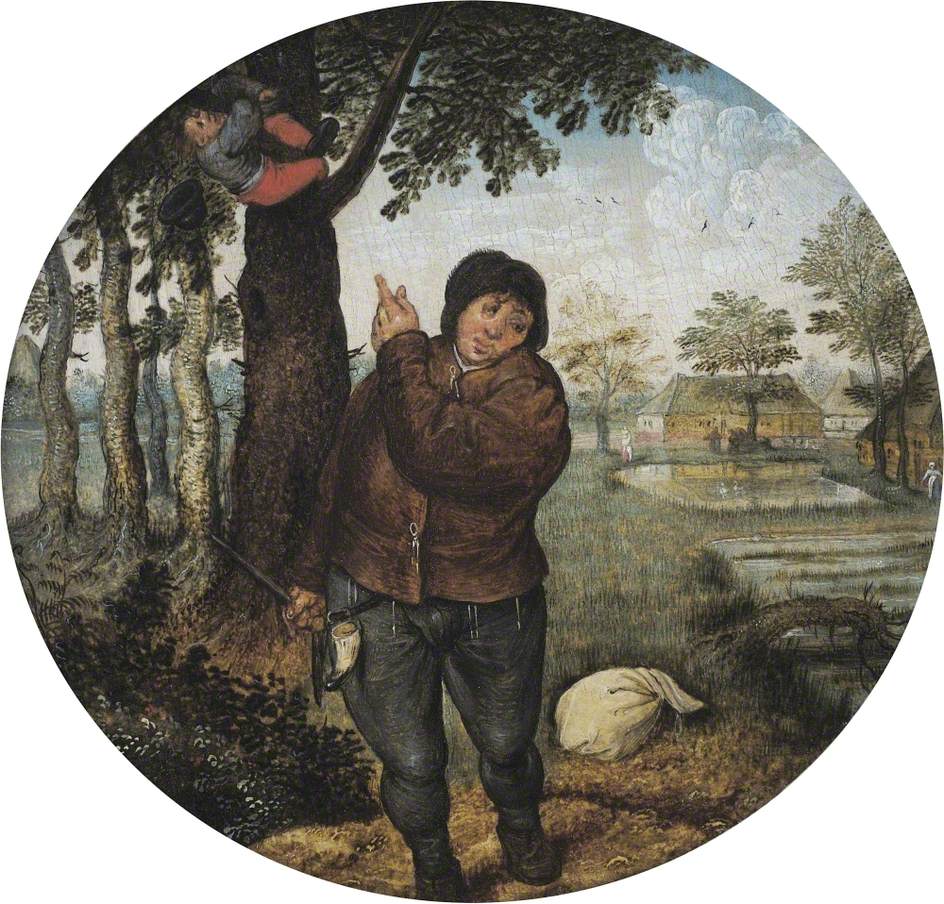
Robbing the bird’s nest by Peter Brueghel the Younger (c. 1580), The Holburne Museum of Art, Bath, A166.
May 2012. Sixteenth-century governments passed laws on a vast range of subjects, from the killing of crows to the wearing of woollen caps, but it is very hard to know how far some of them were really implemented. Thomas Ilys of Poulshot in Wiltshire found out about one of them to his cost on 28 May 1556. The parliament that sat from October to December 1555 had passed an act for the mending of highways, which were judged to be ‘verie noysome & tedious to travell in & dangerous to all Passengers and Cariages’. Under its terms, the churchwardens and constables of every parish were to appoint two surveyors of the works for the amendment of high ways to organise four eight-hour days of communal labour between March and June each year to improve the roads leading to market towns. Workers were to bring along and use ‘suche shovels spades pikes mattockes & other tooles & instruments as they doo make their owne diches & fences withall’. Clearly the village authorities in Poulshot managed to organise a day’s work, presumably on the Devizes road, on 28 May. Towards the end of it, about 5 pm, Thomas was shovelling gravel to mend the highway according to the statute, at a place called Grangyate. He bent his head forward too near where Thomas Pollard of Poulshot, tucker, a worker in the local cloth industry, was digging with his mattock and was hit in the forehead. The mattock gave him a small wound; the depth of one barley corn, said the jurors, and only a quarter of an inch long; but he died the next day.
April 2012. St George, the heroic warrior, had been England’s national saint since the Hundred Years War and his day must have seemed a good time to show off one’s fighting skills. John Coksegge and Richard Chelliffeld seem to have thought so. On 23 April 1521 they were playing with their swords ‘in an unrestrained manner’ or ‘carelessly’ (insolenter) at Gillingham in Kent, in a place called ‘churcheplayn’, presumably the large green next to St Mary Magdalene church. Richard’s sword suddenly and involuntarily fell out of his hand onto his right leg, giving him a wound half an inch deep, from which his blood flowed copiously. He died instantly, by misfortune and not, the jurors were quick to point out, by the malice of John. He had presumably cut an artery. Both John and Richard were described as labourers, so sword-fighting was not just for duelling noblemen.

English basket hilted sword (c. 1540), The Royal Armouries Museum, Leeds, IX.4427.
March 2012. Just as today, different parts of sixteenth-century England offered different employment opportunities. The coal industry was already developing in many of the areas where it would boom in the industrial revolution: Northumberland, Nottinghamshire, Staffordshire and so on. At Beeston in the West Riding of Yorkshire at 5 pm on 13 August 1559 Richard Shafton fell victim to the scourge that would take so many miners’ lives before the invention of the safety lamp. He was supervising the work carried out in a coal-pit by William Calkeke, reported the jurors at his inquest, when he was overcome by the stench and gases called ‘dampe’ and suffocated.
February 2012. We know that football was a popular sport in the sixteenth century, because governments kept trying to ban it to make men practise archery instead. We don’t know much about how it was played, though it did have regional names: camping in East Anglia, hurling in Cornwall. On Sunday 4 February 1509, at Tregorden, Cornwall, sixty men were playing in a game of ‘whurlyng’ according, said the coroner’s jury, to ancient custom. John Coulyng of Bodieve, a village one mile west of Tregorden, ran very strongly and rapidly towards Nicholas Jaane of Benbole, a village two miles east of Tregorden, holding a ball in his right hand. They grappled and Nicholas threw John away from himself. John fell on the ground from the force of the tackle and broke the lesser part of his left leg. He died on 20 February, a classic football victim because nearly all matches seem to have taken place in that month. So football was more like rugby or even American football – other accidents show that players could be tackled whether they had the ball or not – and could be played by large teams from neighbouring and perhaps rival villages. Players often wore knives at their belts and played on fields where they could fall onto stones or tree stumps. The authorities’ claim that it was dangerous as well as distracting, starts to make more sense.
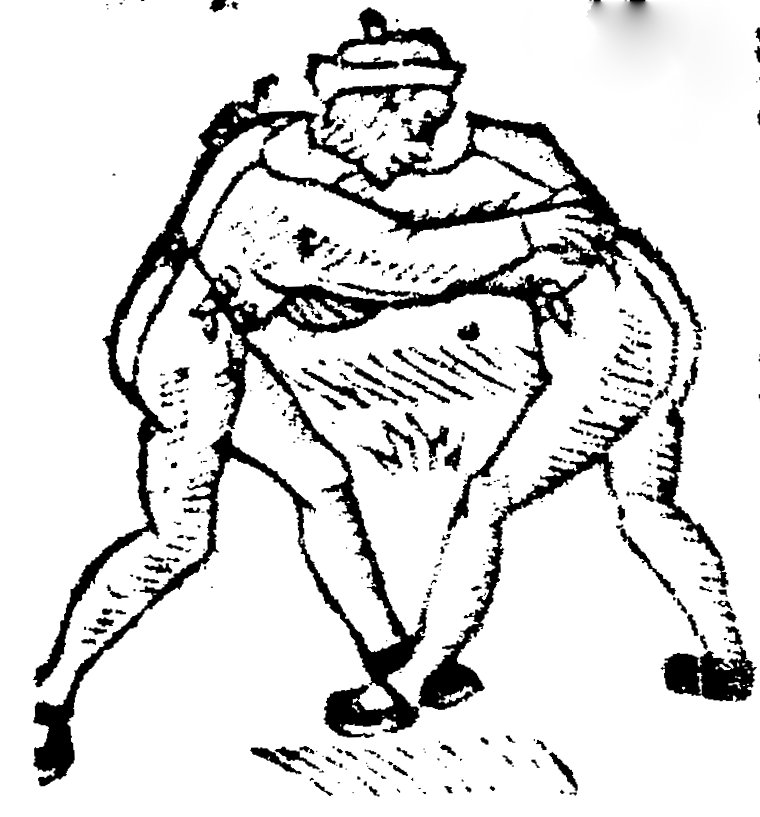
Woodcut from Ranulf Higden’s The Cronycles of Englonde with the dedes of popes and emperours, and also the descripcyon of Englonde (1528), fol. ri.
January 2012. The Christmas holidays were a time for games, but they could be alarmingly rough. Thomas Bunting was killed wrestling in the hall of the rectory at Kneesall in Nottinghamshire on Tuesday 1 January 1549, falling onto the point of the knife hanging from his opponent’s belt. Maybe he had been challenged to a fight in the same way as John Homler, who was playing and wrestling with Thomas Tenyson and William Lamrose in the churchyard at Skeckling near Burstwick in Holderness, Yorkshire, at about 2 pm on Sunday 31 October 1518. Stephen Kayngham of Skeckling, husbandman, came up to them and said that he was a manly man who could throw all three of them over the churchyard wall. John Homler, unwisely as it turned out, said that he could not. Stephen took John and, the jurors stressed, without malice or ill-will put him over the churchyard wall. As John fell to the ground, his knife, which was sticking out of its sheath, pierced a vein under the elbow in his right arm to the depth of an inch and his blood flowed out copiously, though he did not die until weeks later, perhaps from an infection, at about 2 am on 8 January 1519.
December 2011. Horses seem to have been by far the most dangerous animals people worked with in the sixteenth century, though we have found one man gored in the Lincolnshire marshes by ‘a madd cow’. For small children, pigs were also a threat. In September 1558 at Huggate in the East Riding of Yorkshire, William Burghe, aged 5, was driving a herd of pigs into the fields. One of the boars attacked him and gave him a wound in the stomach, from which he instantly died.
November 2011. The years 1557-9 saw a terrible sequence of epidemics strike the English population, but historians still debate what disease or diseases were responsible and quite what proportion of the population died. Dorothy Cawthorn of Belton in Lincolnshire had such a high fever that she lost her reason, said the jurors at her inquest. She got out of bed between 4 and 5 a.m. on Thursday 19 October 1559 and smashed a hole in the kitchen wall – presumably the door was locked for the night – so she could get out into her mistress’s hop-garden, where she drowned in a pit of water five feet deep in the attempt to get a drink. Maybe she was suffering from influenza with accompanying, disorientating, encephalitis? Whatever the infection, her plight shows the desperation of those struck down by the disease.
 October 2011. Much work in sixteenth-century England was seasonal and this strongly affected the pattern of accidental death. Thomas Tusser’s agricultural handbook Five Hundred Points of Good Husbandry (1573), advised that October was the month to find ‘plenty of acorns, the porkling to fat’. Between 8 and 9 am on 3 October 1559, Amice Hyllyar, daughter of Thomas Hyllyar, of Preston Capes in Northamptonshire, husbandman, climbed an oak tree in Preston Wood. She sat on a rotten branch, which broke, and she fell to the ground, breaking her neck and dying instantly. She was collecting acorns, presumably to fatten pigs, like the five other people who fell out of trees collecting nuts or acorns between 1558 and 1560, all of them in either September or October.
October 2011. Much work in sixteenth-century England was seasonal and this strongly affected the pattern of accidental death. Thomas Tusser’s agricultural handbook Five Hundred Points of Good Husbandry (1573), advised that October was the month to find ‘plenty of acorns, the porkling to fat’. Between 8 and 9 am on 3 October 1559, Amice Hyllyar, daughter of Thomas Hyllyar, of Preston Capes in Northamptonshire, husbandman, climbed an oak tree in Preston Wood. She sat on a rotten branch, which broke, and she fell to the ground, breaking her neck and dying instantly. She was collecting acorns, presumably to fatten pigs, like the five other people who fell out of trees collecting nuts or acorns between 1558 and 1560, all of them in either September or October.
September 2011. Parish church accounts tell us that bell-ringing became an increasingly popular pastime in sixteenth-century England, but its attraction could be fatal. On Sunday 22 August 1568, between 4 and 5 pm, Adam Strutt was in the bell-tower of the church at Preston in Suffolk. He rang ‘the thirde bell’, pulling a rope attached to the wheel of the bell, but the rope caught round his feet and pulled him seven feet off the ground, from which height he fell head-first onto the paved floor of the bell-tower. He languished until 6 pm on 23 August, when he died. The jurors added that the bell, rope and wheel, which were the cause of the accident, remained in the custody of inhabitants of Preston and were worth 13s 4d.
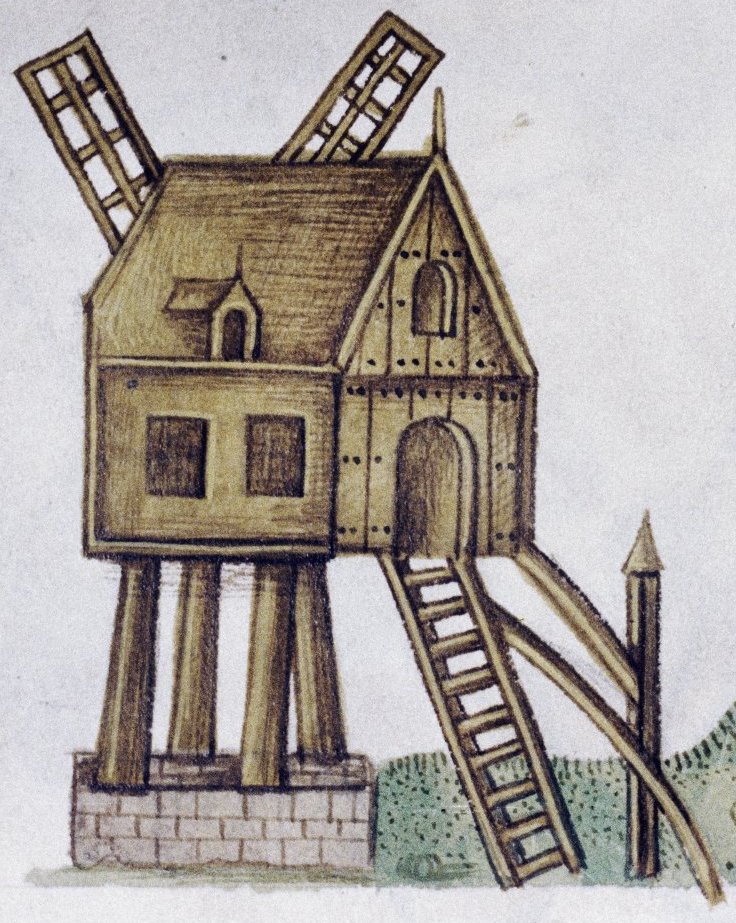
Detail from the ‘Tudor Pattern Book’ (c. 1520-1530), The Bodleian Library, MS Ashmole 1504, fol. 14v.
August 2011. Machinery was simpler in the sixteenth century than it is now, but it could still be dangerous. George Rydyoke was ‘the kep[er] of one wynde mylne’ at Ashby field in Horncastle, Lincolnshire. On 21 August 1559, he was in the upper chamber of the mill, greasing the collar of the axletree, when a sudden gust of wind caused the sails to move and the cogwheel to turn. It caught his clothes, pulled him into the works and ‘sore wounded’ him, breaking his right arm and two of his ribs, so that he died. So far we are finding slightly more watermill than windmill accidents, but by far the most dangerous machine was a cart or wagon: traffic was a killer, then as now.
July 2011. Medical advice in the sixteenth century was against bathing, as it opened the pores and let in disease; much better to change your shirt if you got hot. But working men didn’t have lots of shirts and working in hot weather made it too tempting to strip off and cool down. On 4 July 1558 two men drowned at opposite ends of the Midlands. In Leicestershire a man called Thomas – the jurors didn’t know his surname – who was travelling from Leicester to Loughborough went into the mill dam pond on the River Soar at Quorndon to wash because he was hot but went under water and drowned. In Shropshire a labourer called Richard Chidlowe went into the River Tern to clean and wash himself and met the same fate.
June 2011. Women often did different work from men in early modern England, but some seasonal tasks needed so much labour that everyone joined in. Sheep had to be washed before they could be sheared, and at 11 am on 9 June 1560, Alice Bonde and her sister Katherine were washing sheep in the River Hodder at Slaidburn, in the Pennines in the West Riding of Yorkshire. A wether – a big castrated ram – jumped up and knocked Alice head over heels into a whirlpool. Katherine went after her and John Swinglehirst jumped in from the bank to help. All three, probably weighed down in fast-flowing water by thick woollen and linen clothes and unable to swim, drowned.
May 2011. Sometimes accidents give us a glimpse of the fringes of the great events of Tudor life. May Day was a time for celebration, and at court the celebration was lavish. On 1 May 1559, the first May Day of her reign, entertainments were put on for Queen Elizabeth. She was staying at Whitehall Palace and there were firework displays on the River Thames. John Penne, mariner, was on a boat taking part. A small barrel of gunpowder caught fire and his face was burnt. Fearing a bigger explosion, he and his crew-mates rushed to the other side of the boat. The boat overturned and he drowned. Whether the accident was allowed to spoil the queen’s fun we don’t know.
April 2011. We know little about William Shakespeare’s family beyond his parents, siblings and children. At about 8 pm on 16 June 1569 at Upton Warren in Worcestershire, about 20 miles from Stratford upon Avon where William was growing up, a two-and-a-half-year-old girl fell into the mill pond and drowned while picking flowers called ‘yelowe boddles’ (corn marigolds). Her name was Jane Shaxspere. Was she William’s cousin; perhaps even the model for Ophelia in Hamlet? We don’t know. But the accident certainly tells that the everyday tragedies of Shakespeare’s time can help to set his plays in their original context.
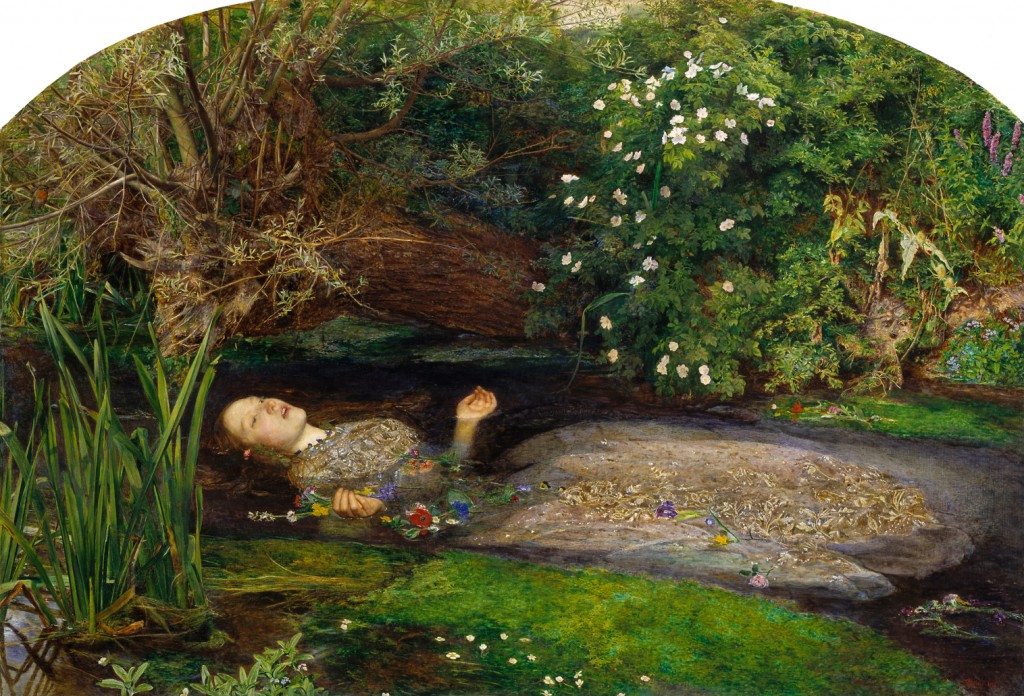
Ophelia by John Everett Millais (1852), Tate Gallery.

